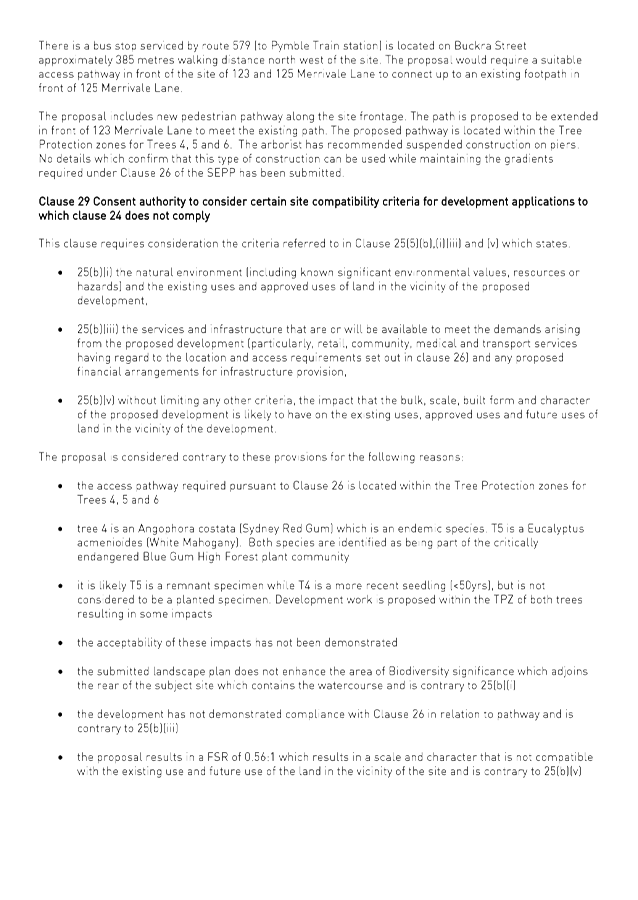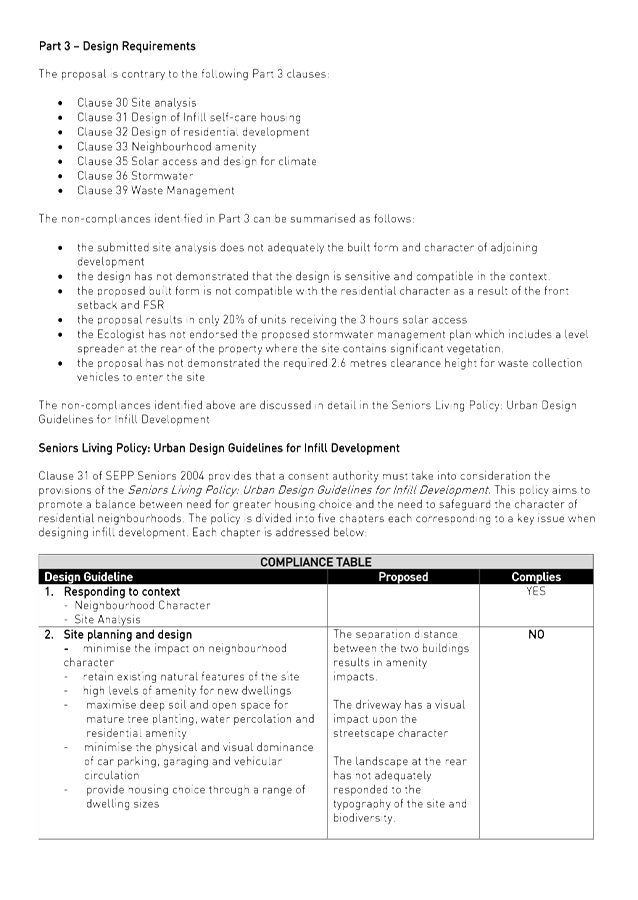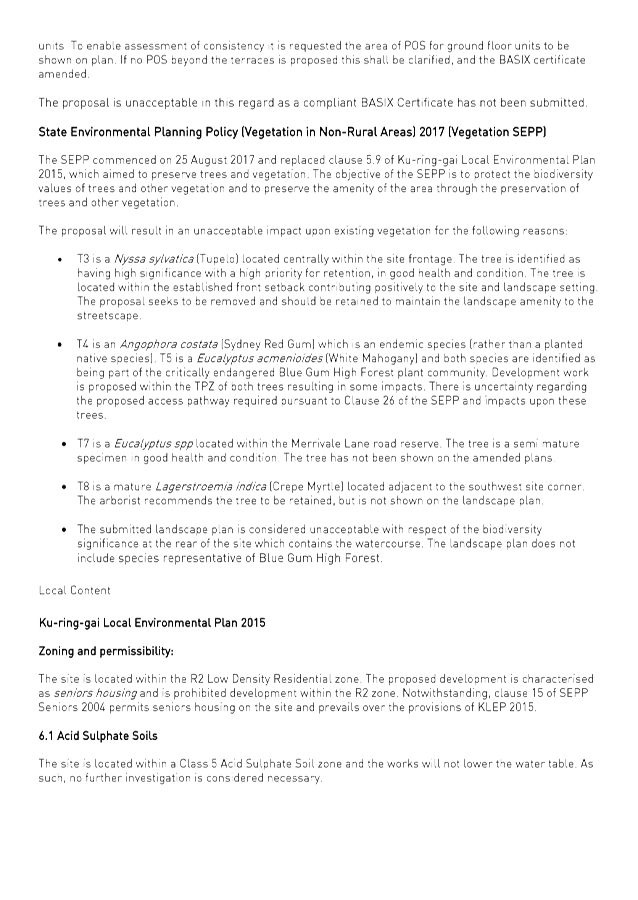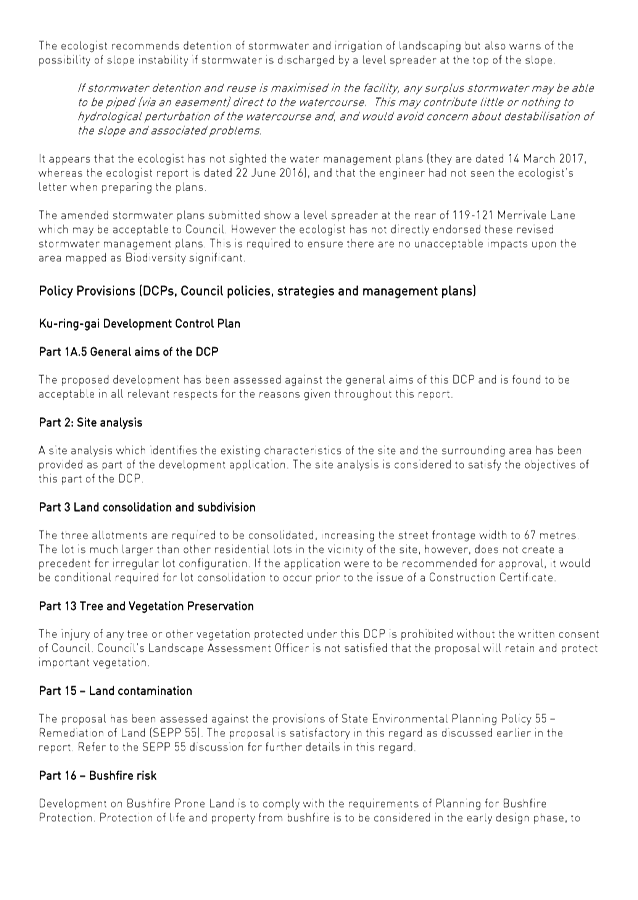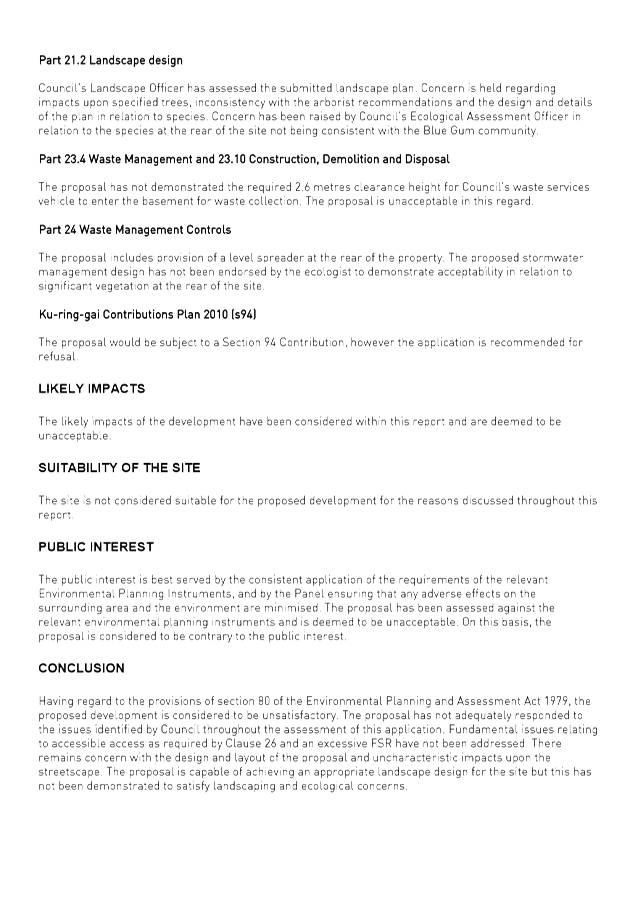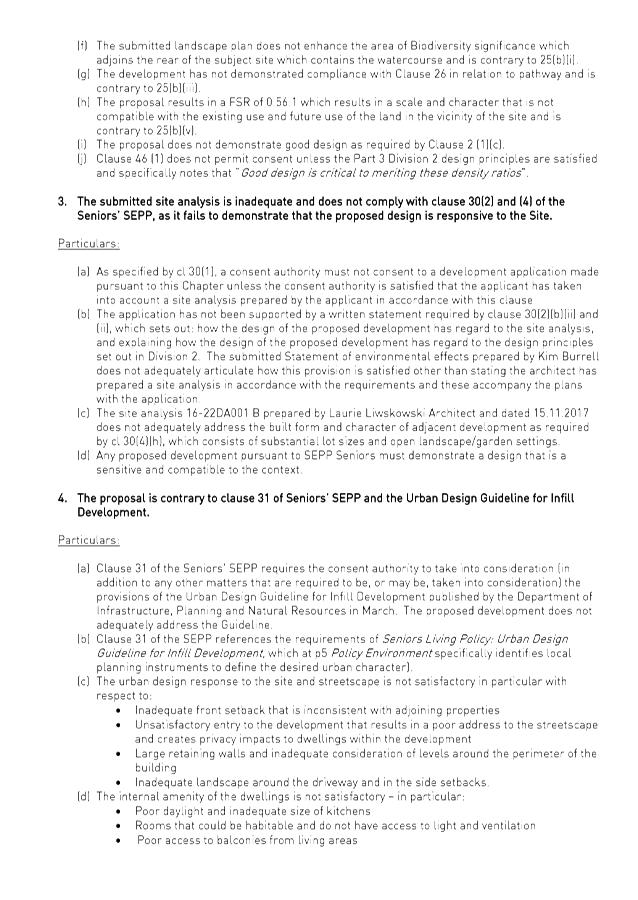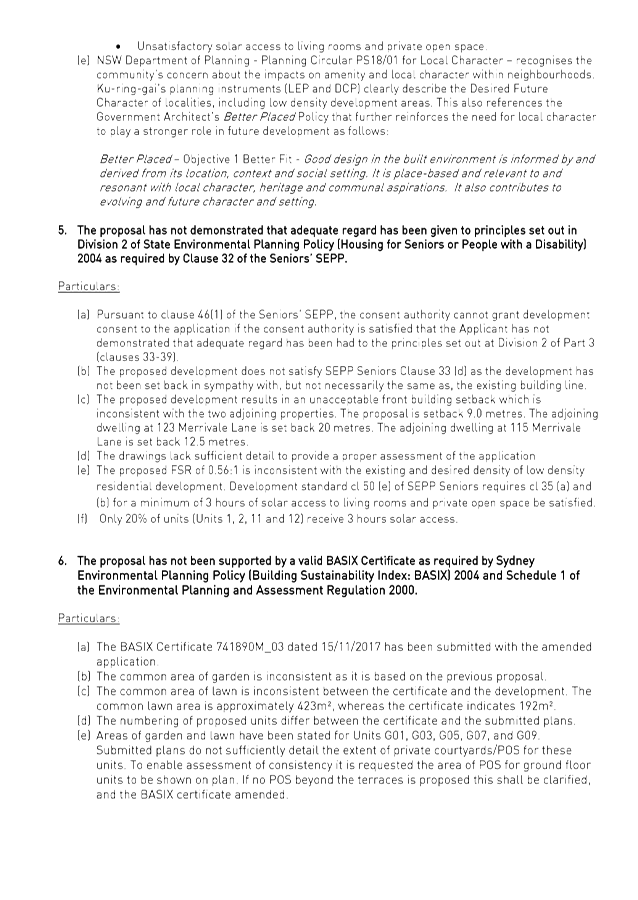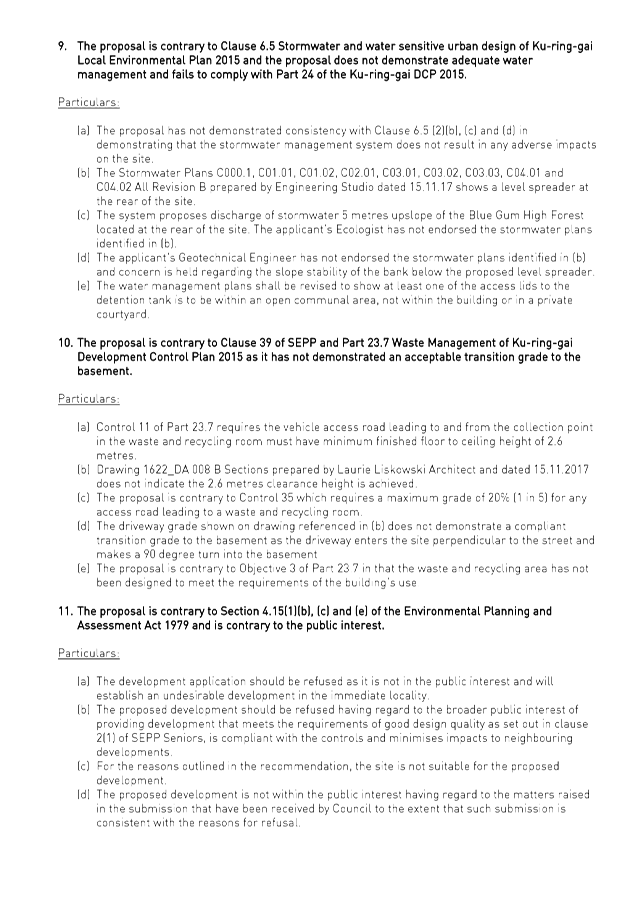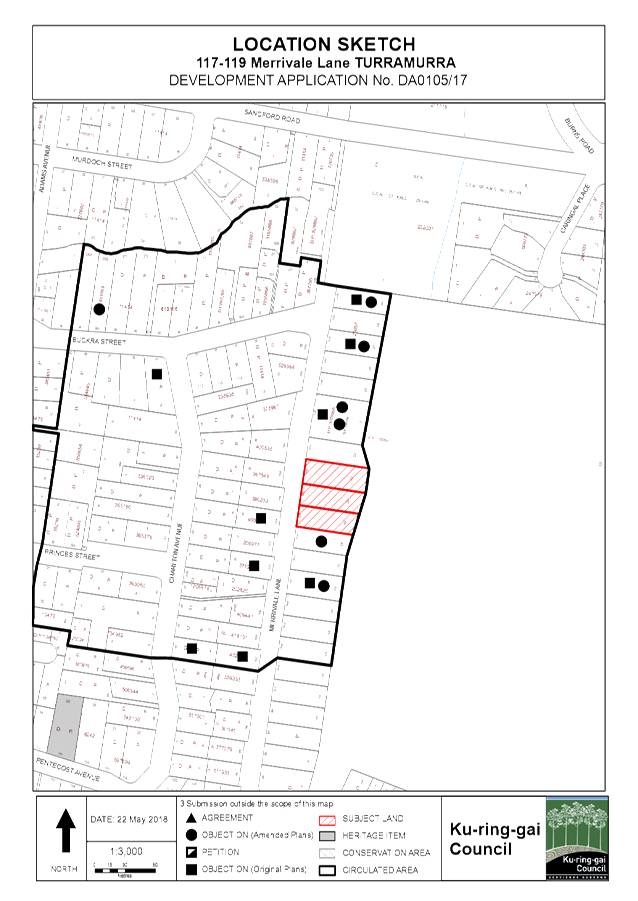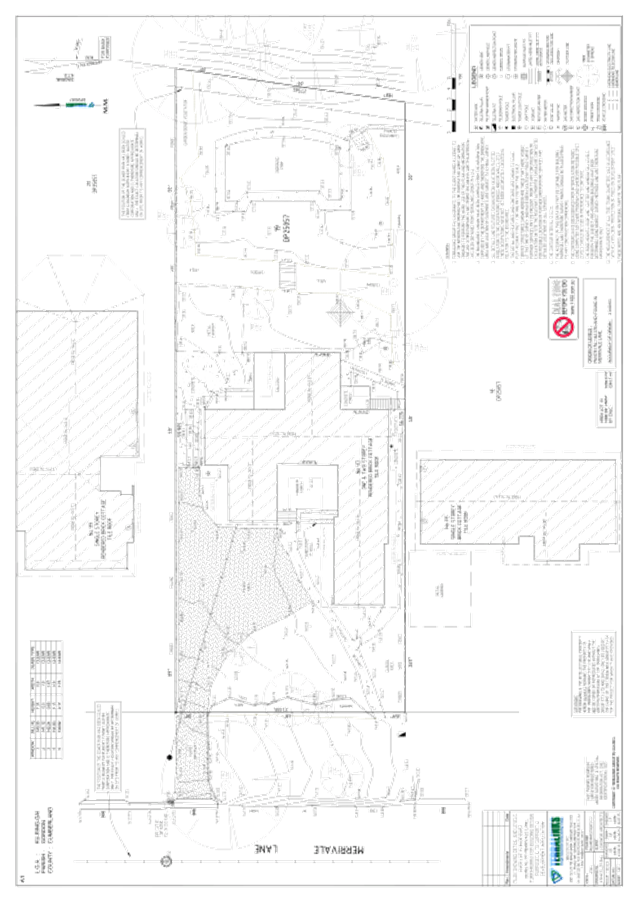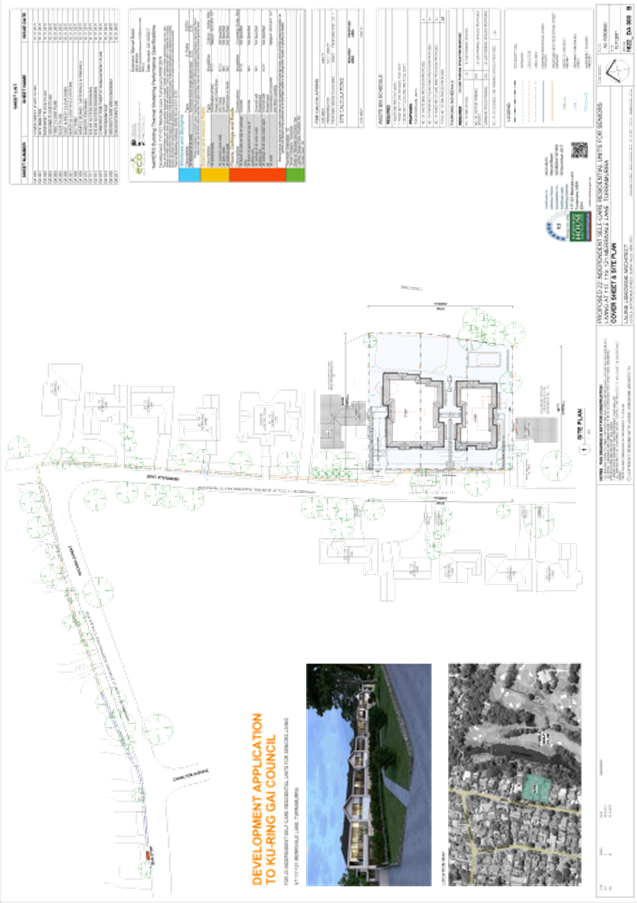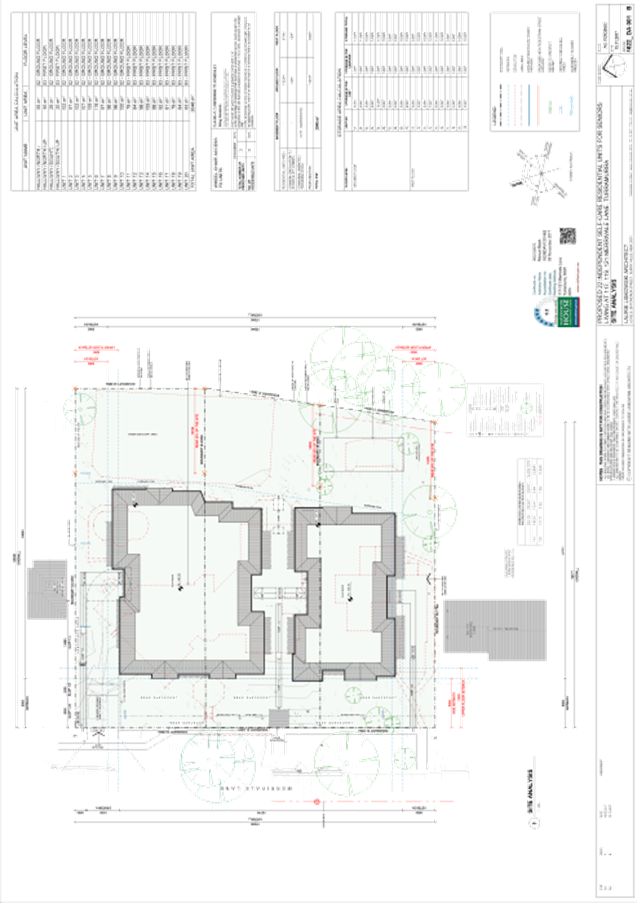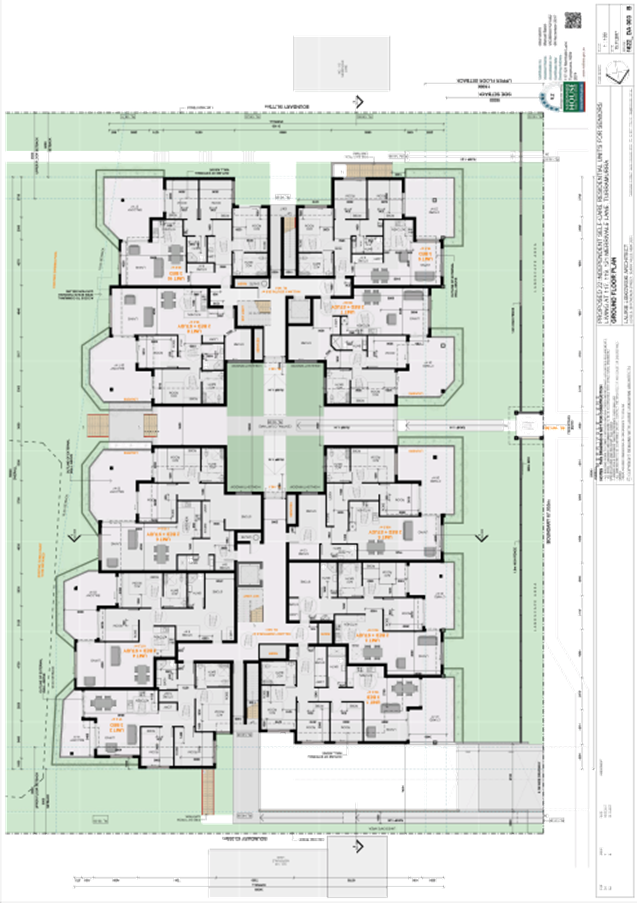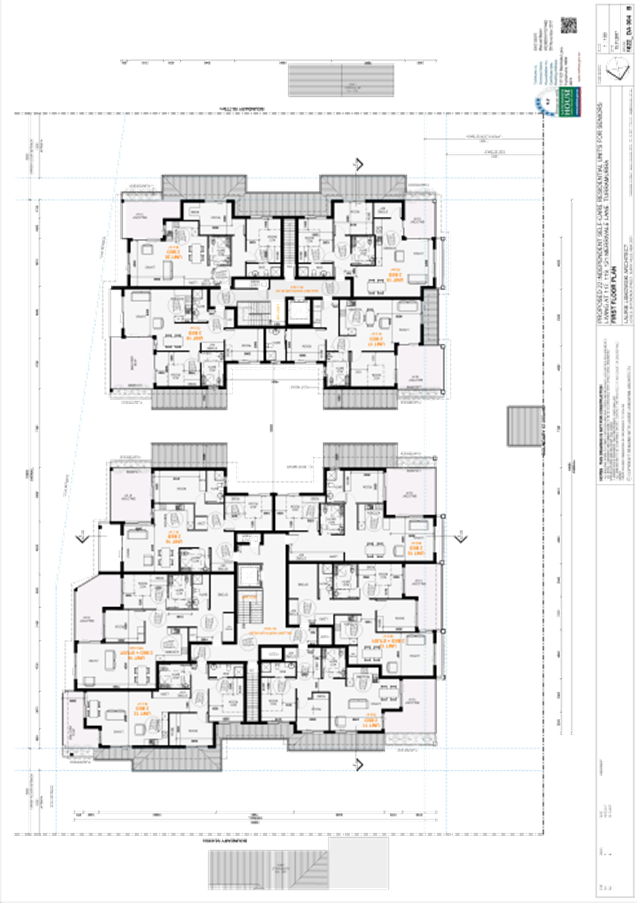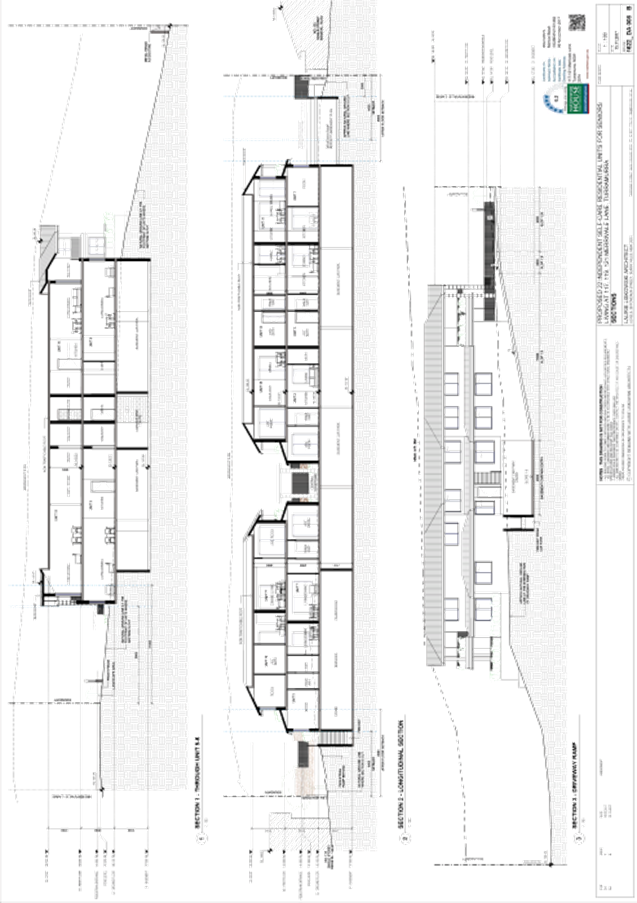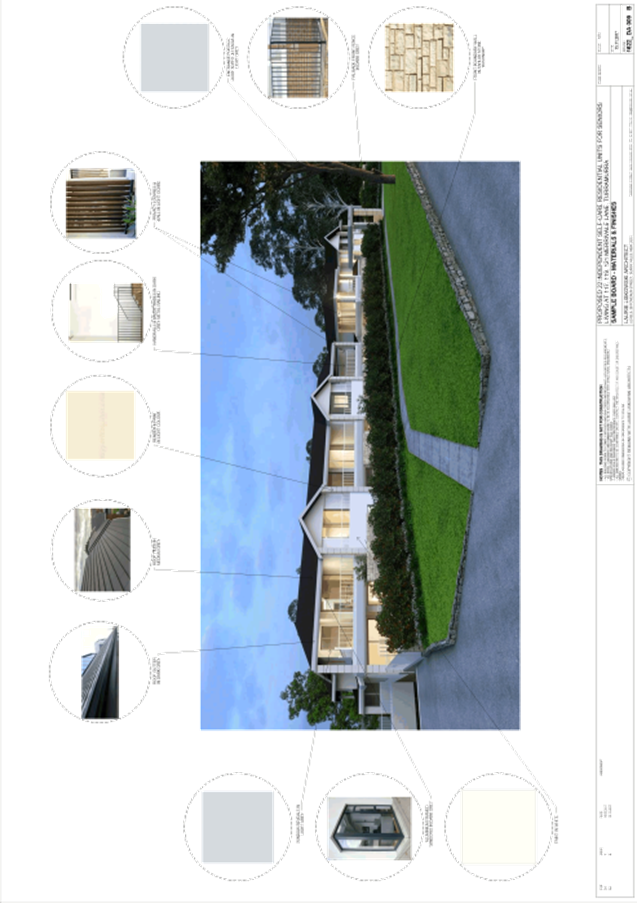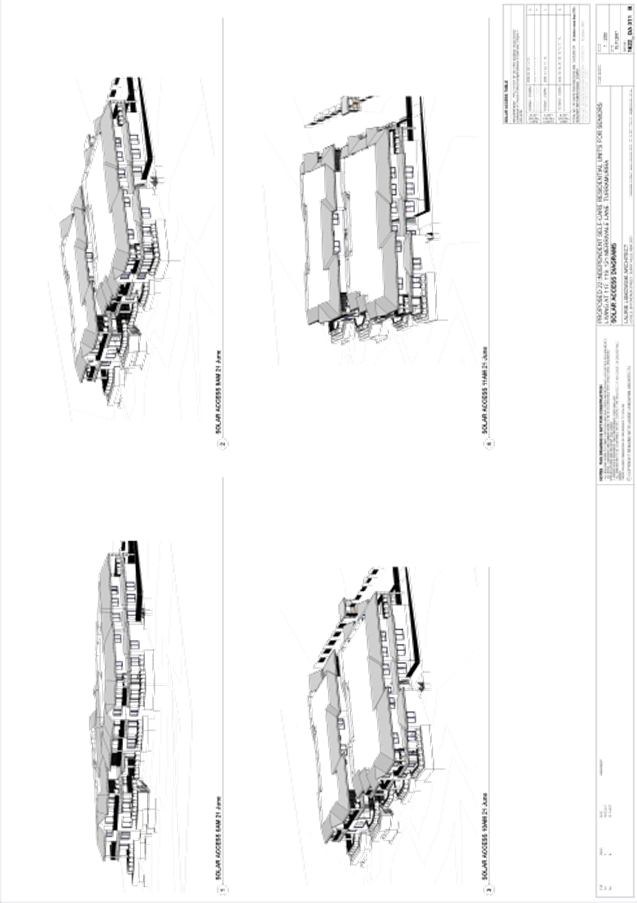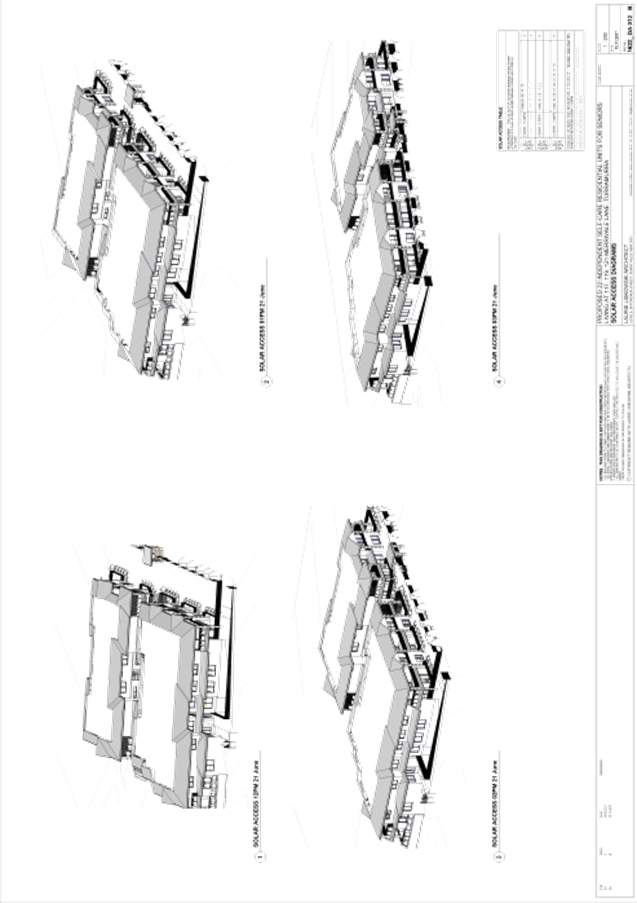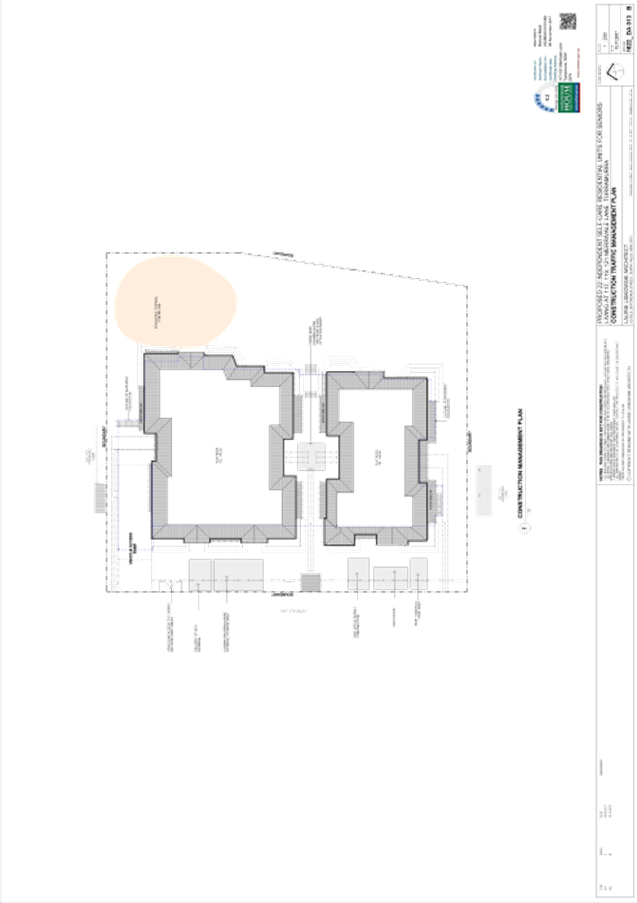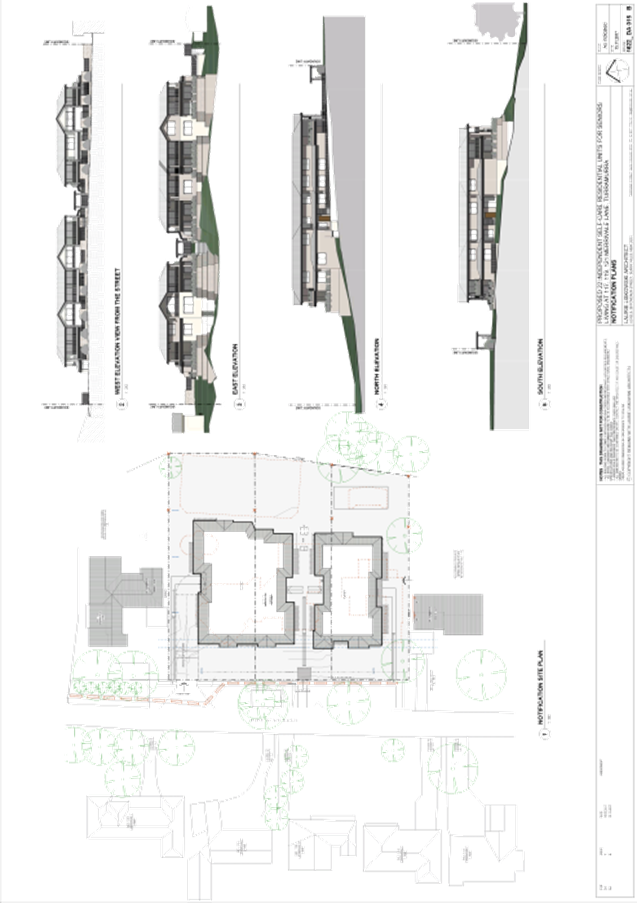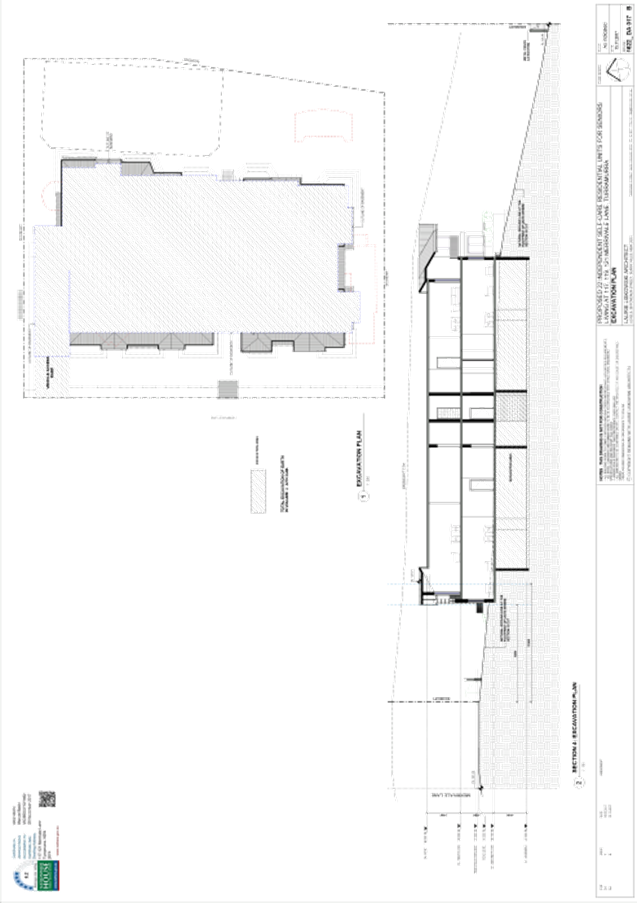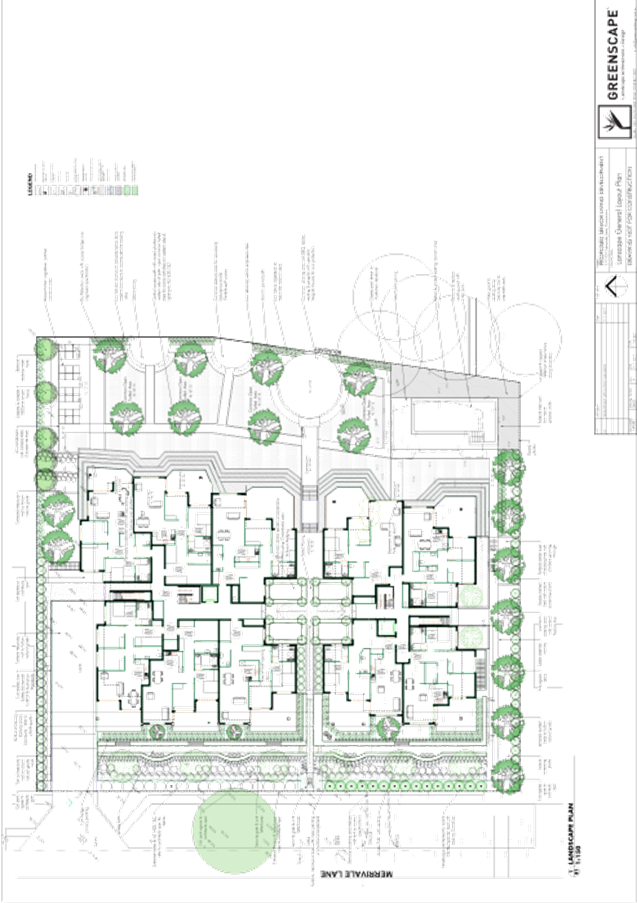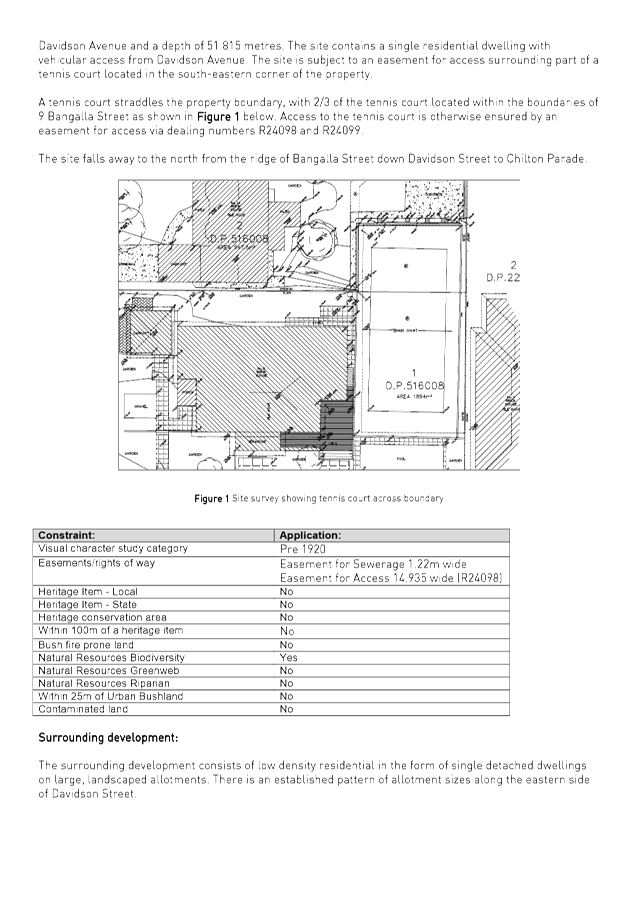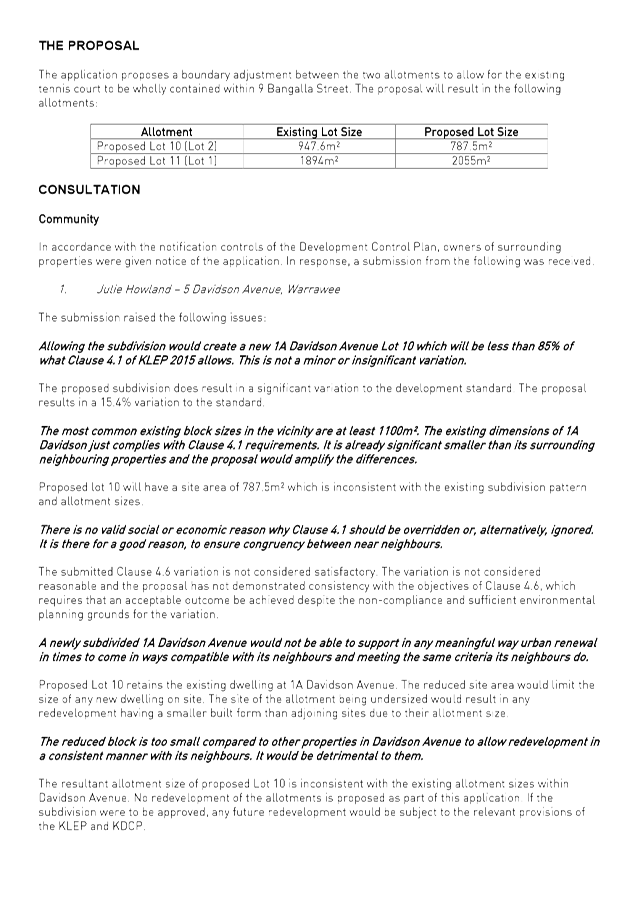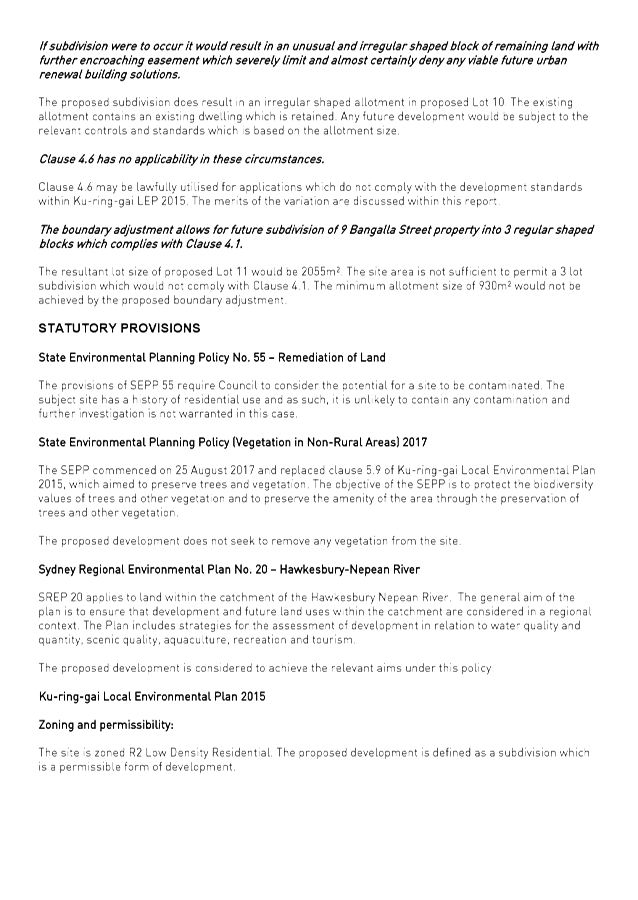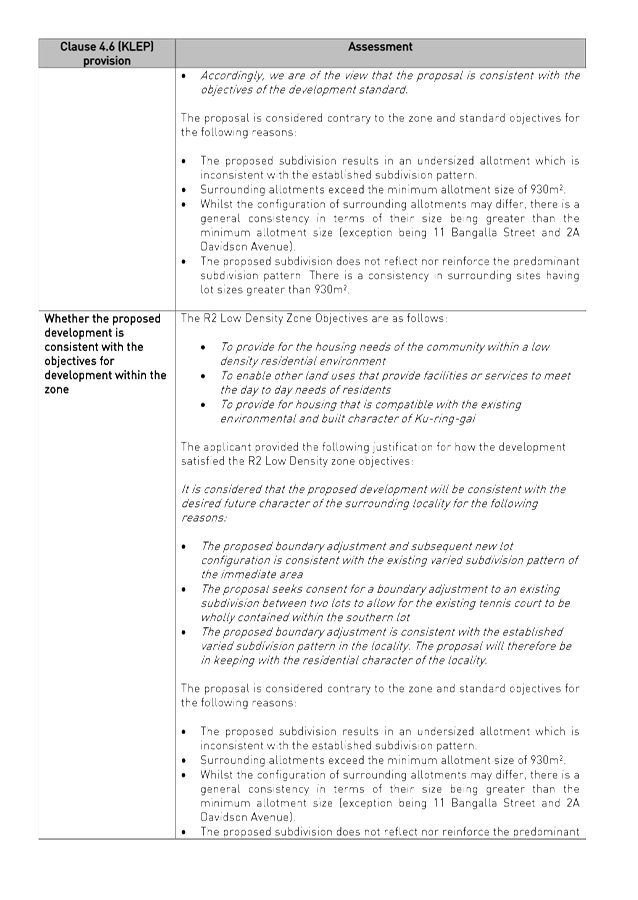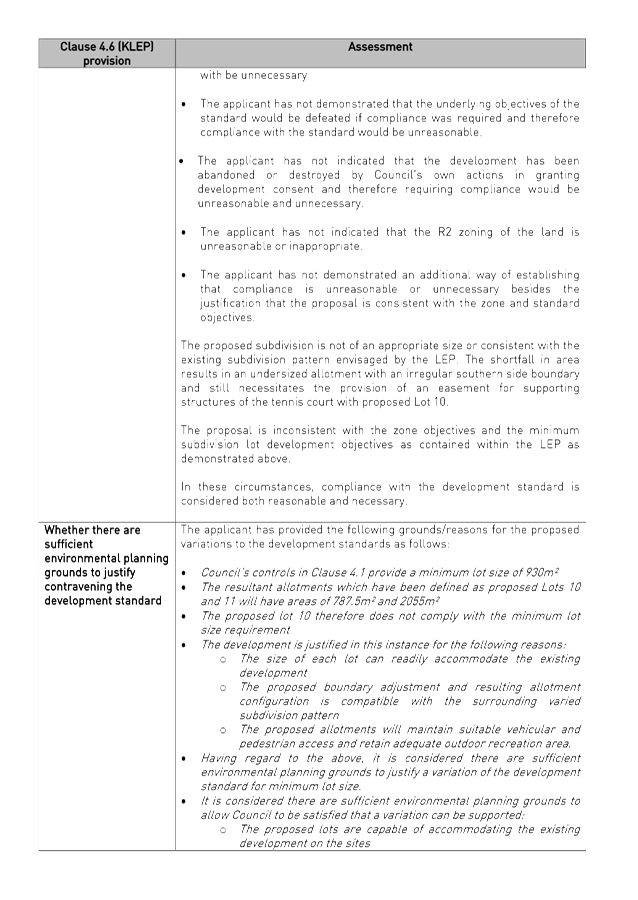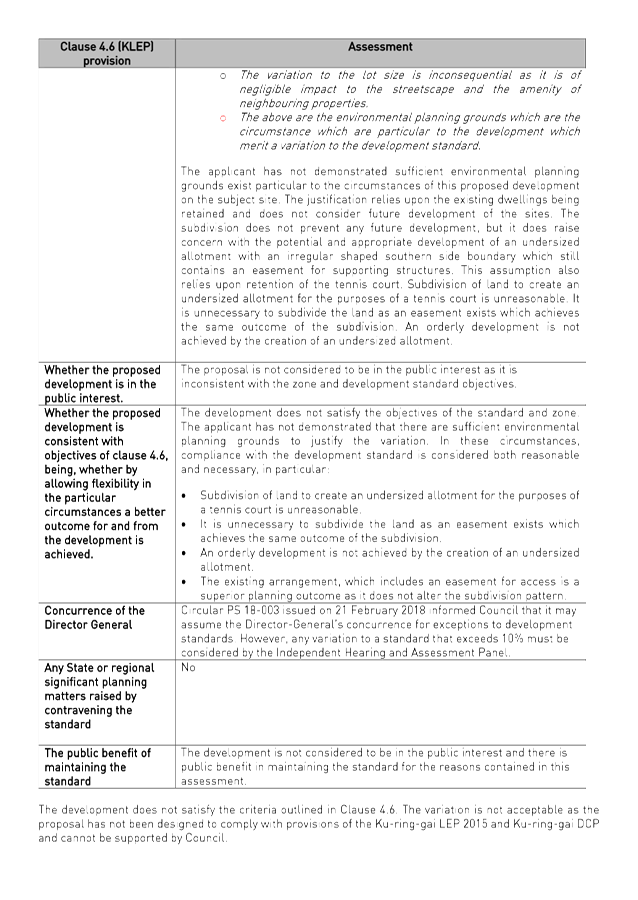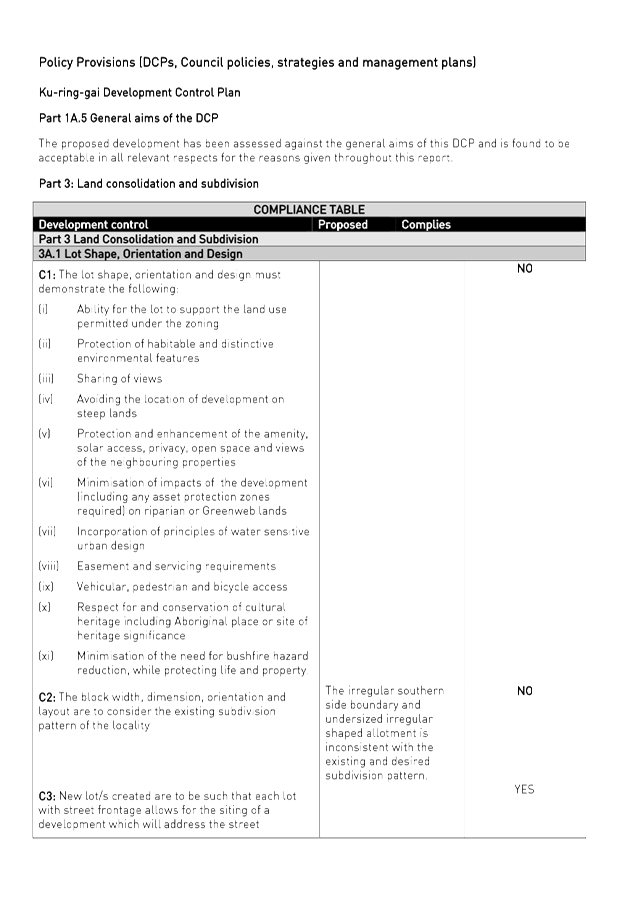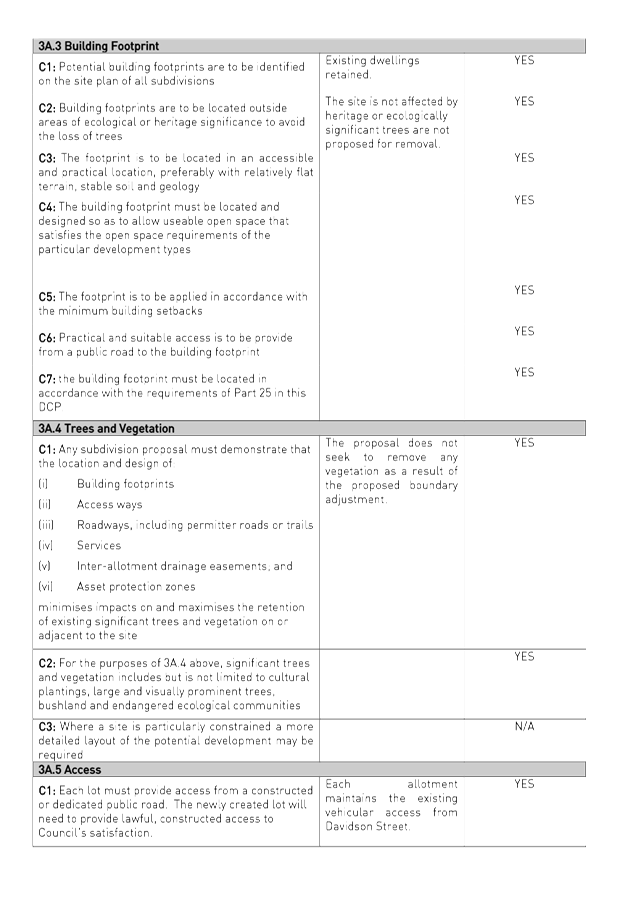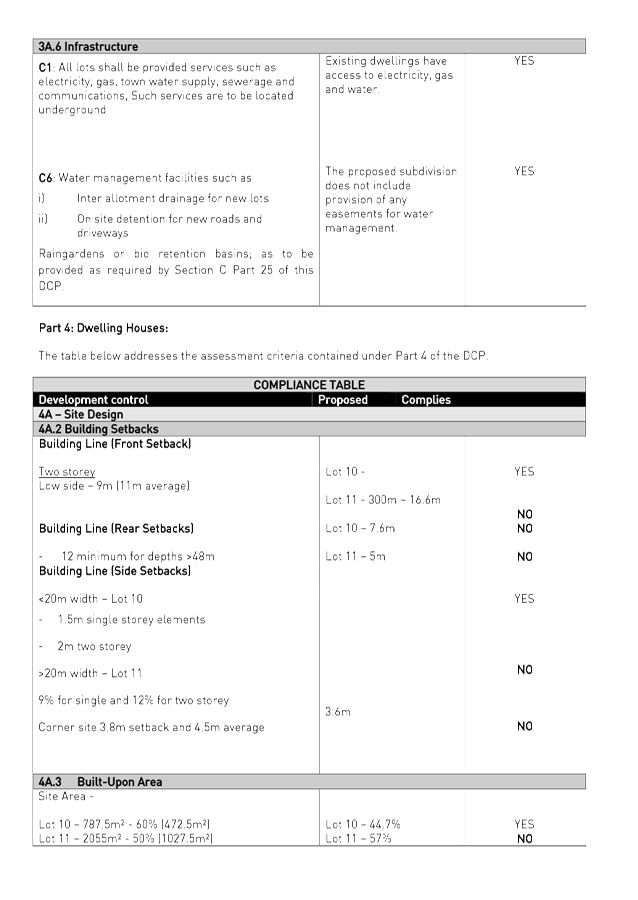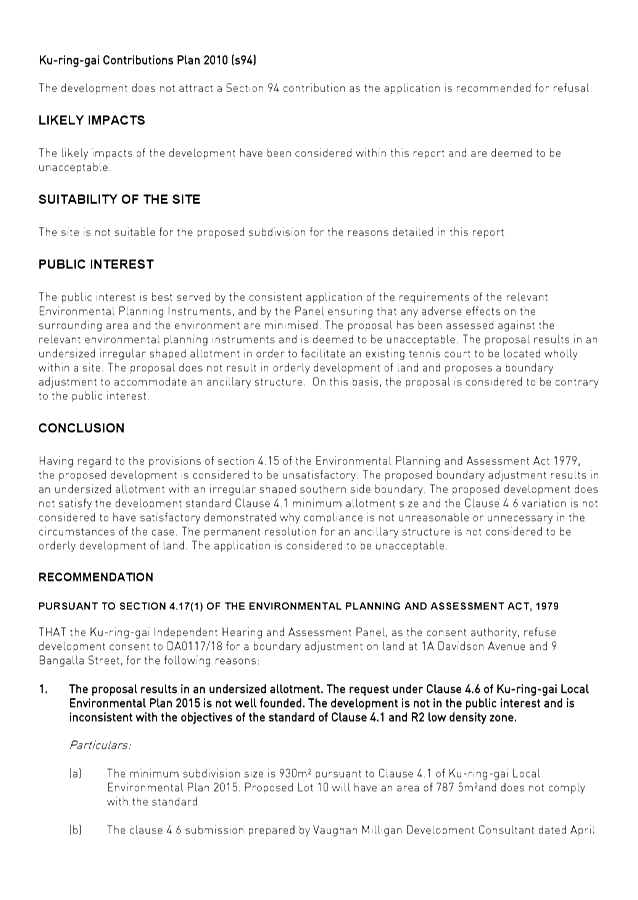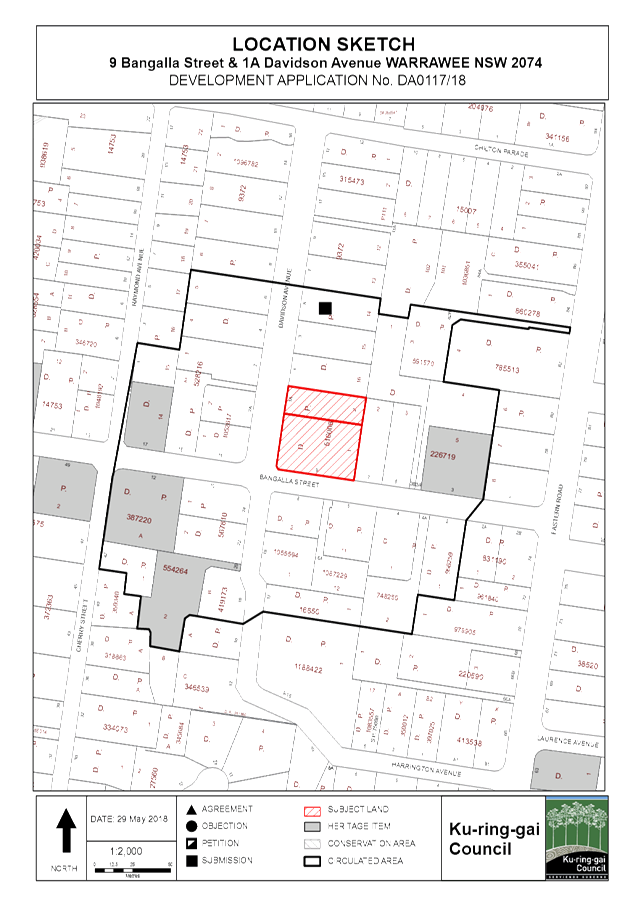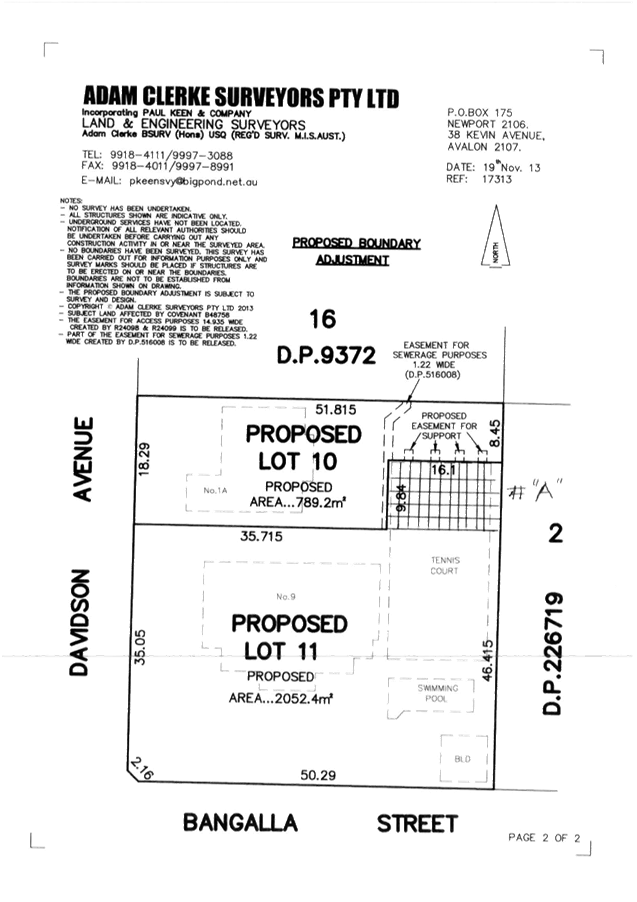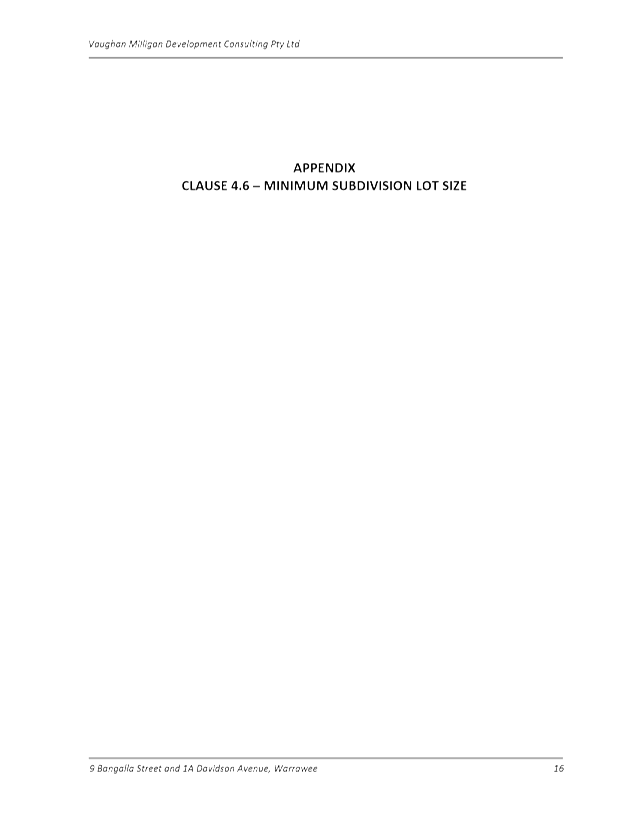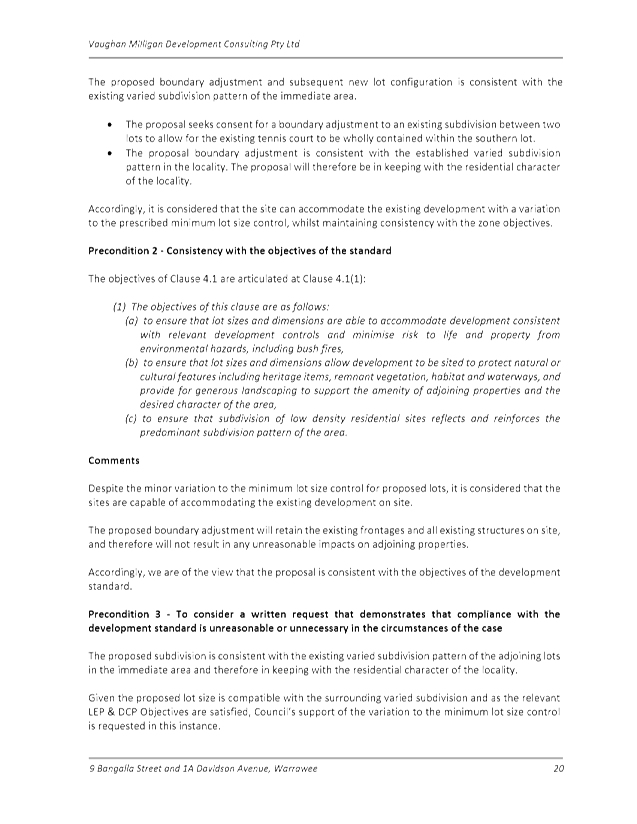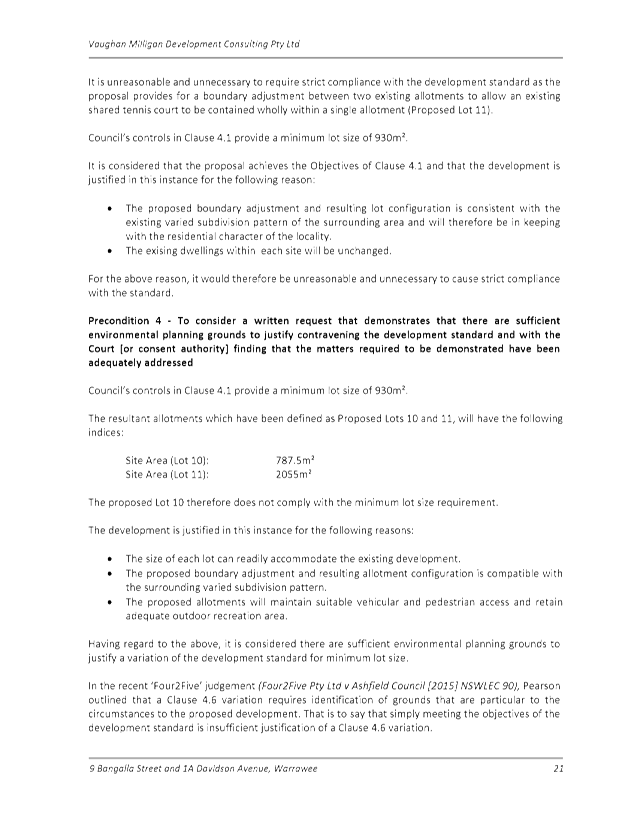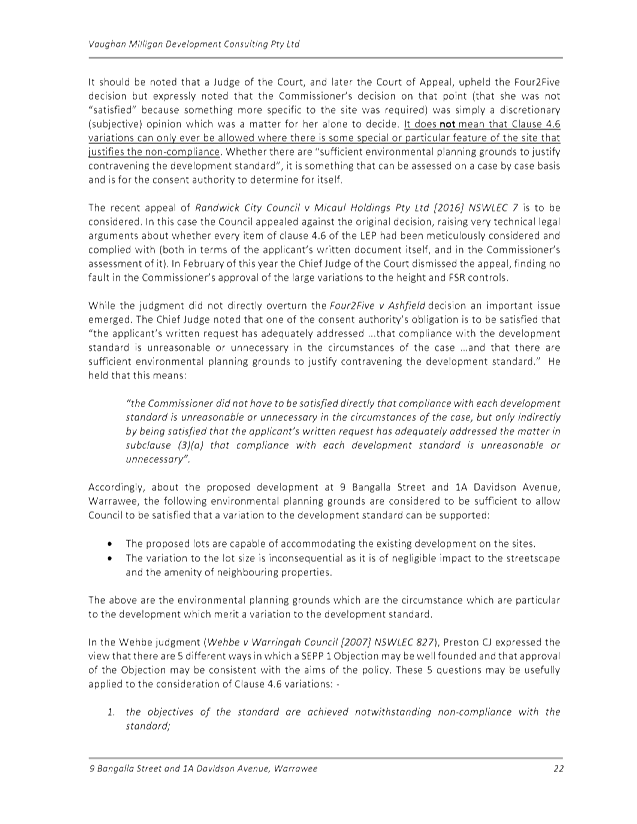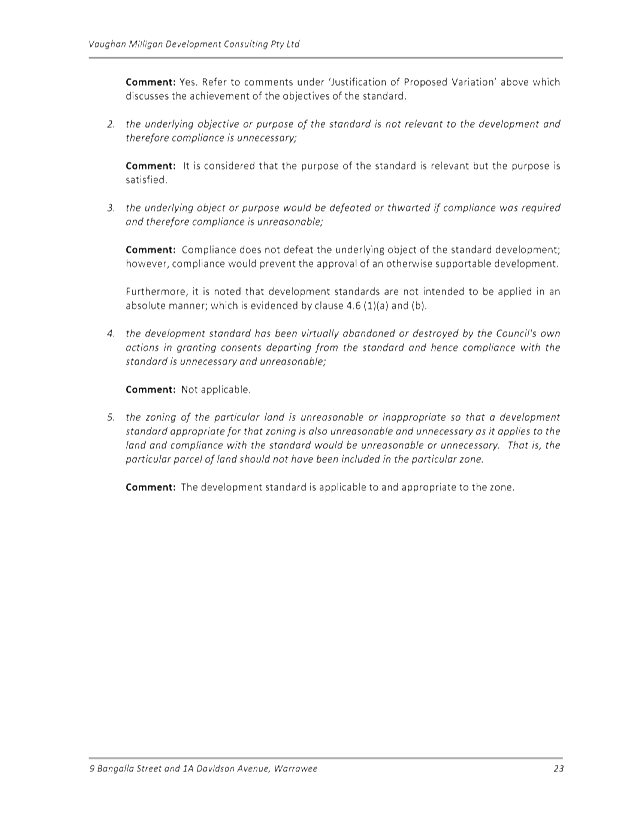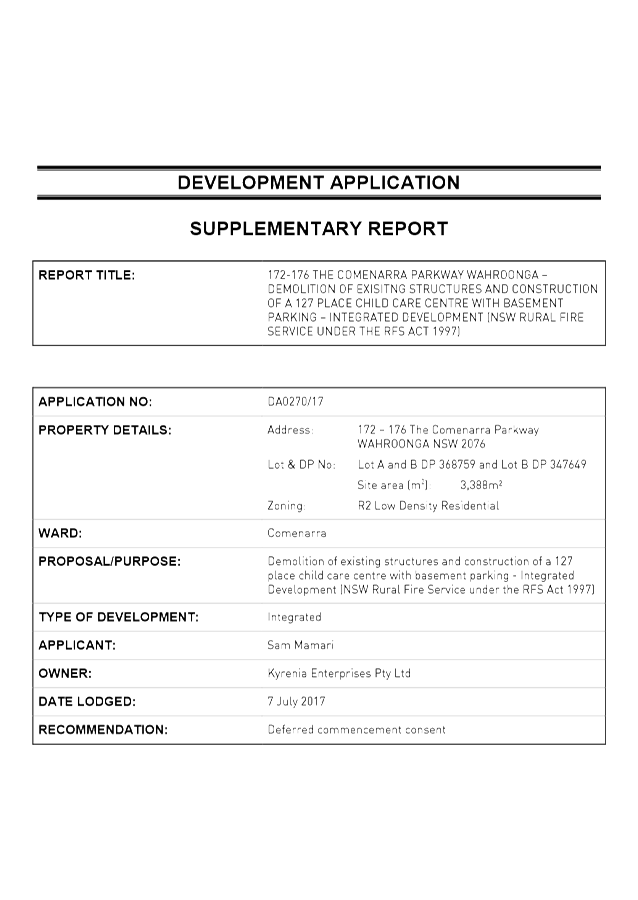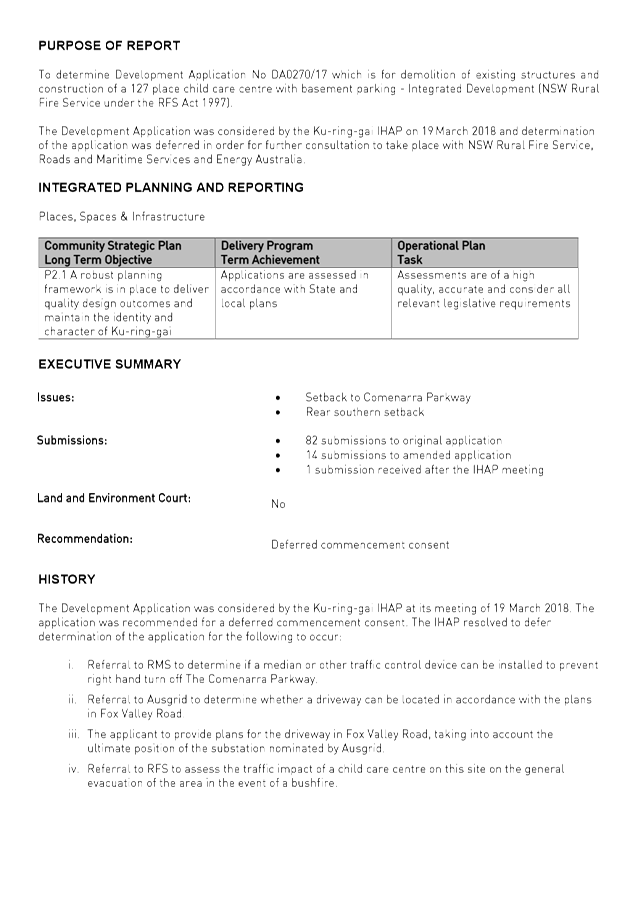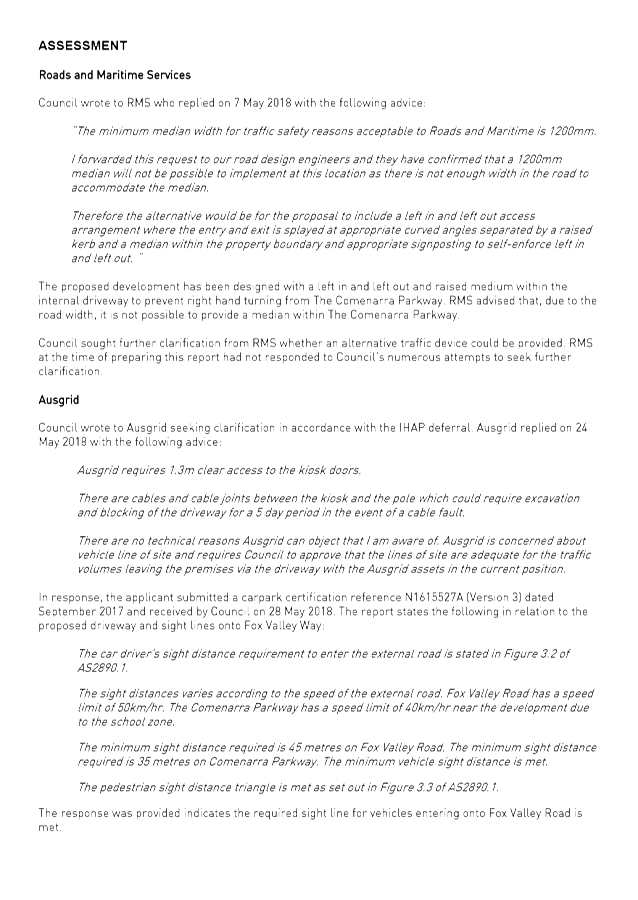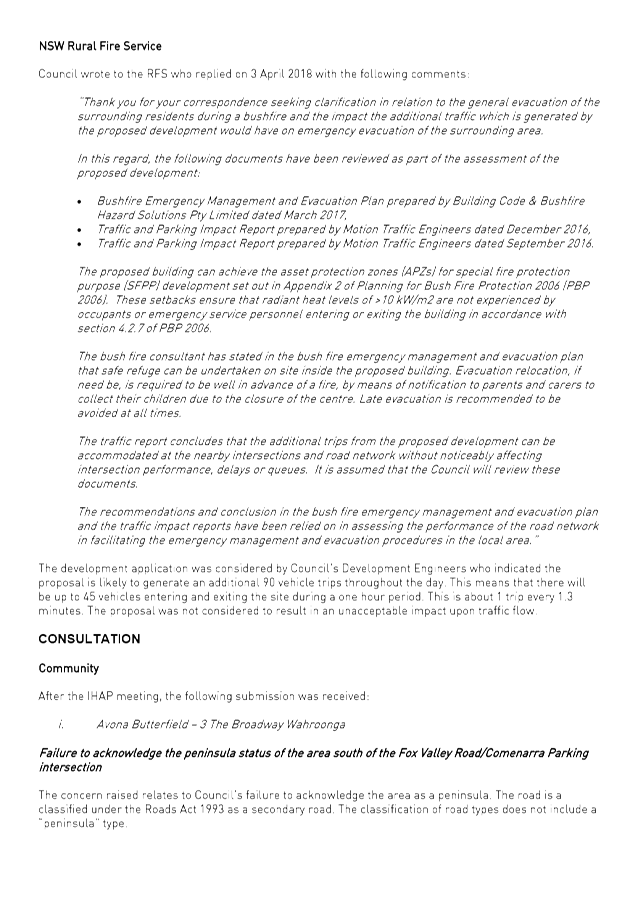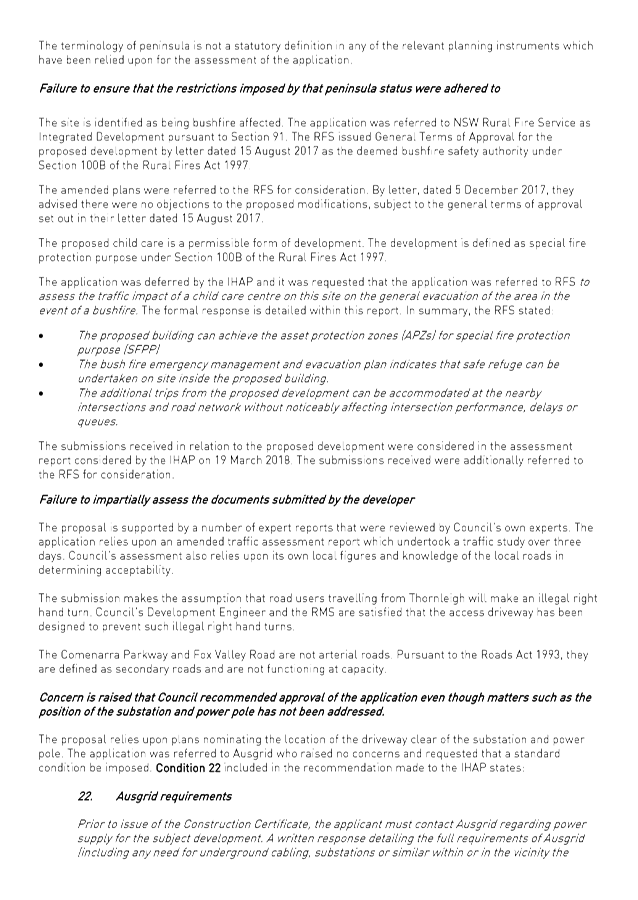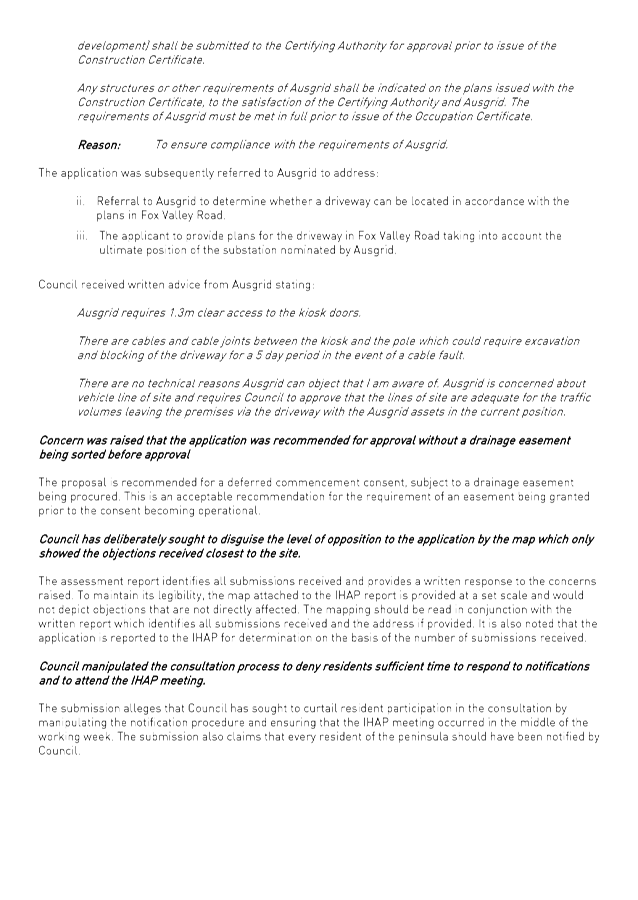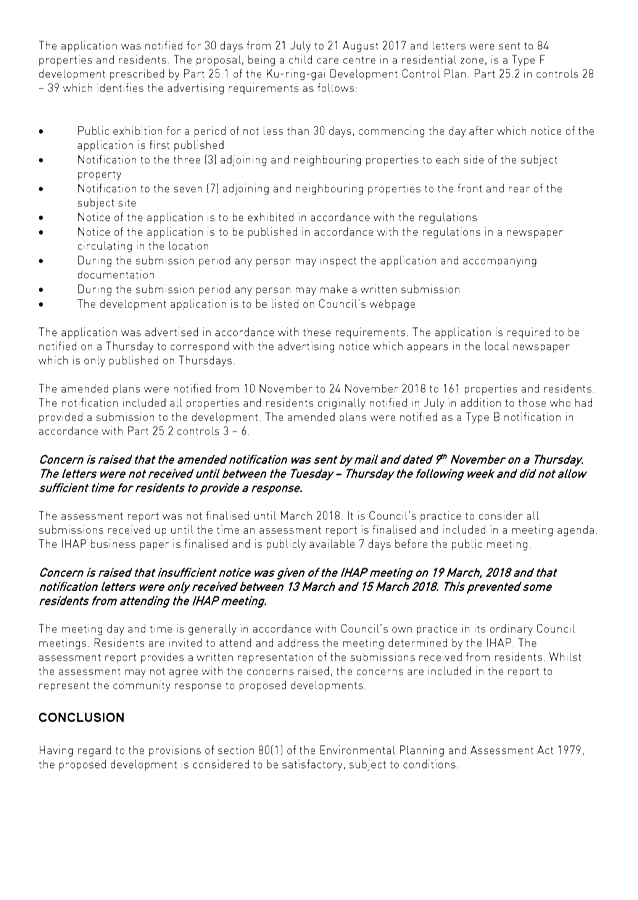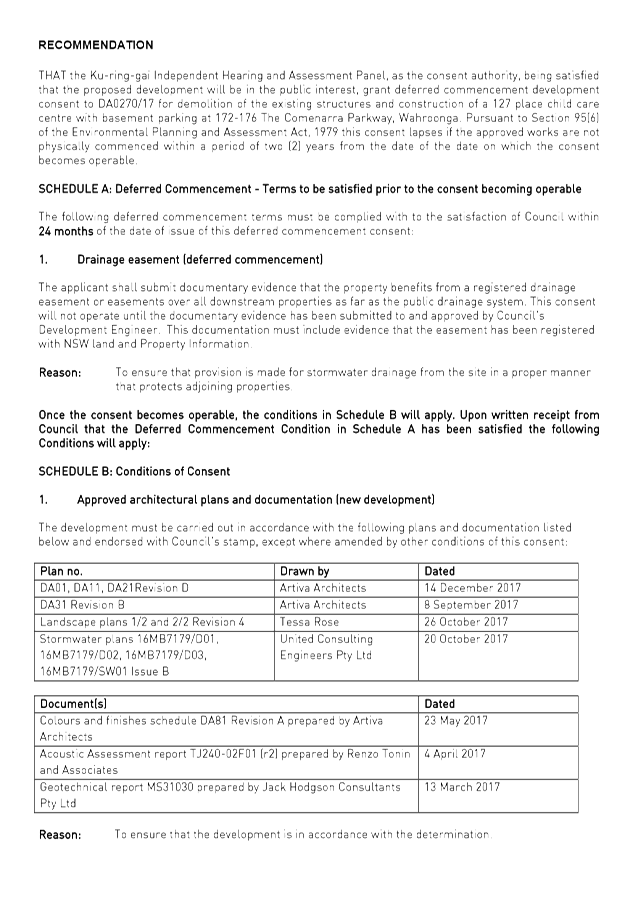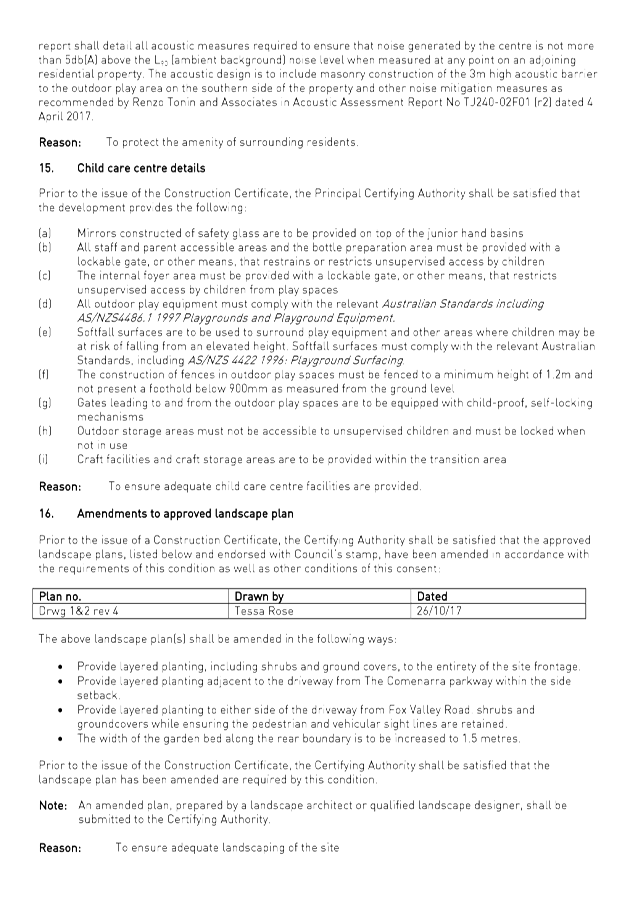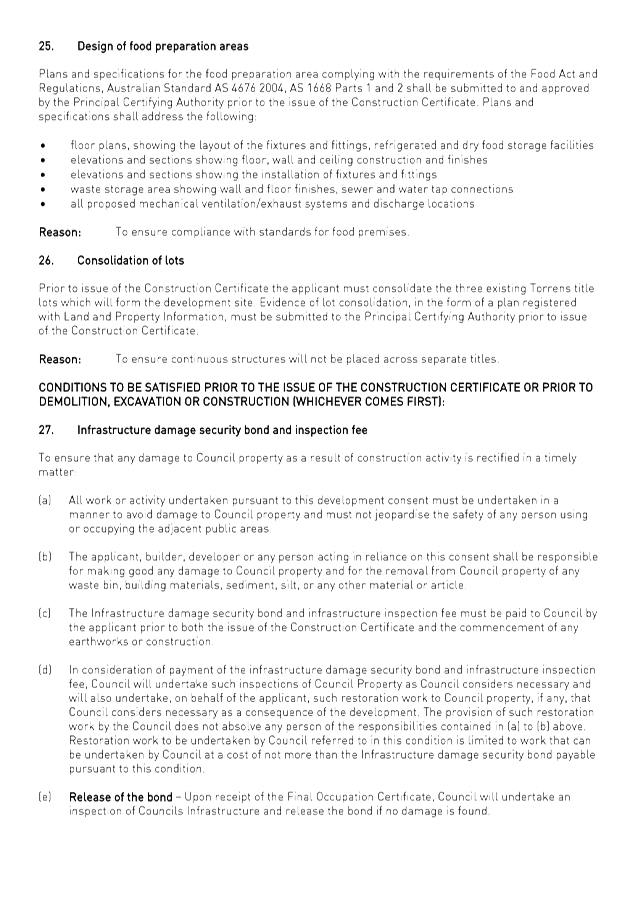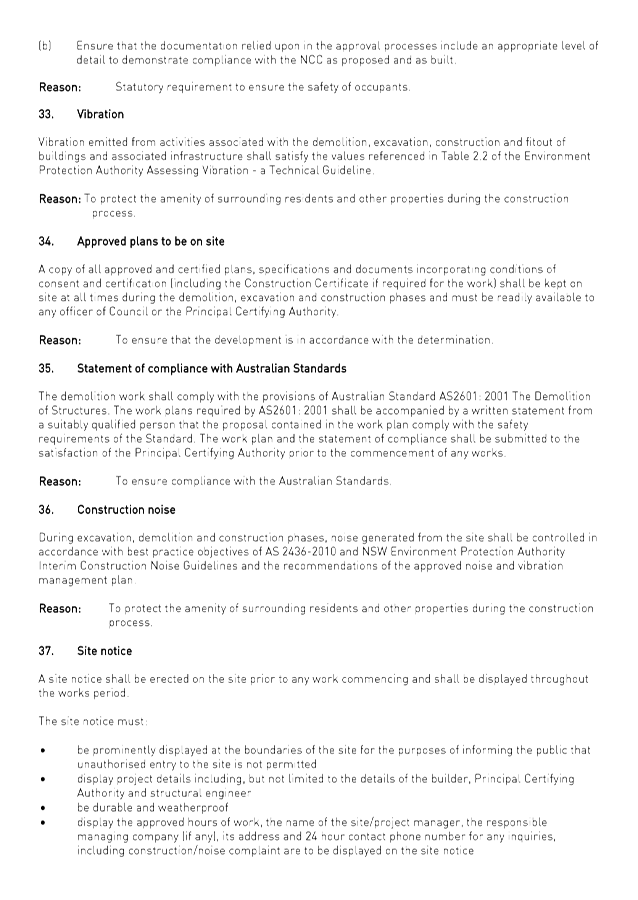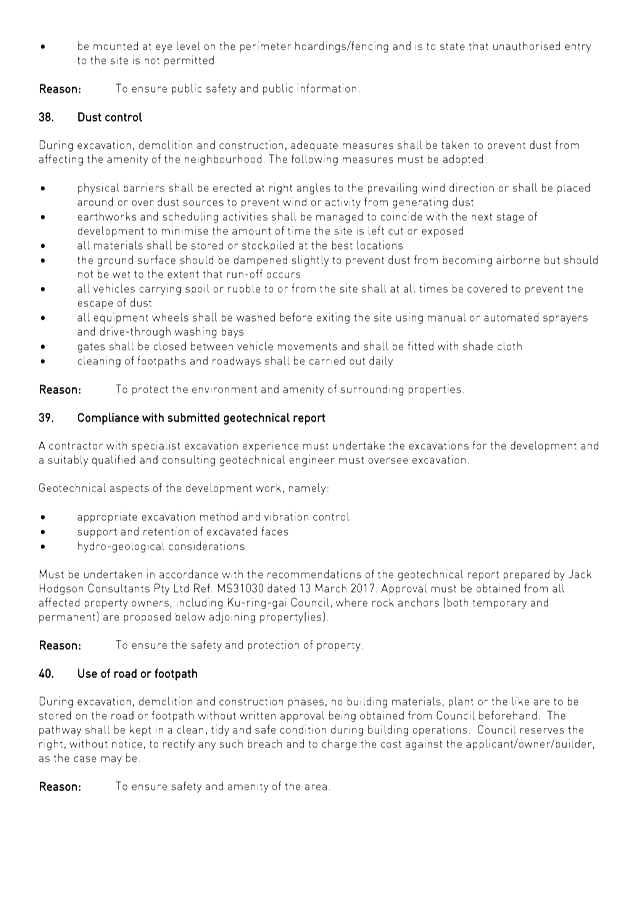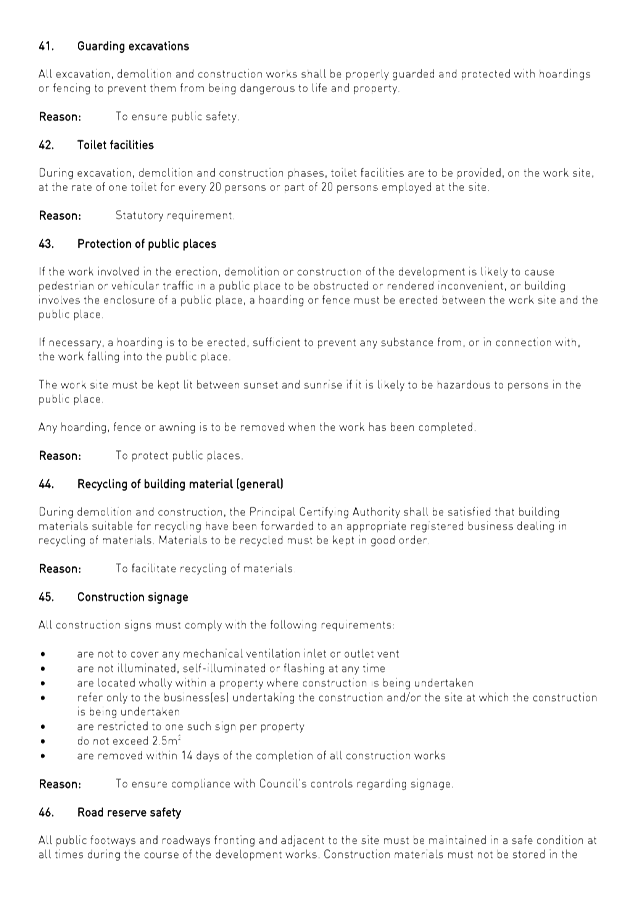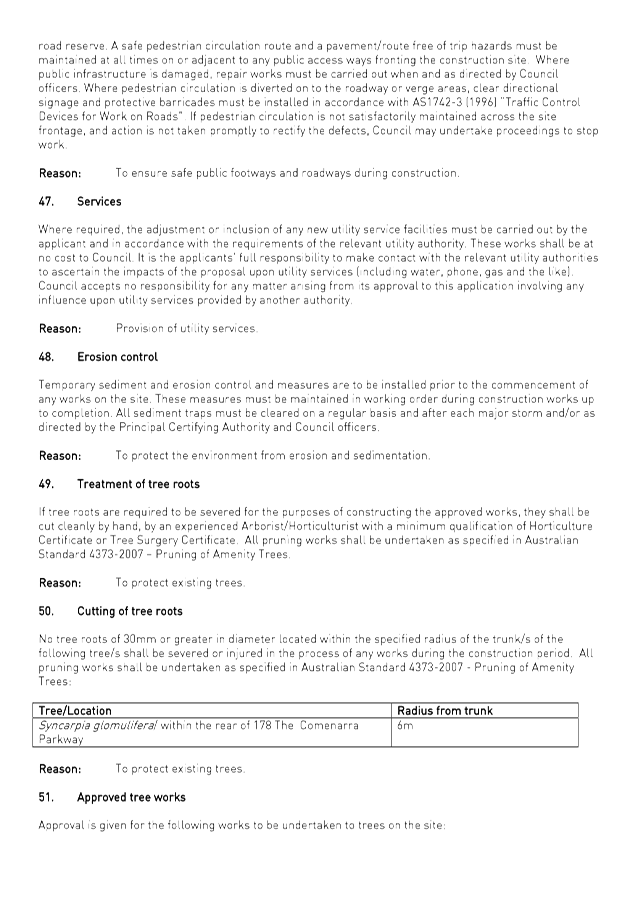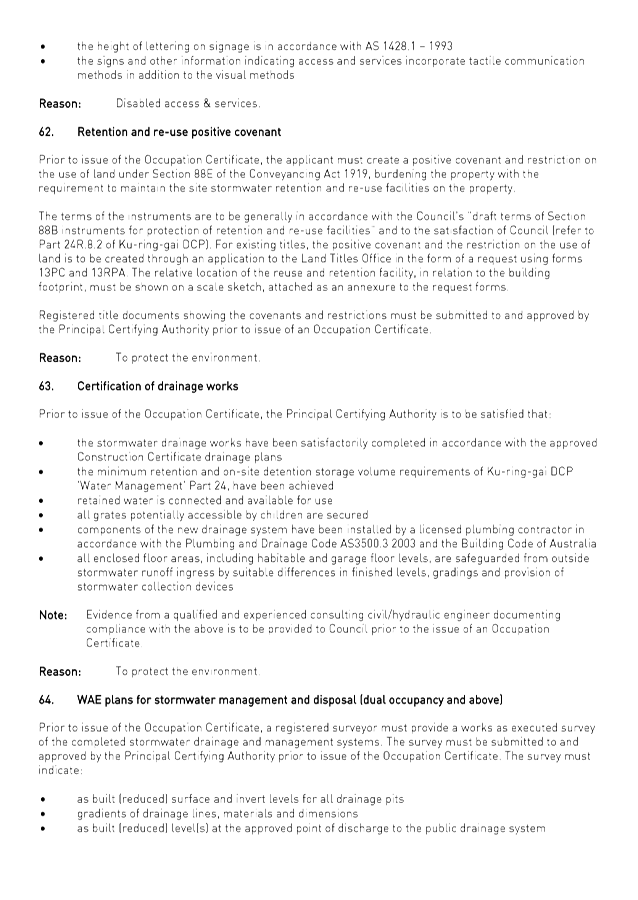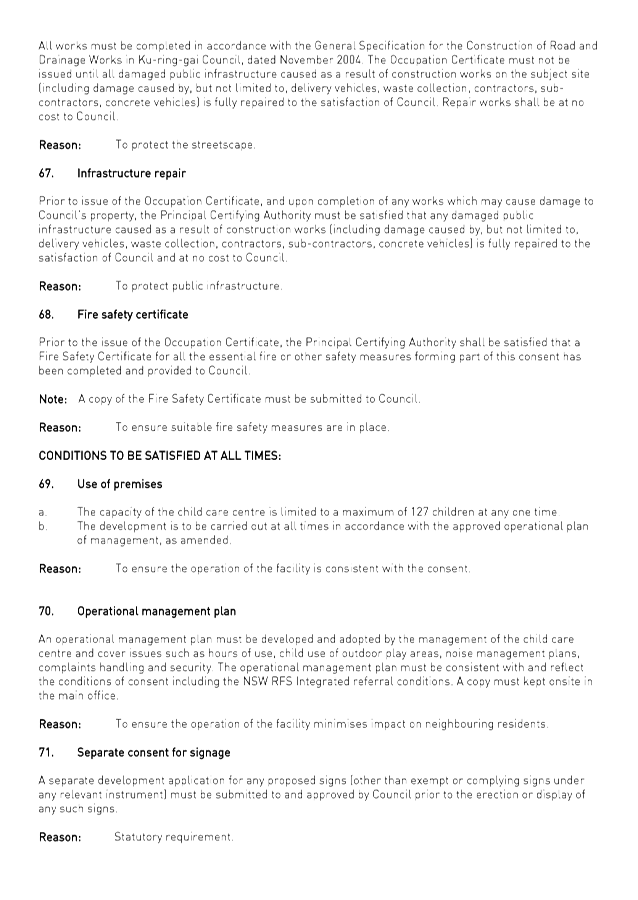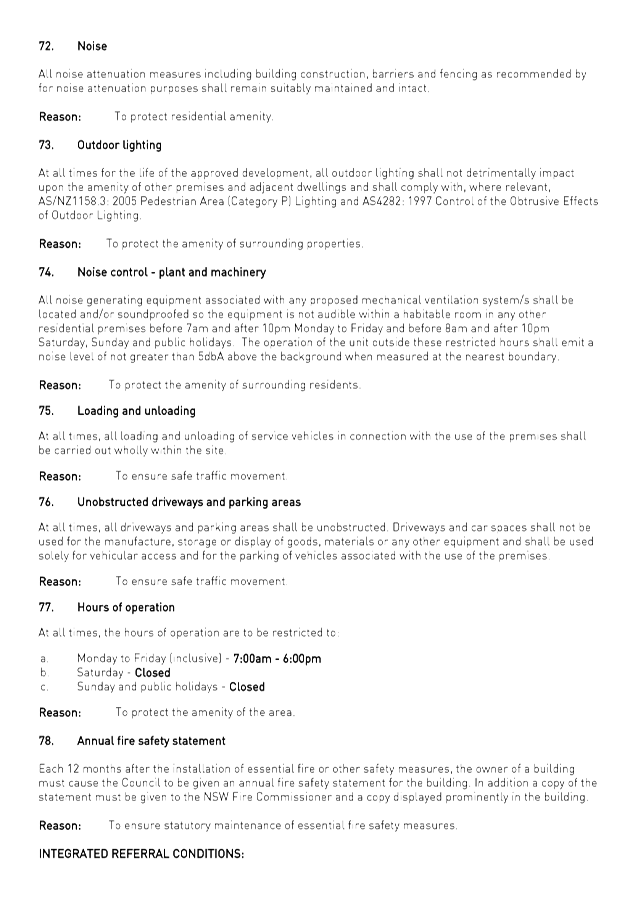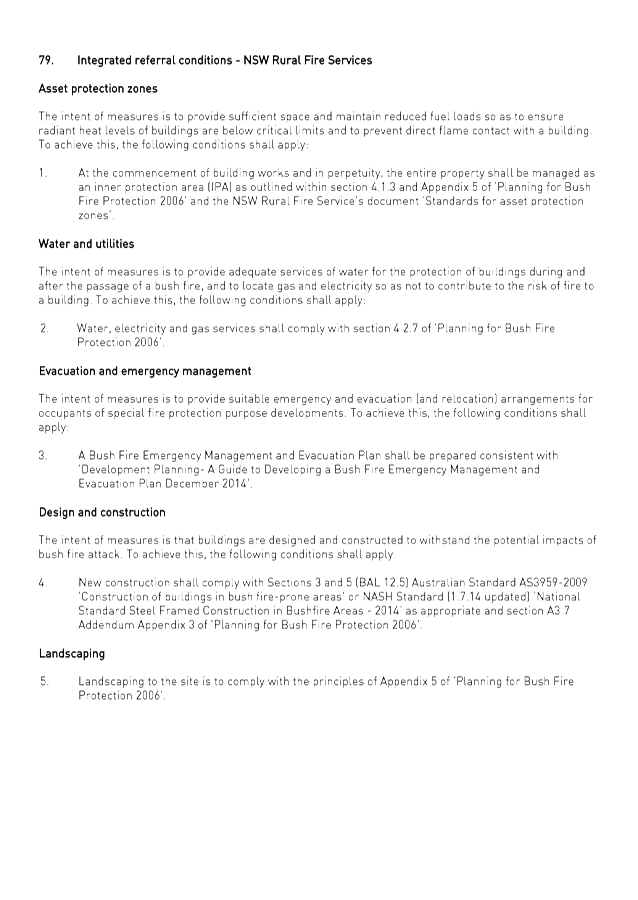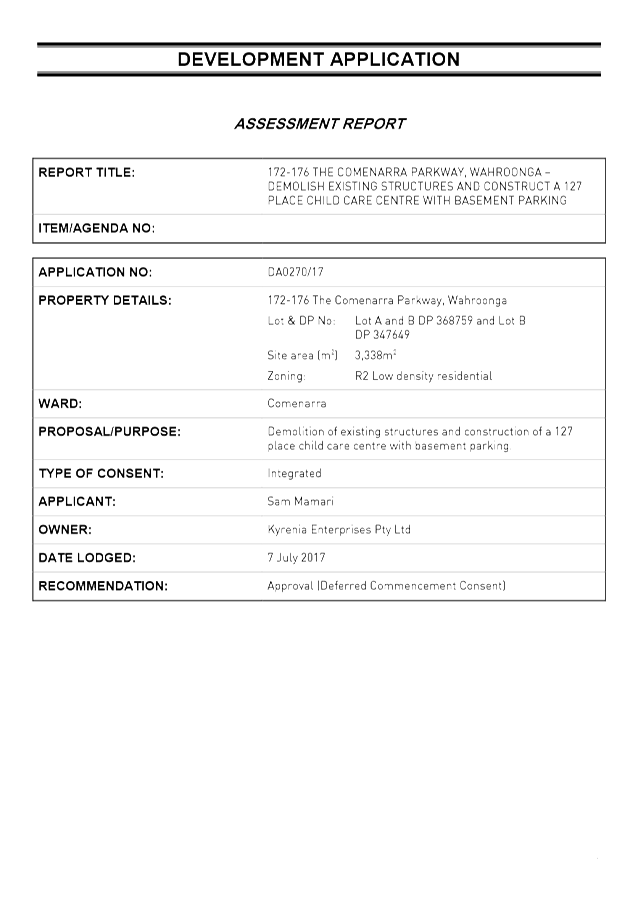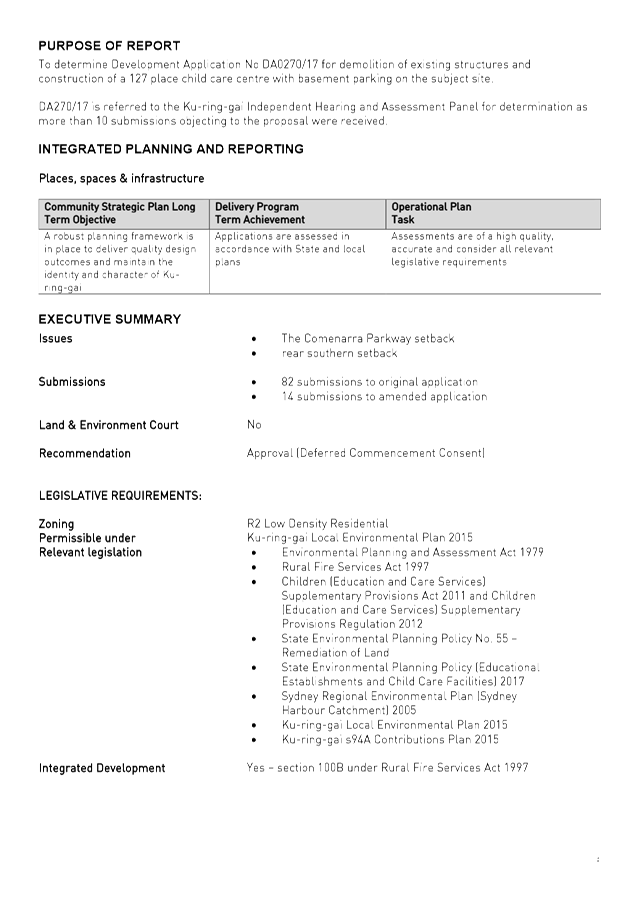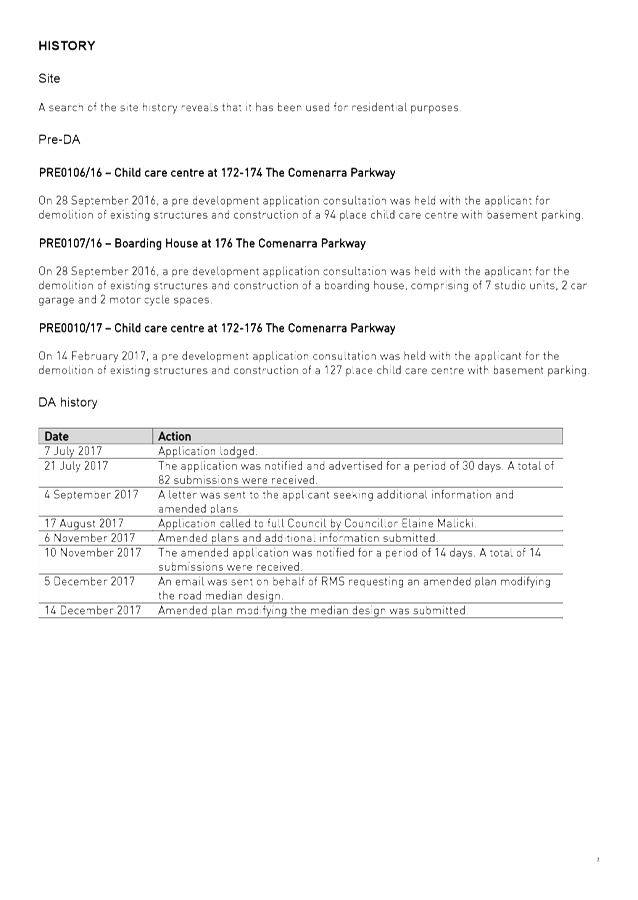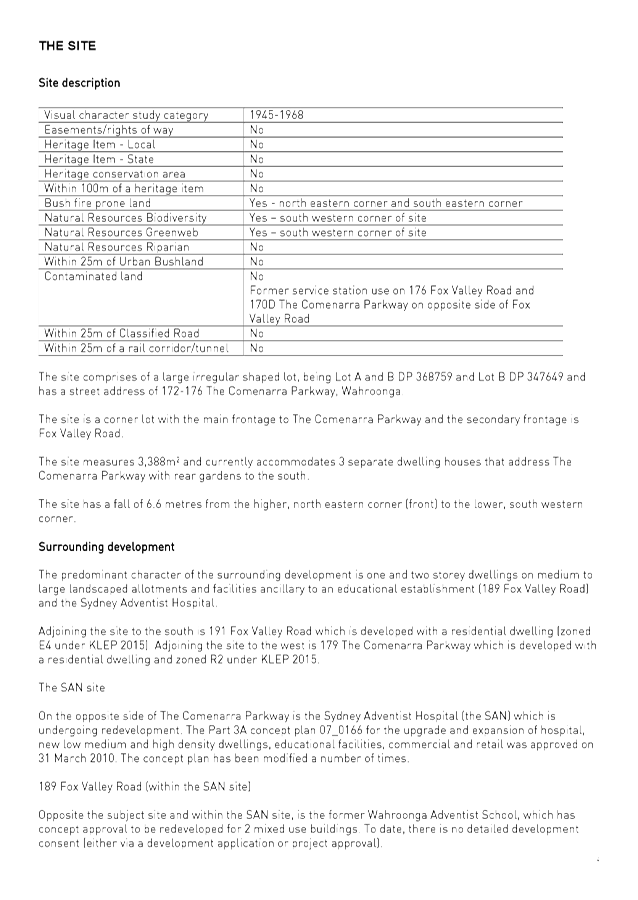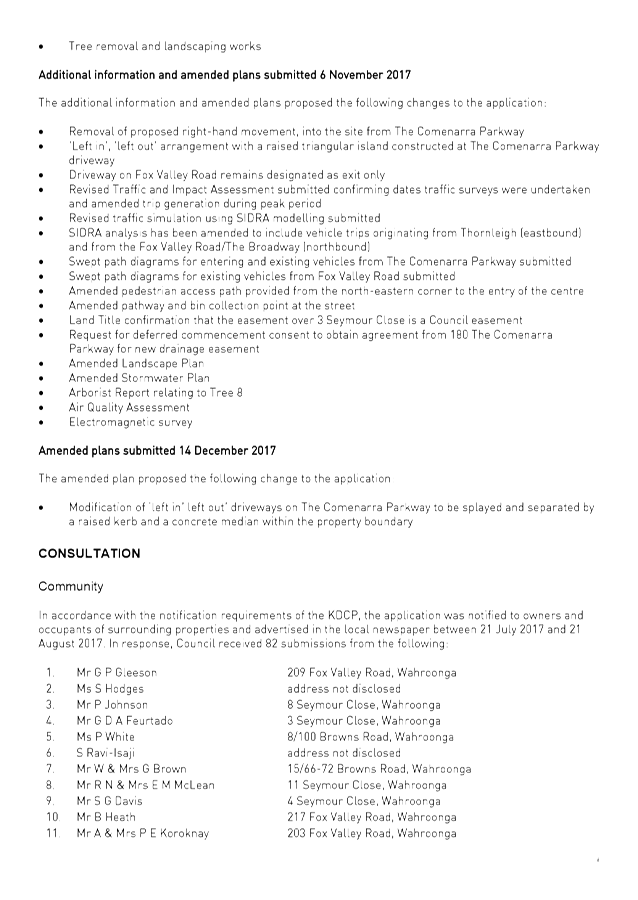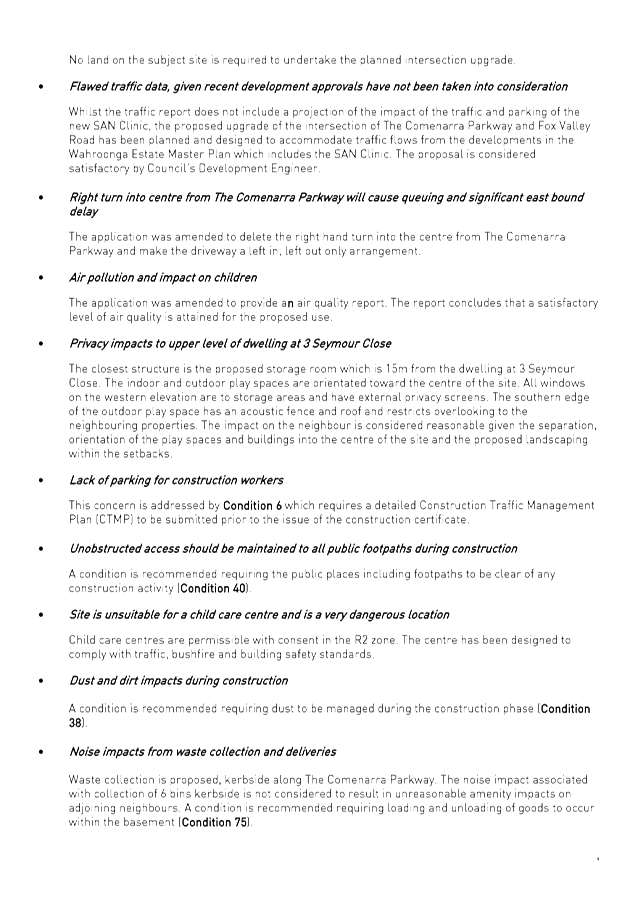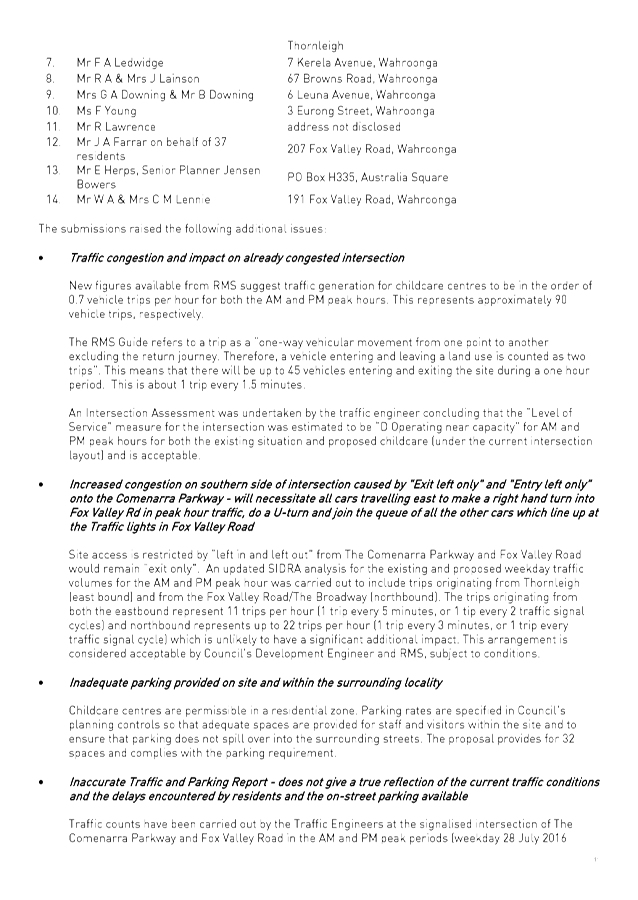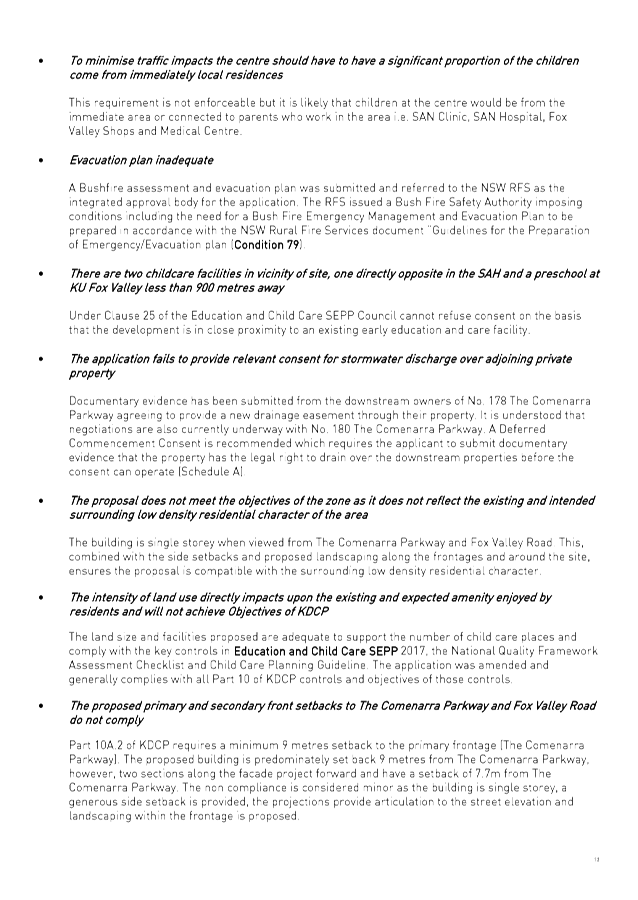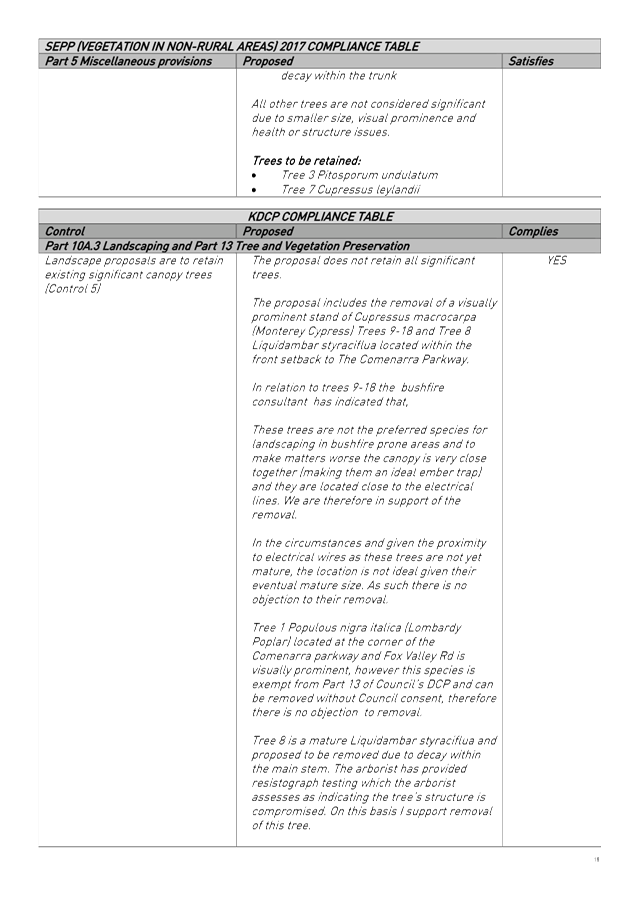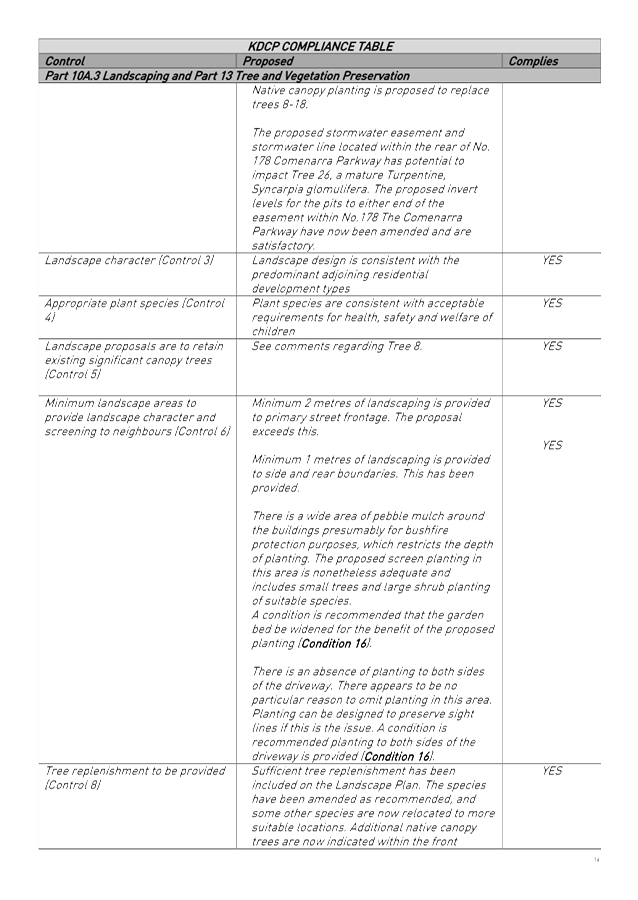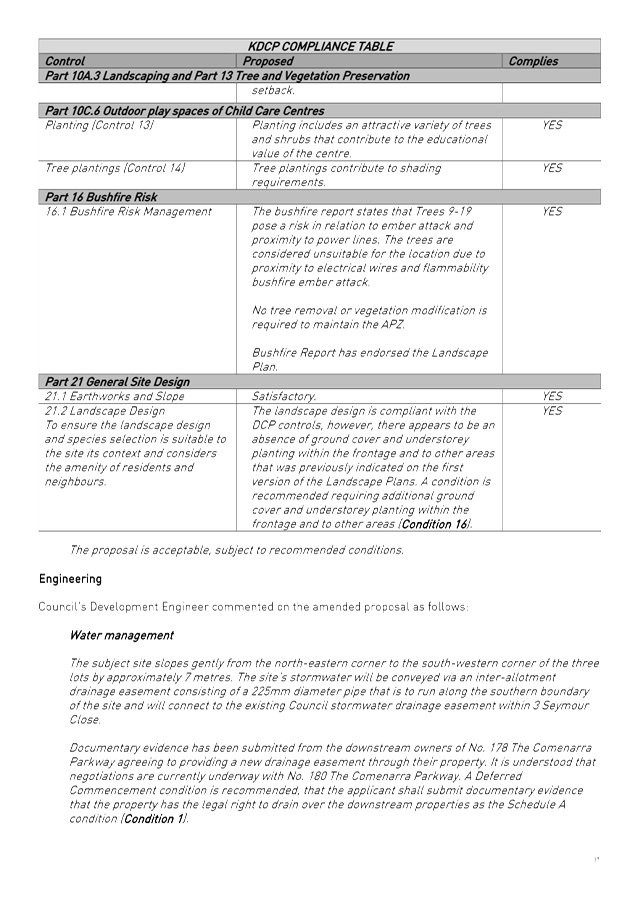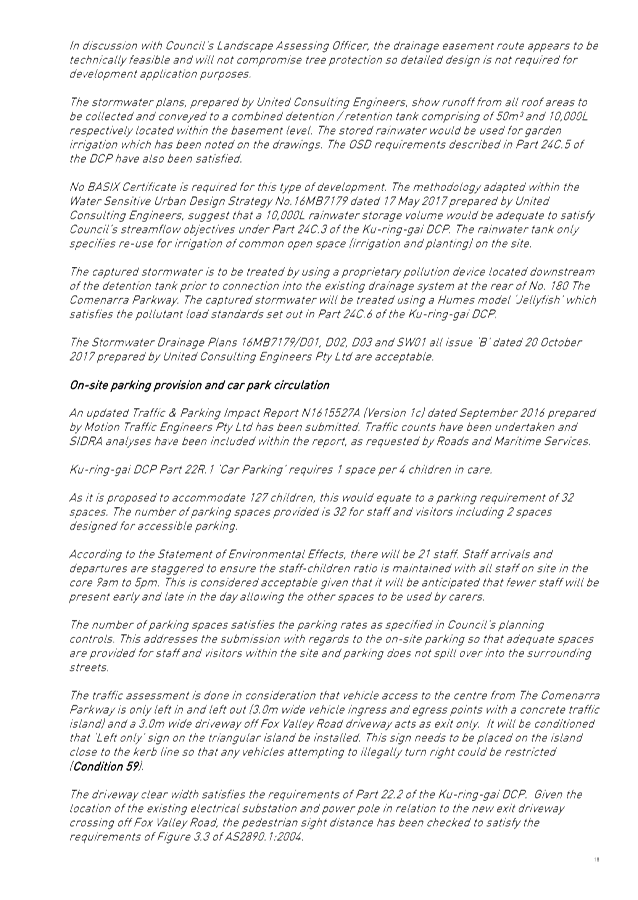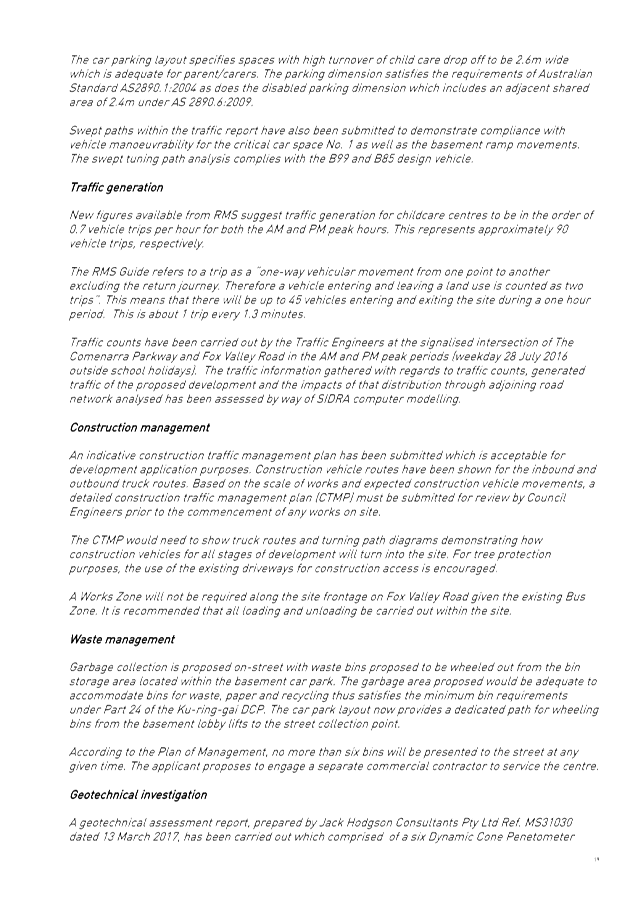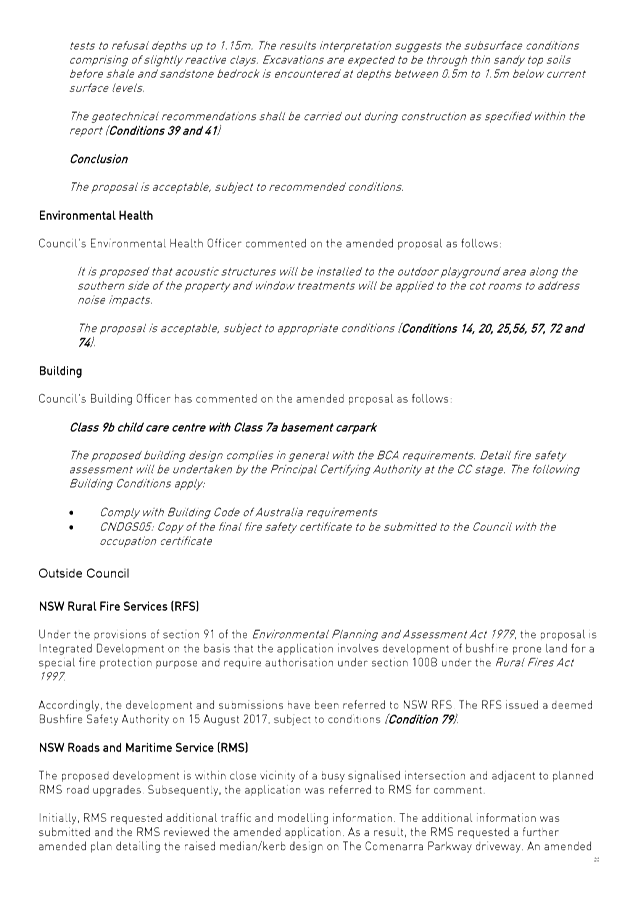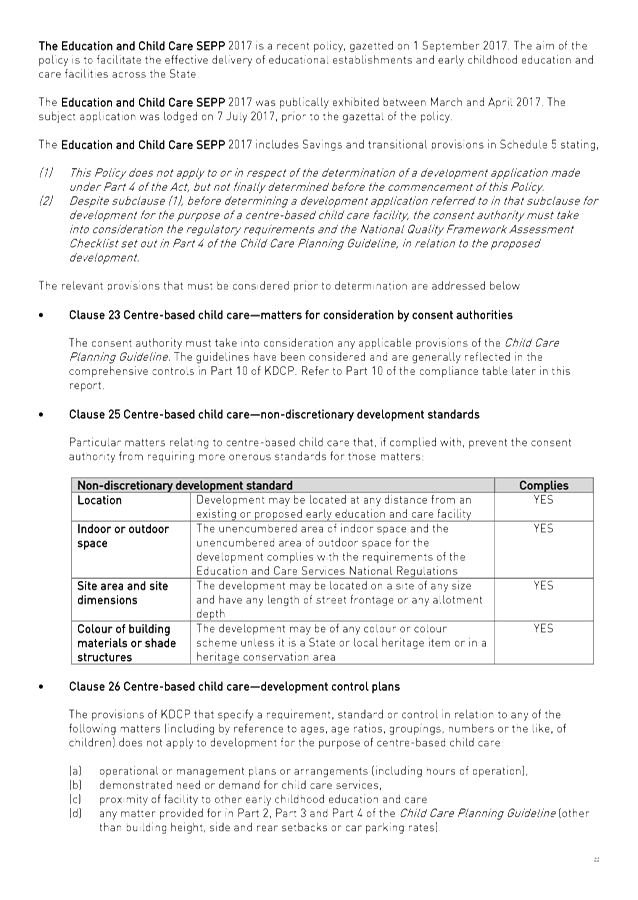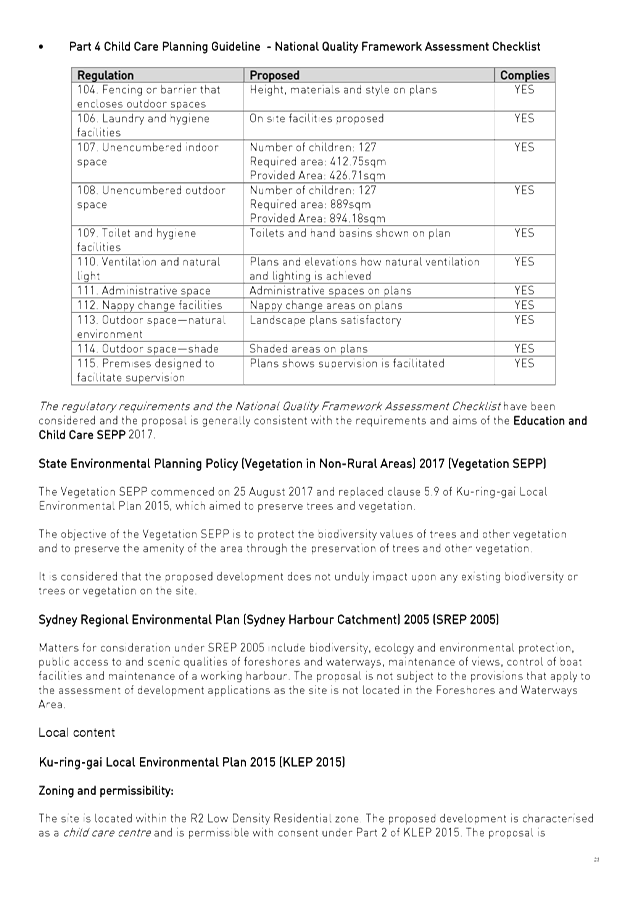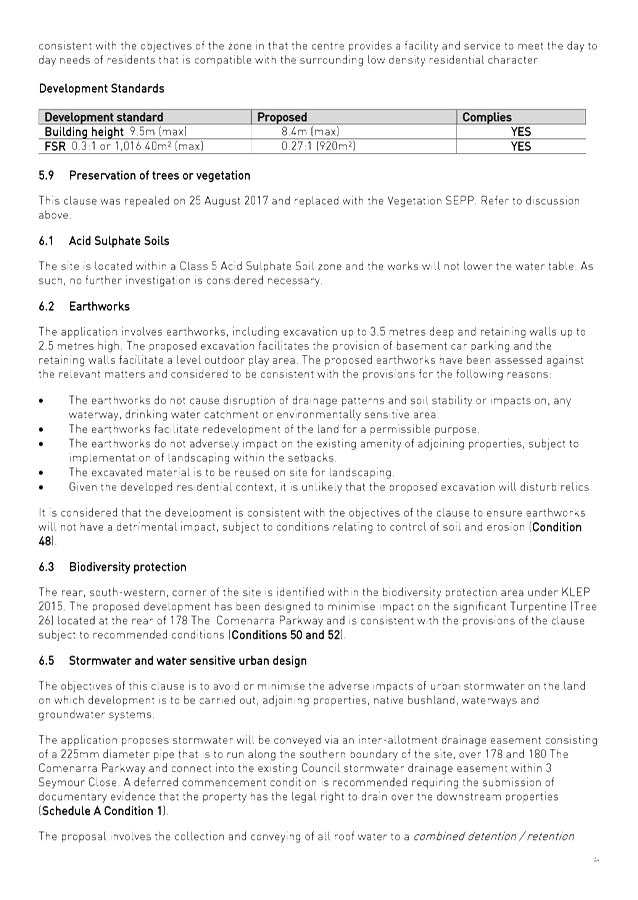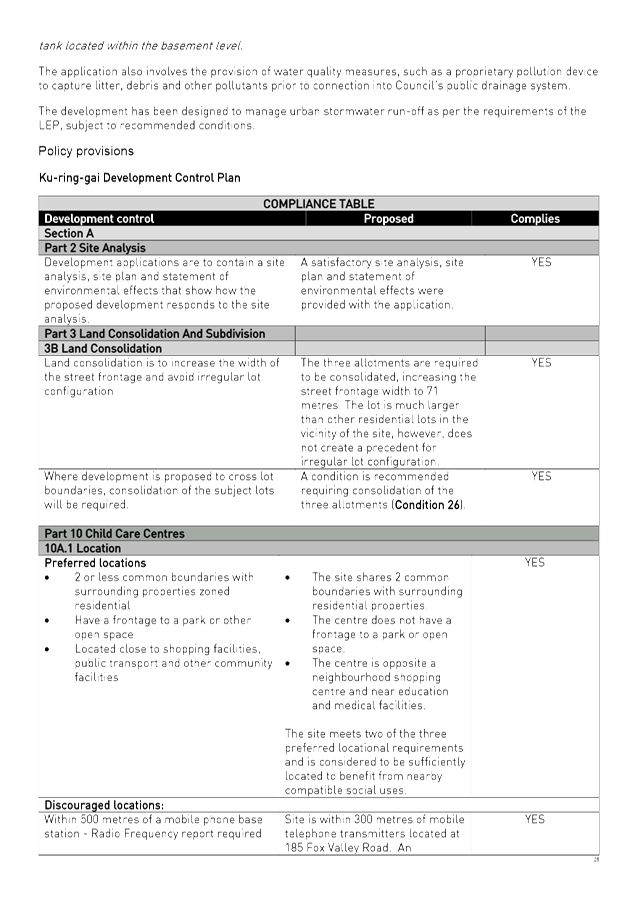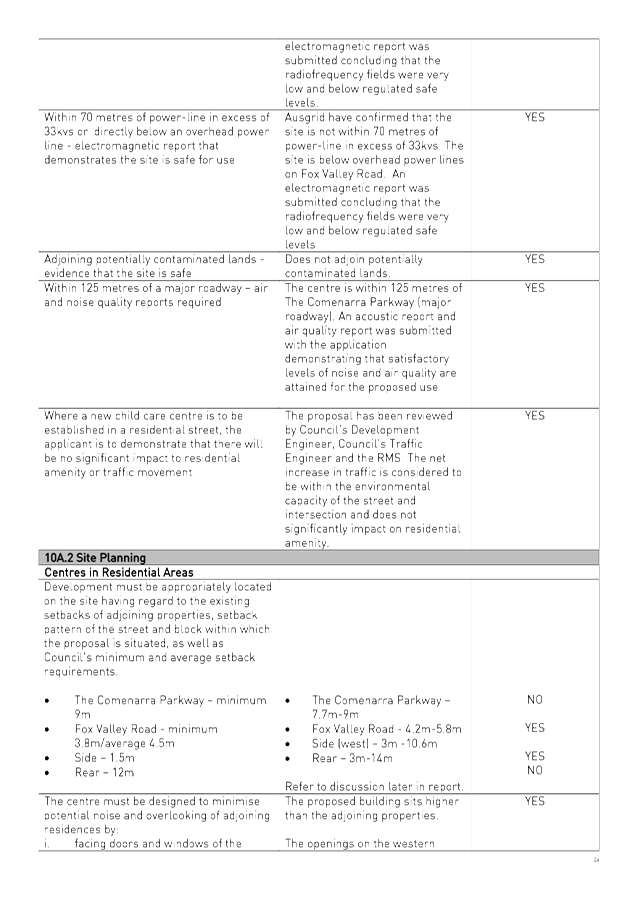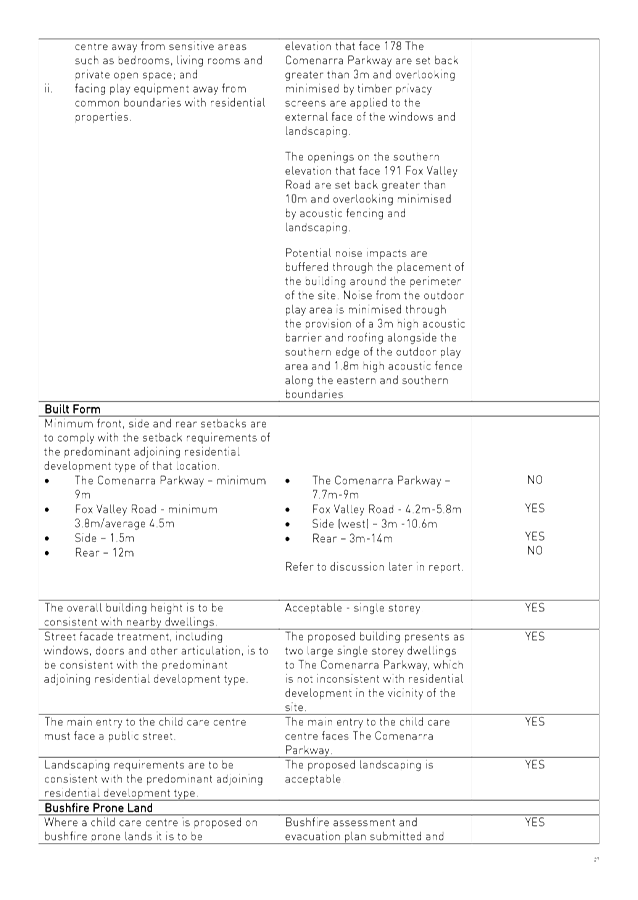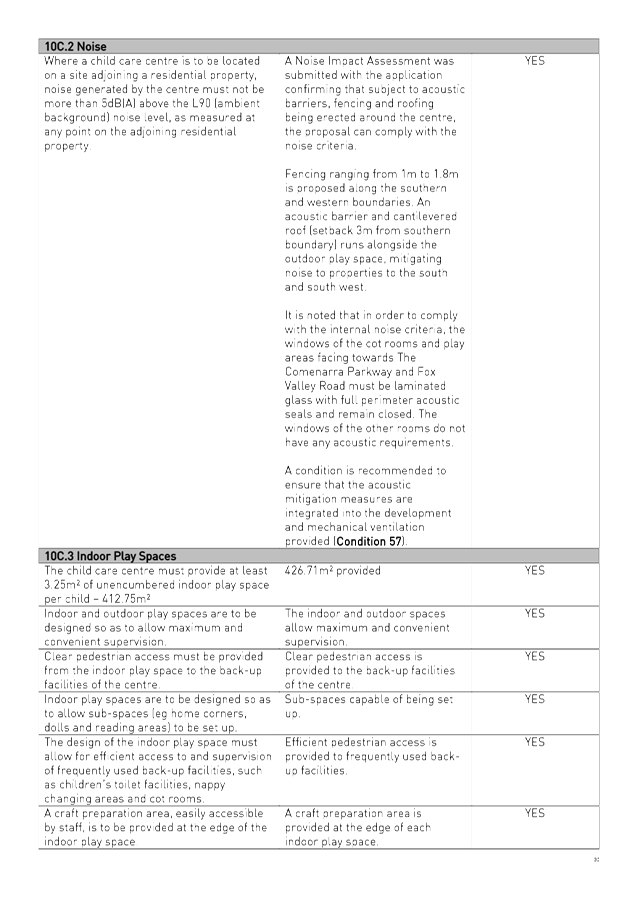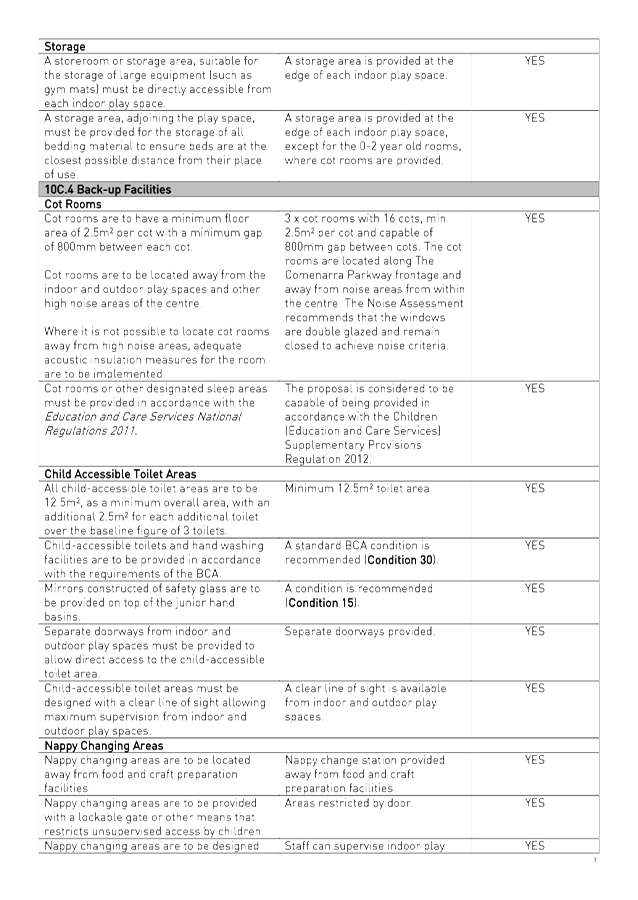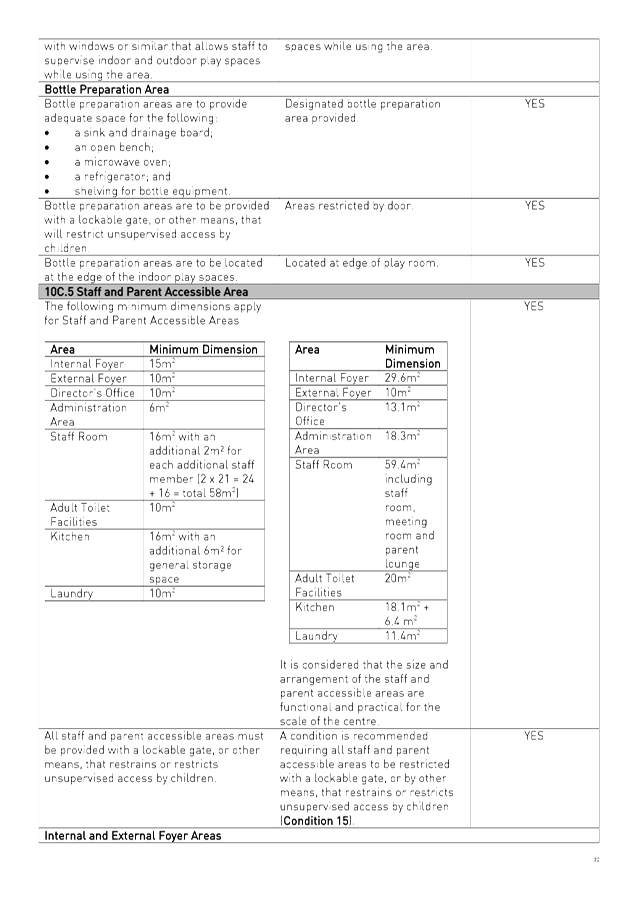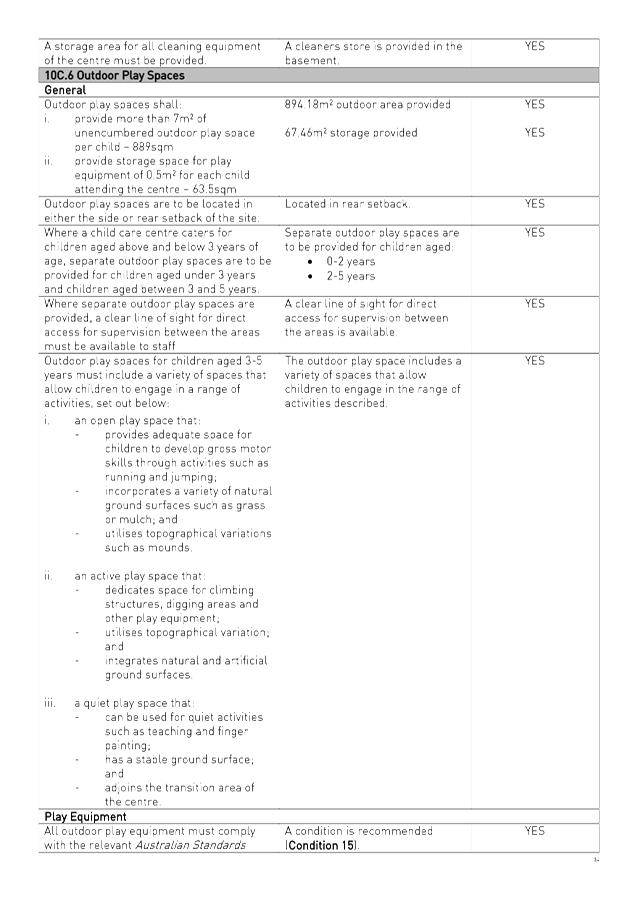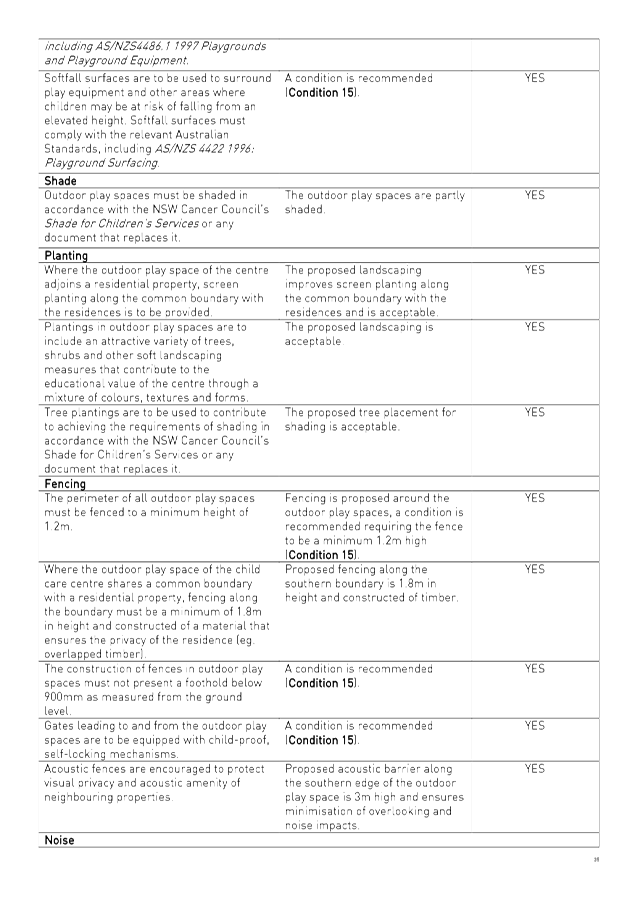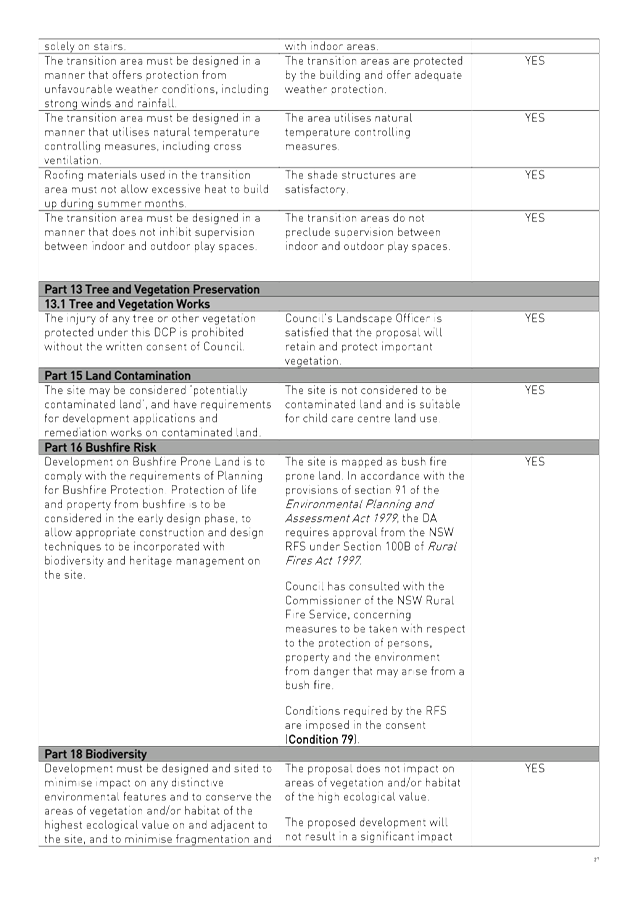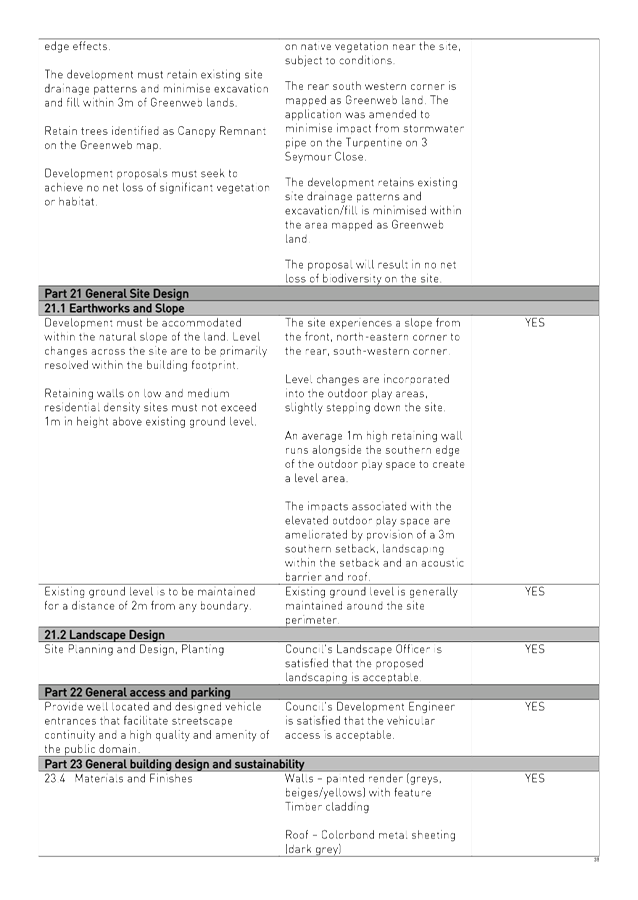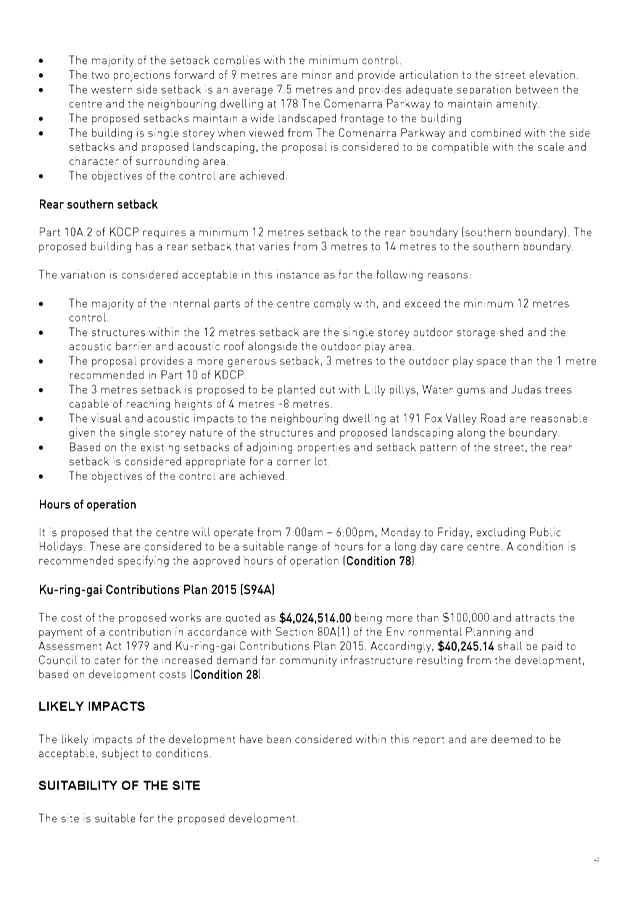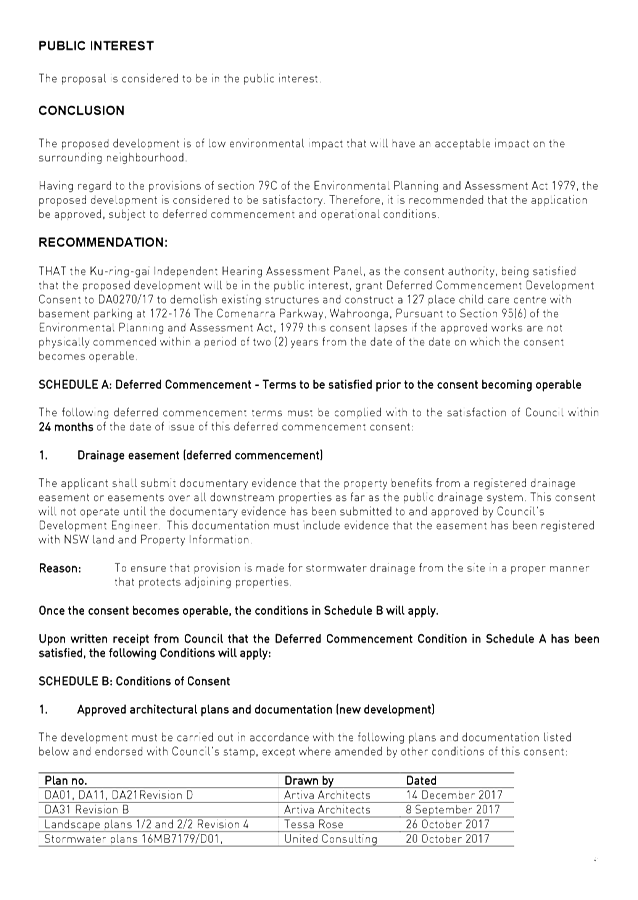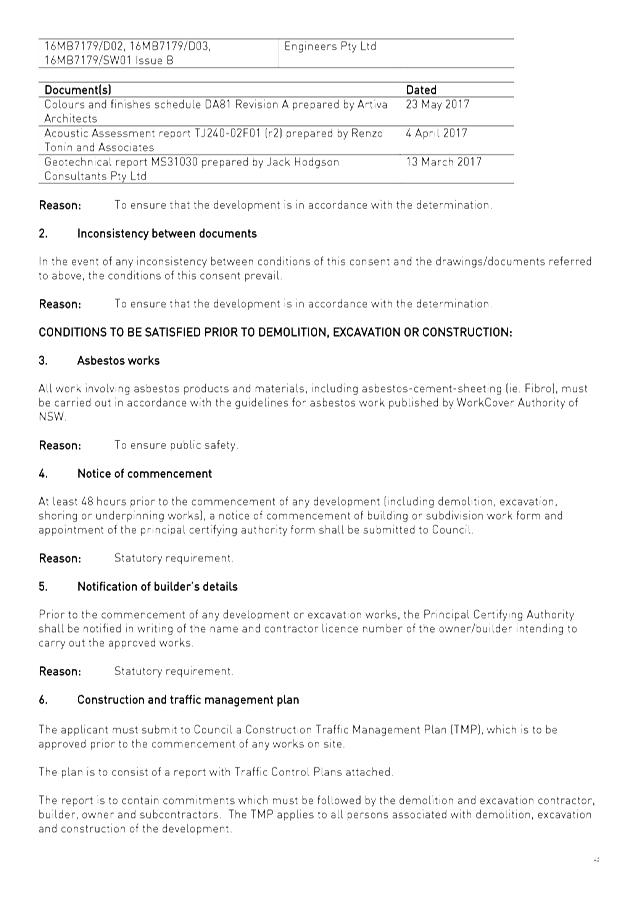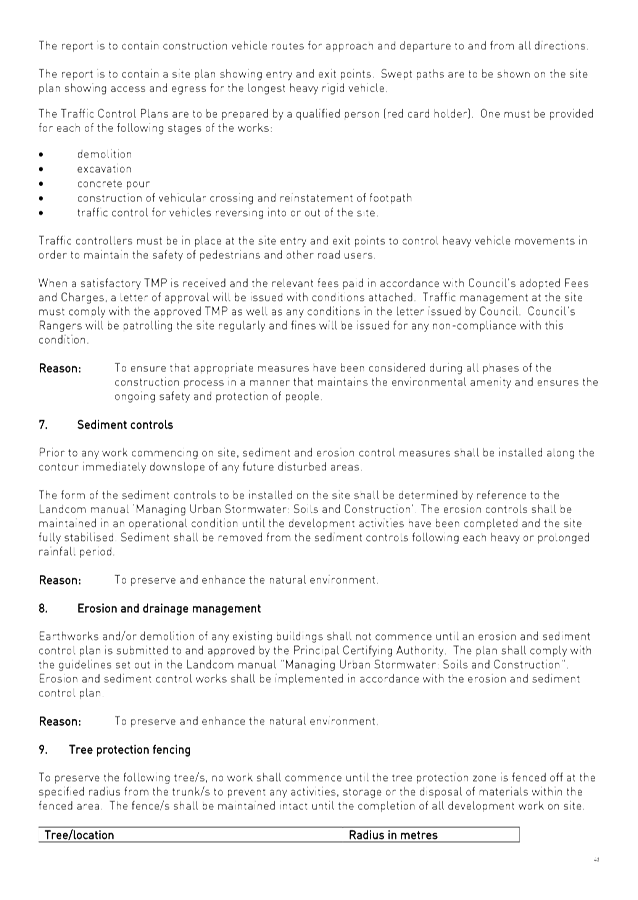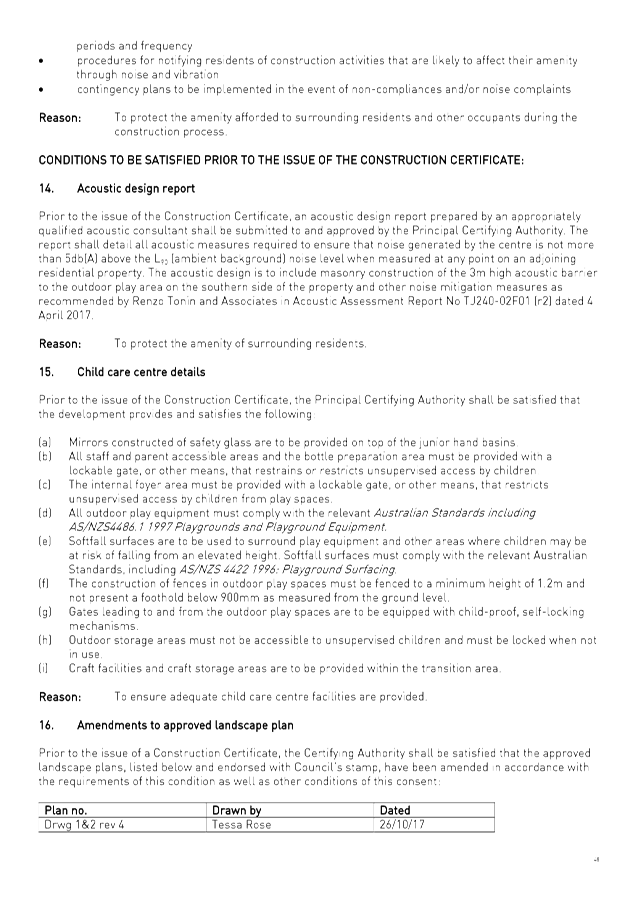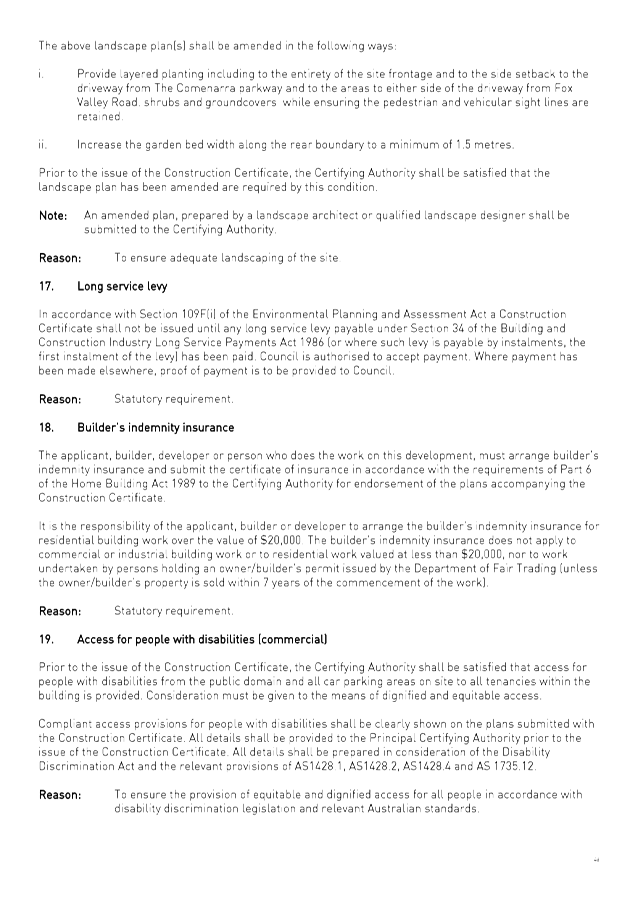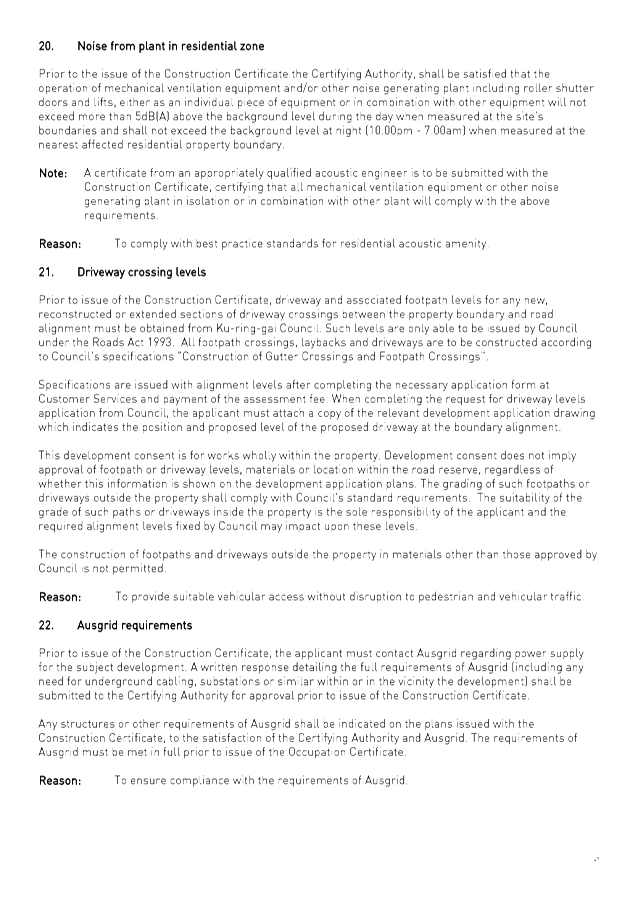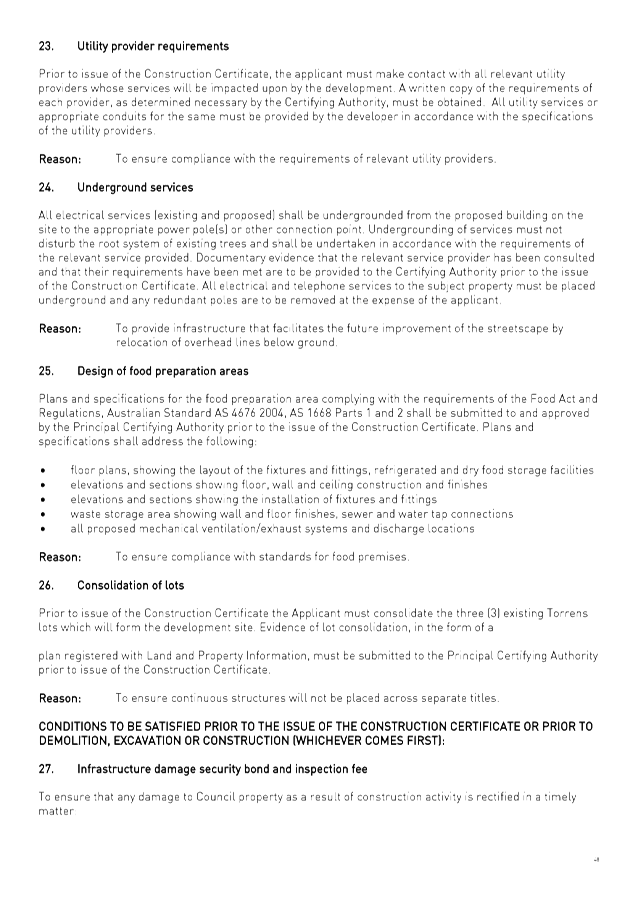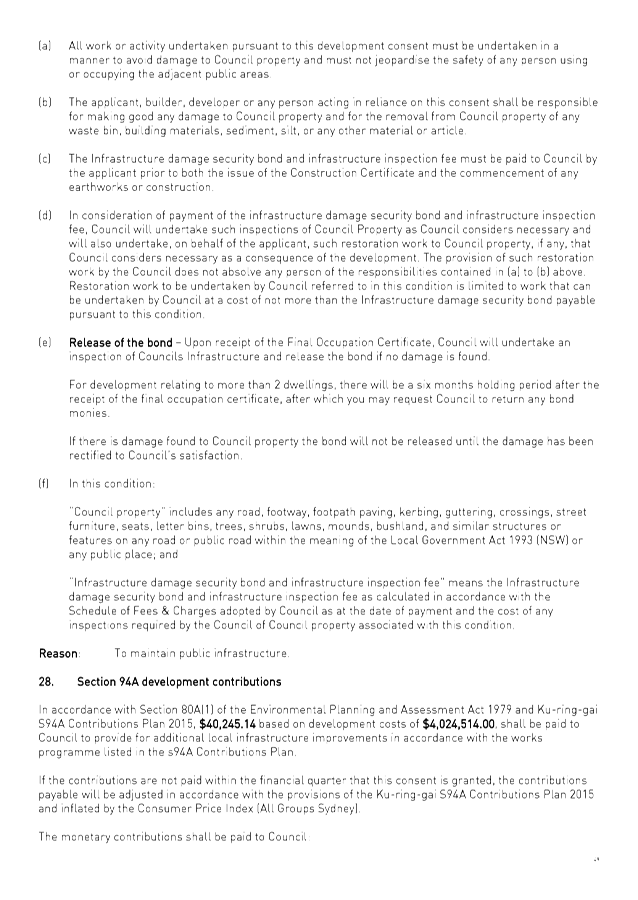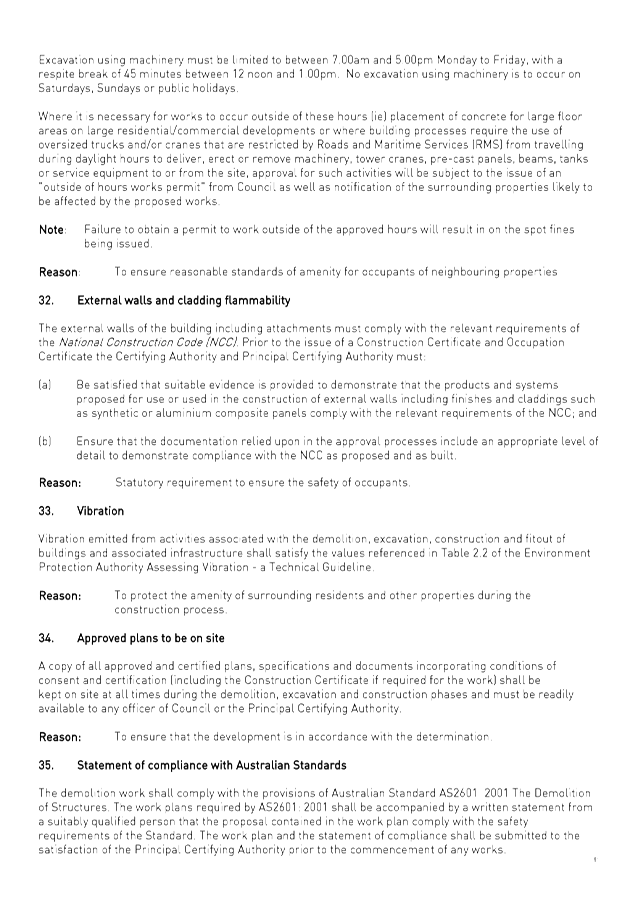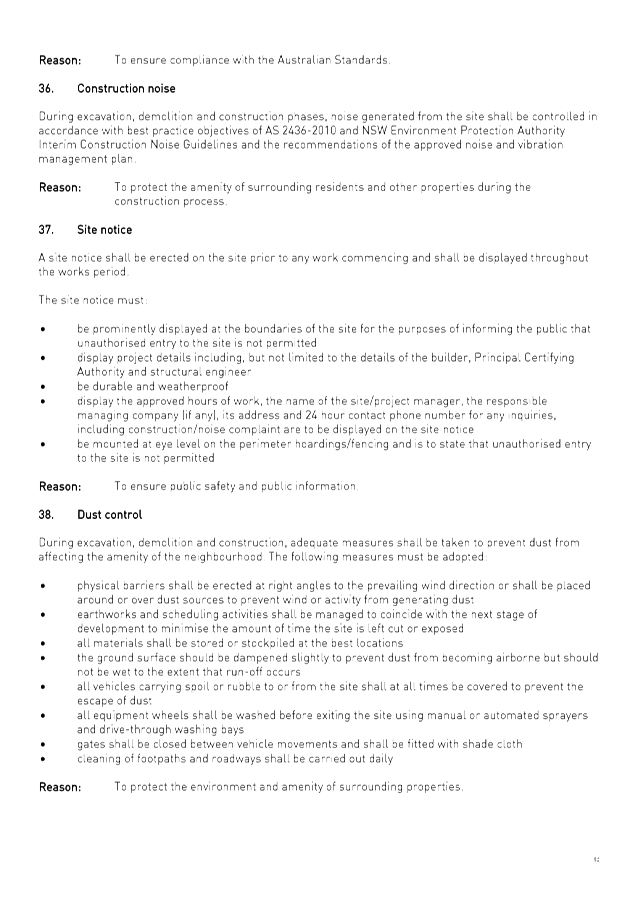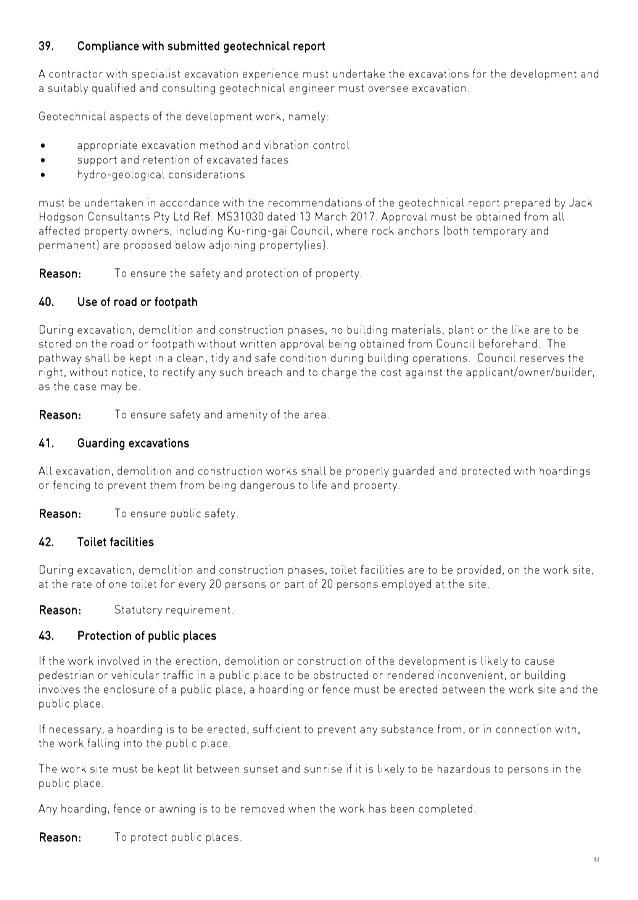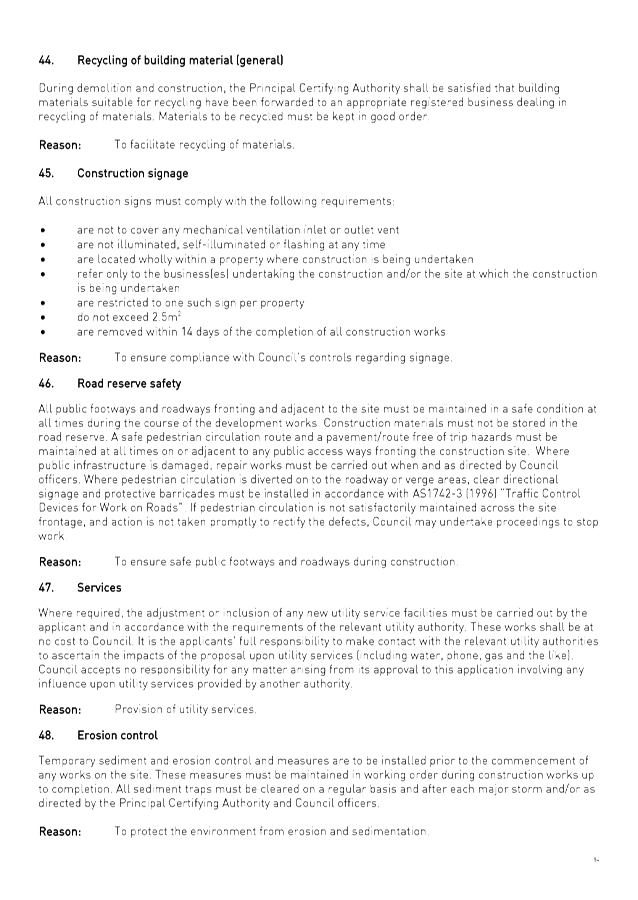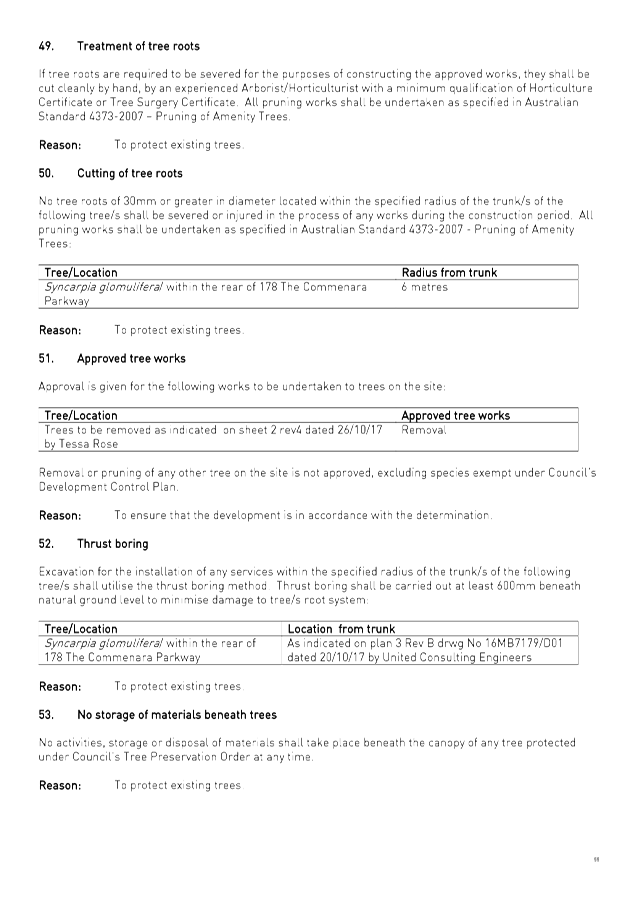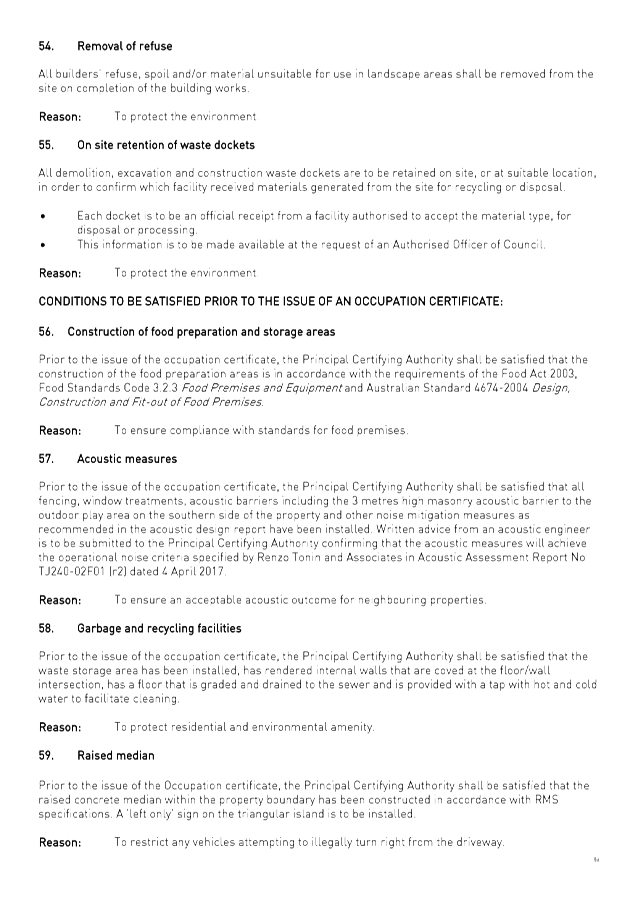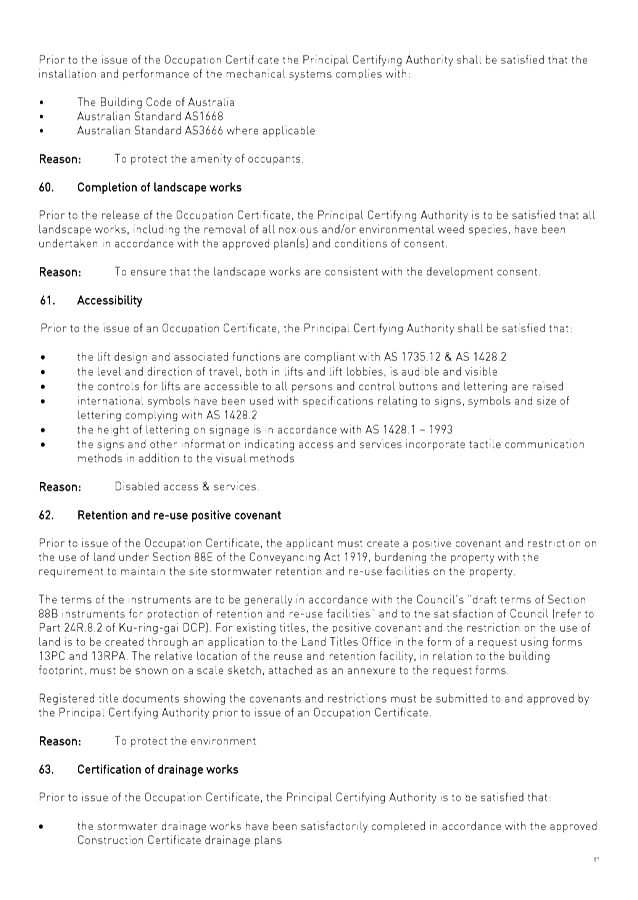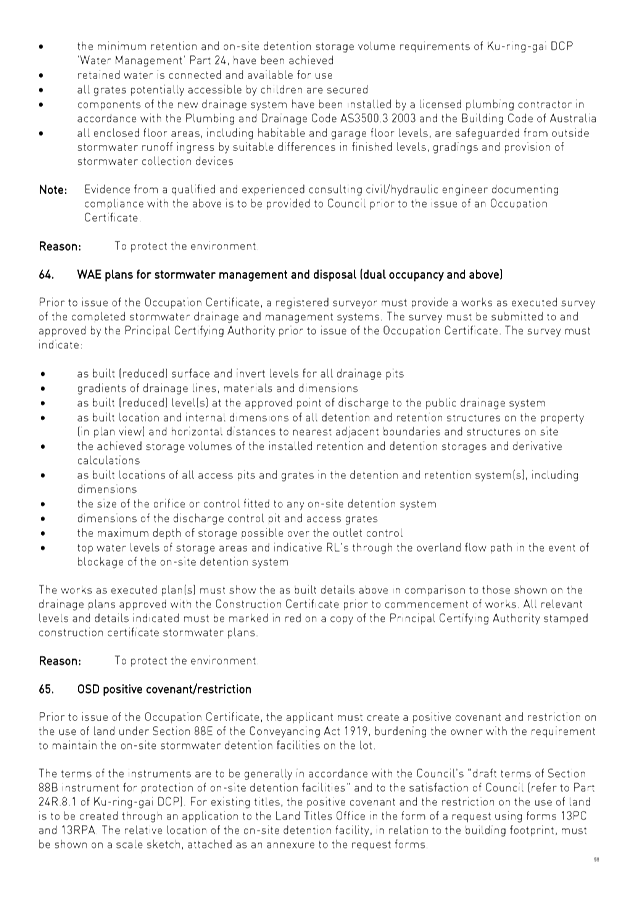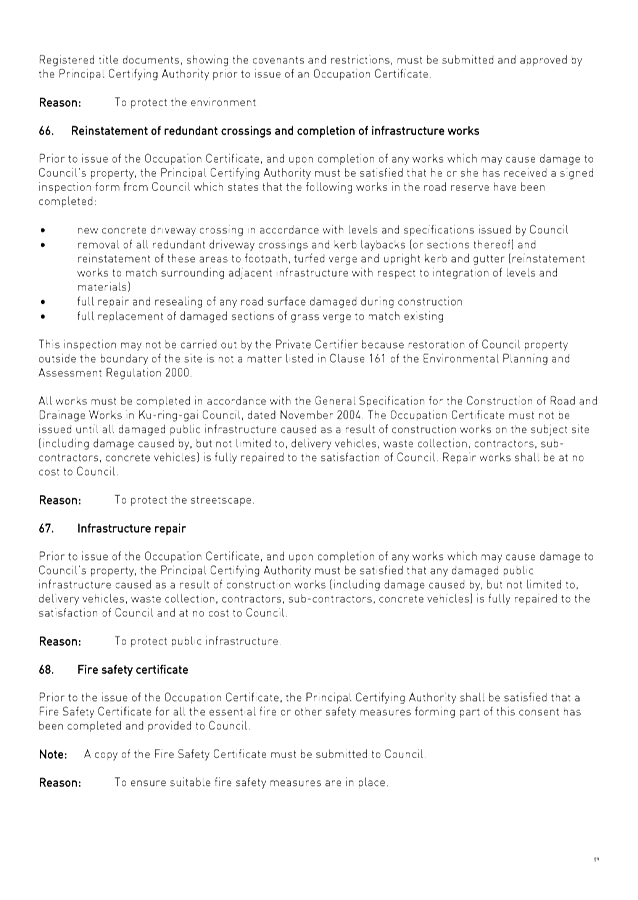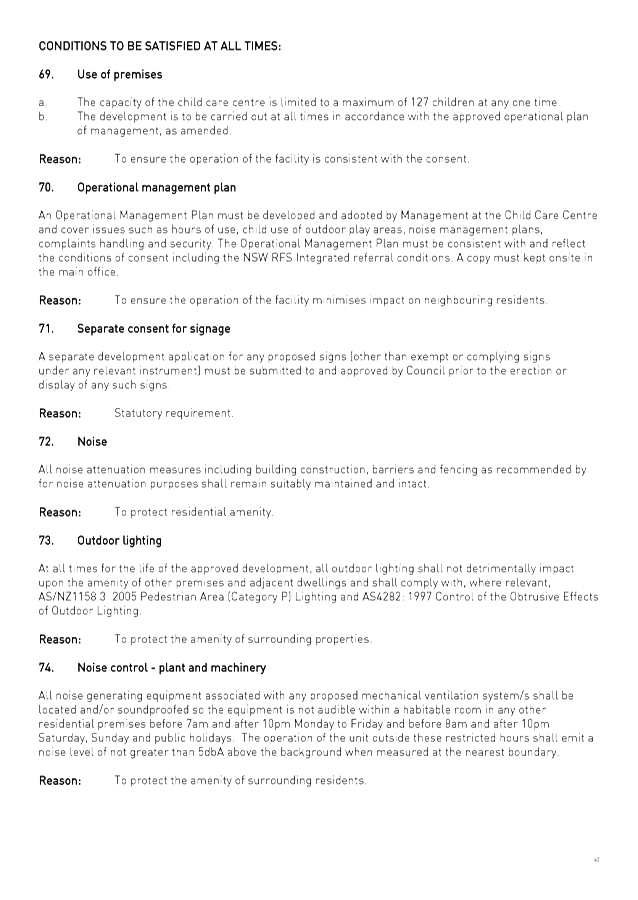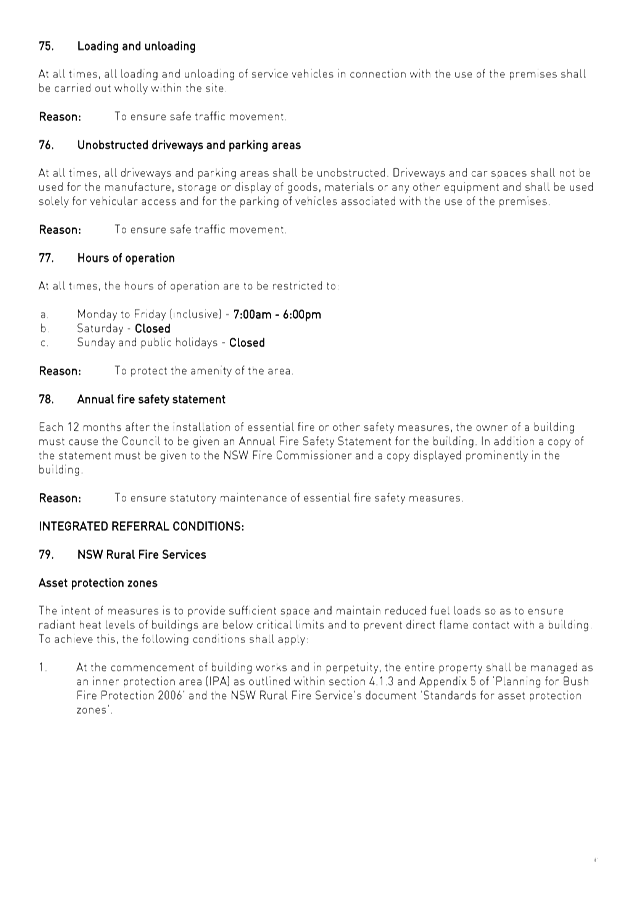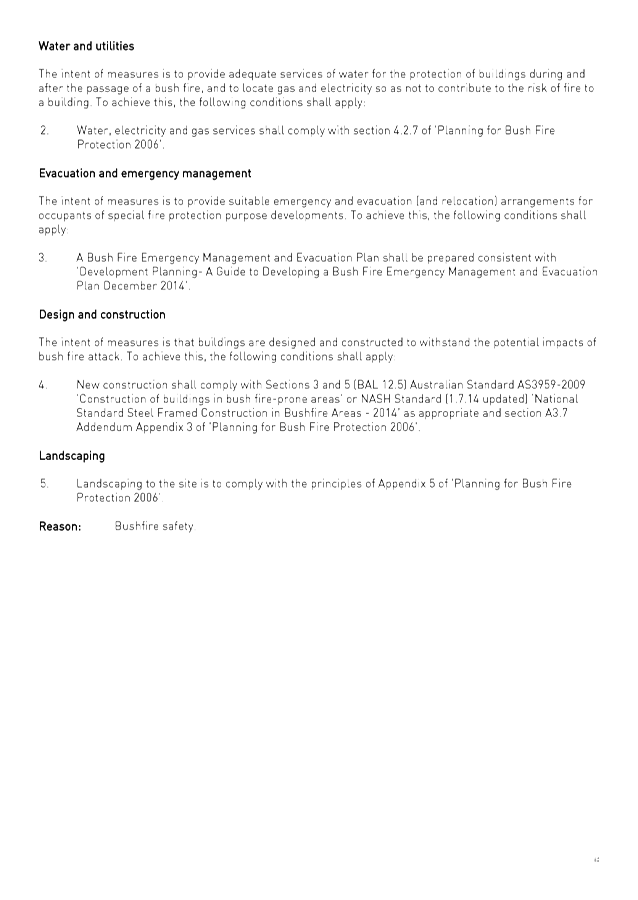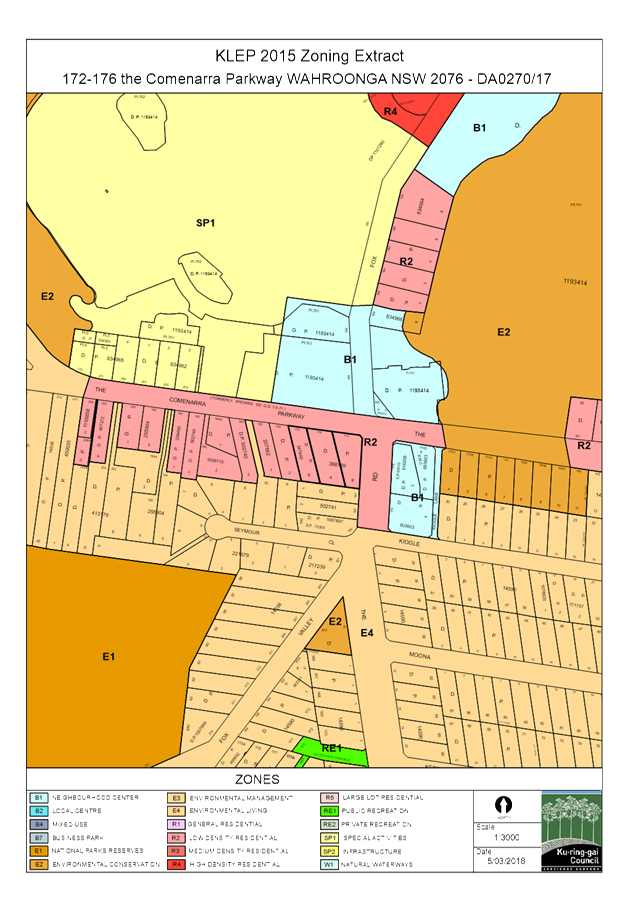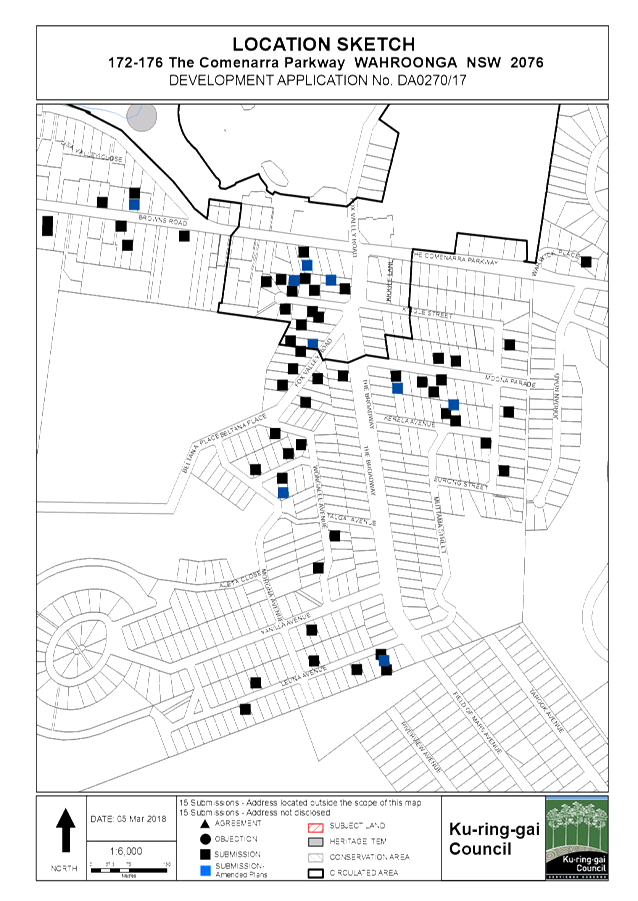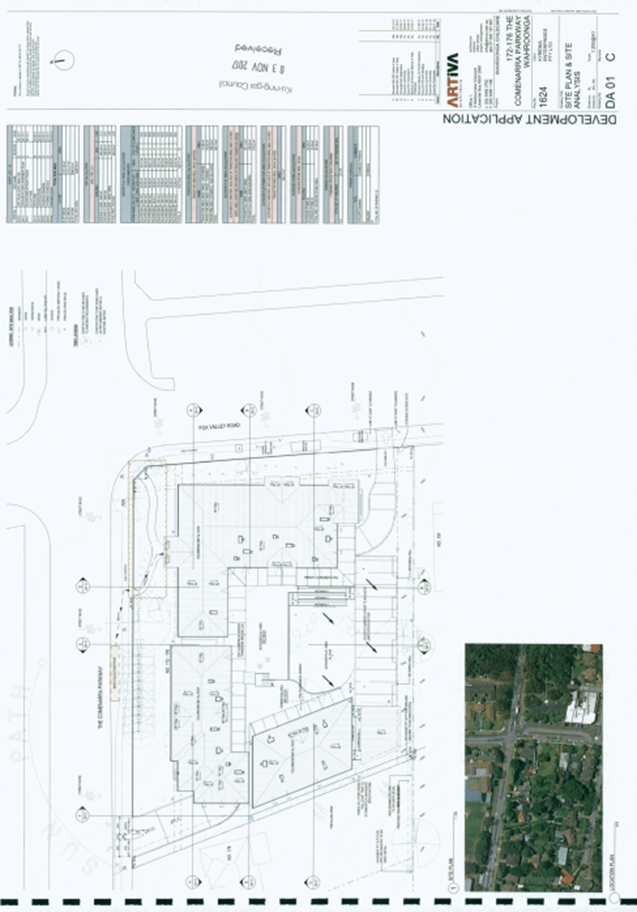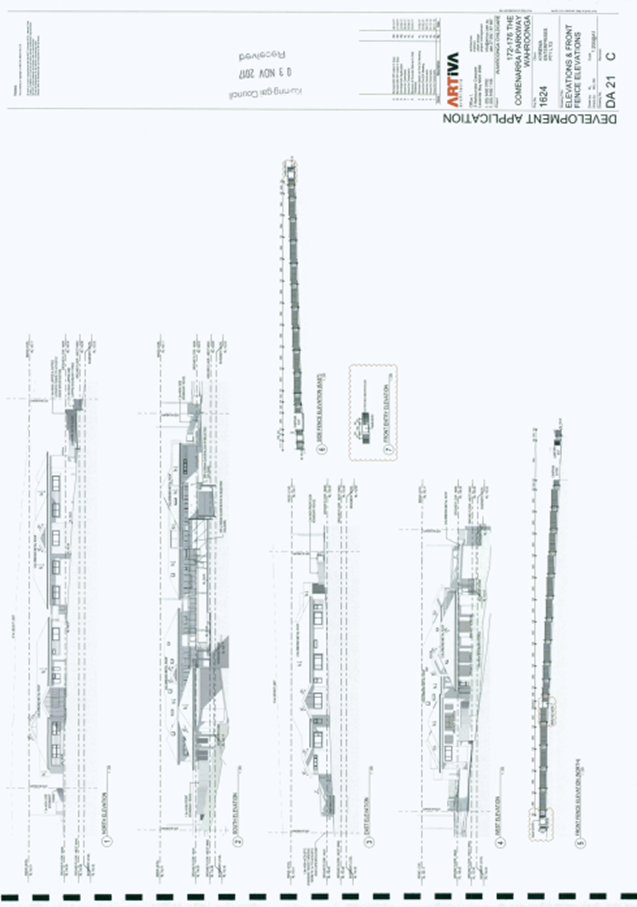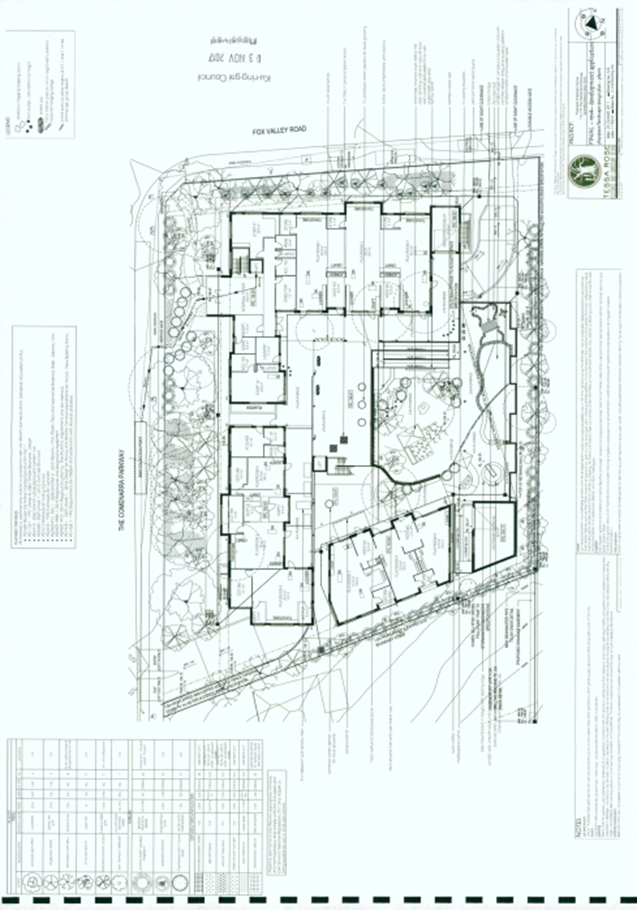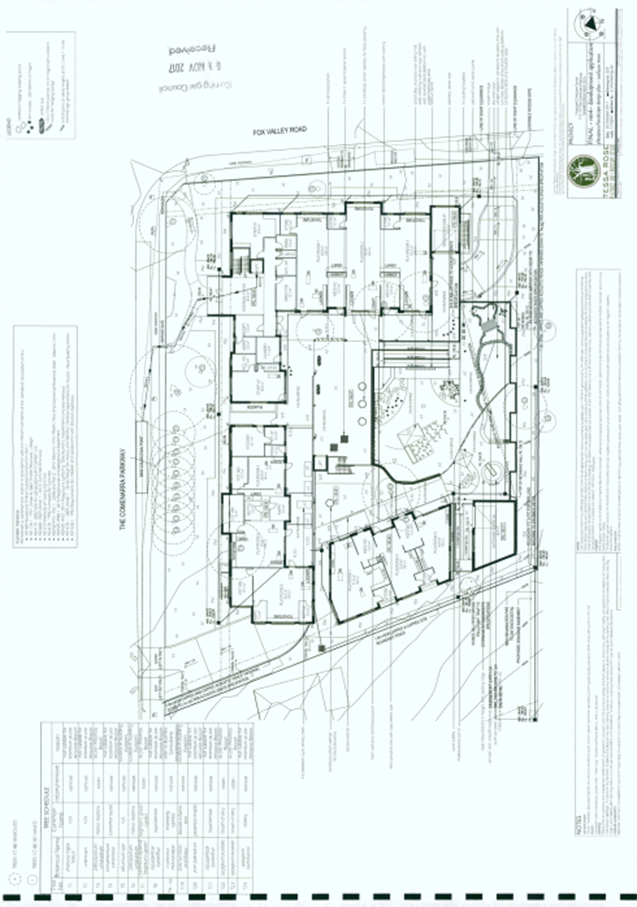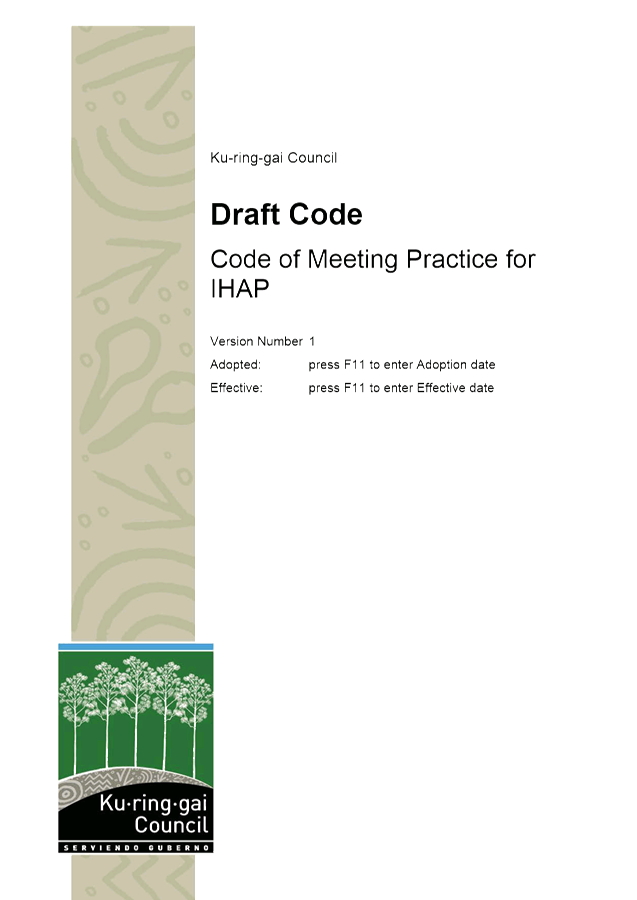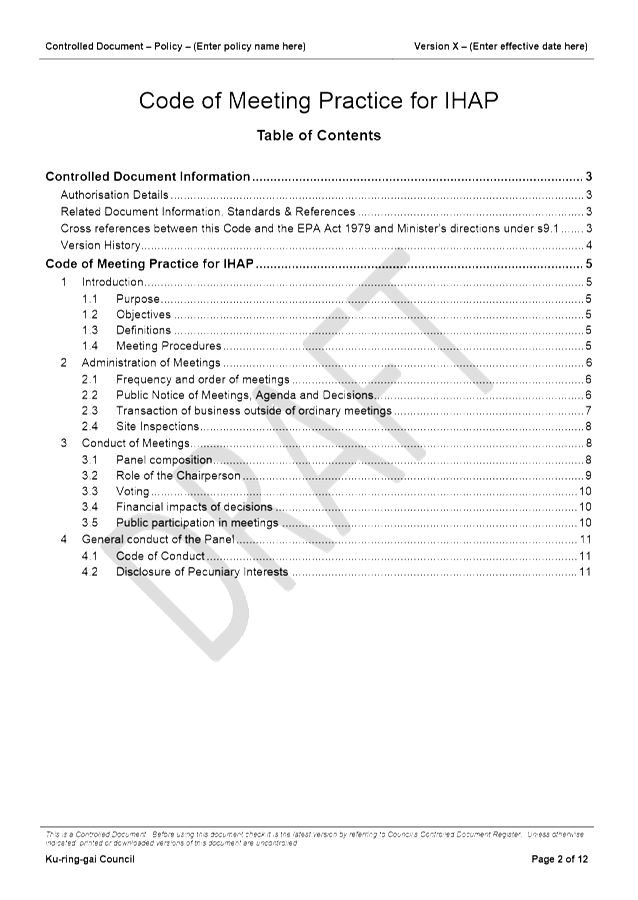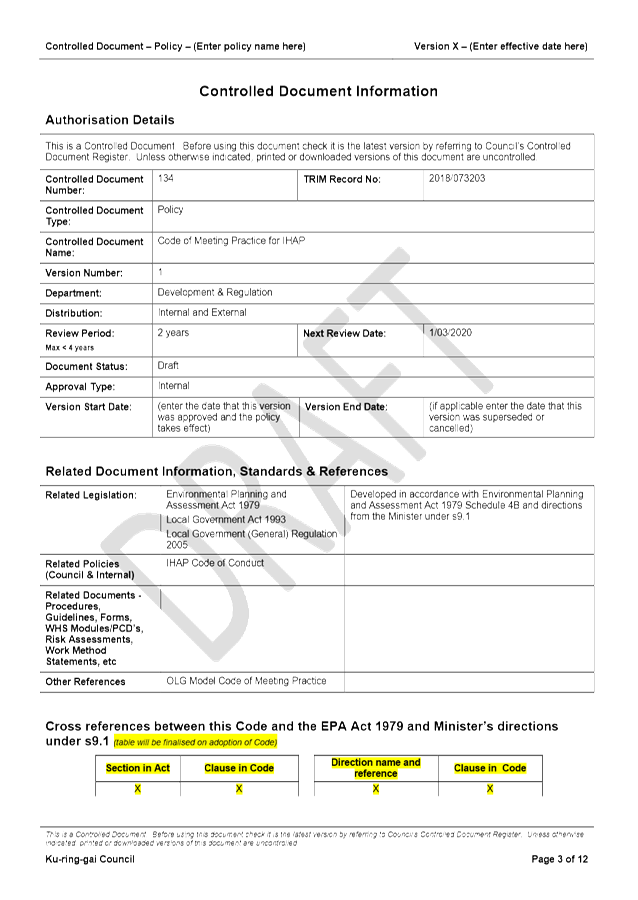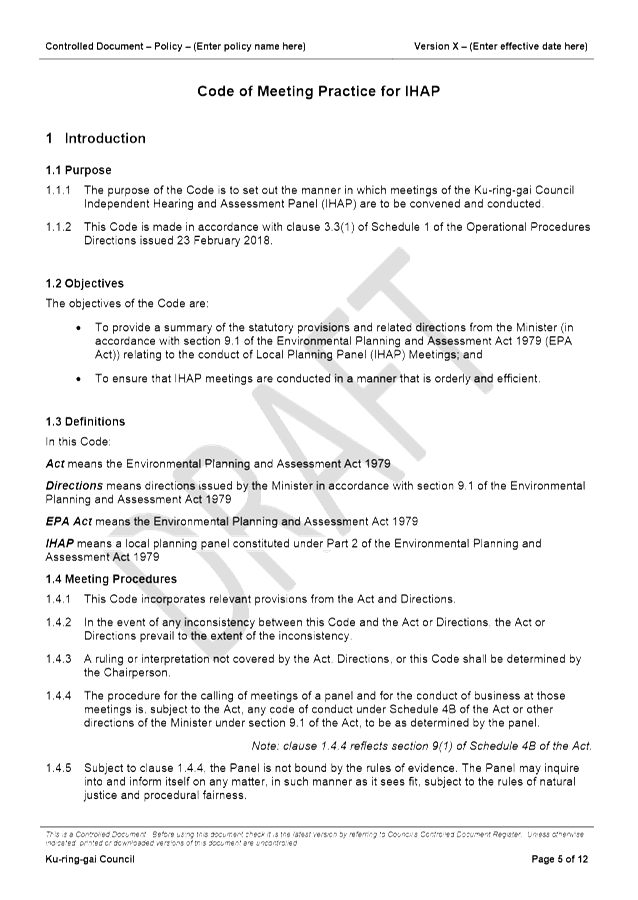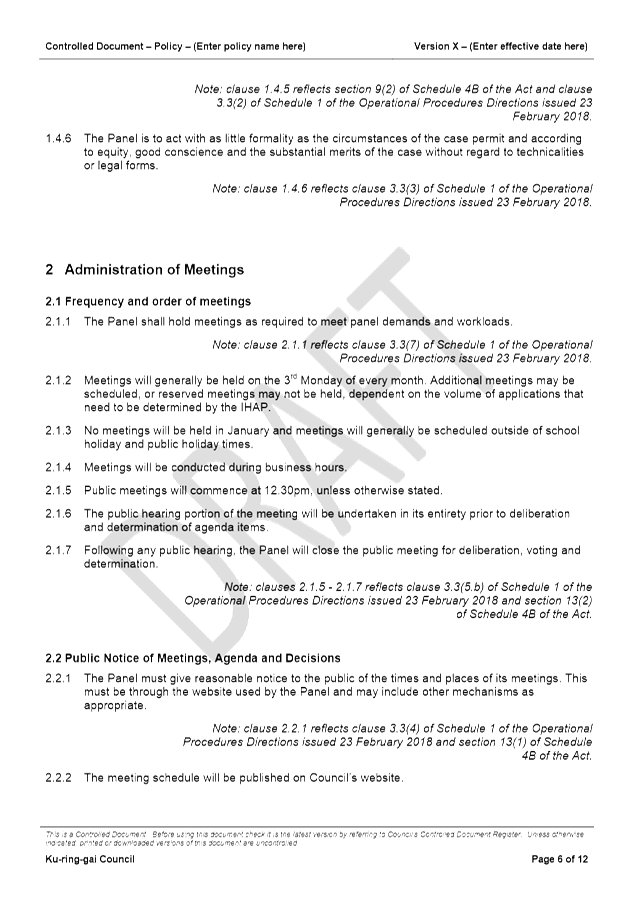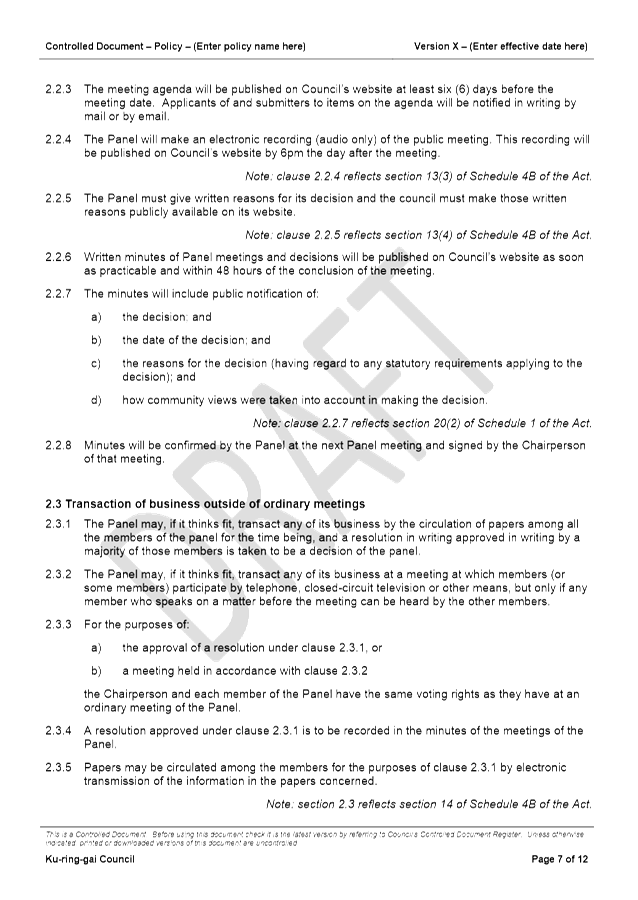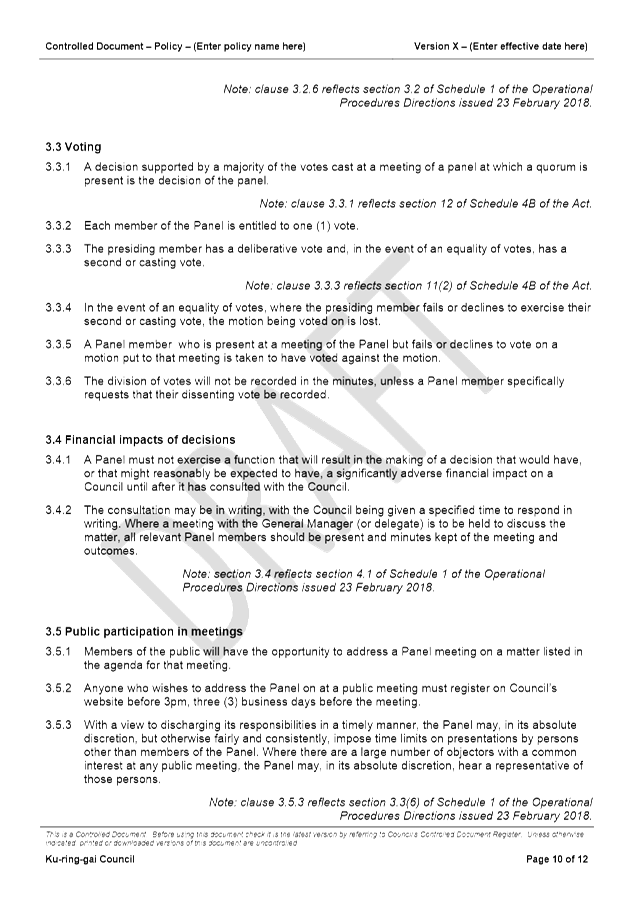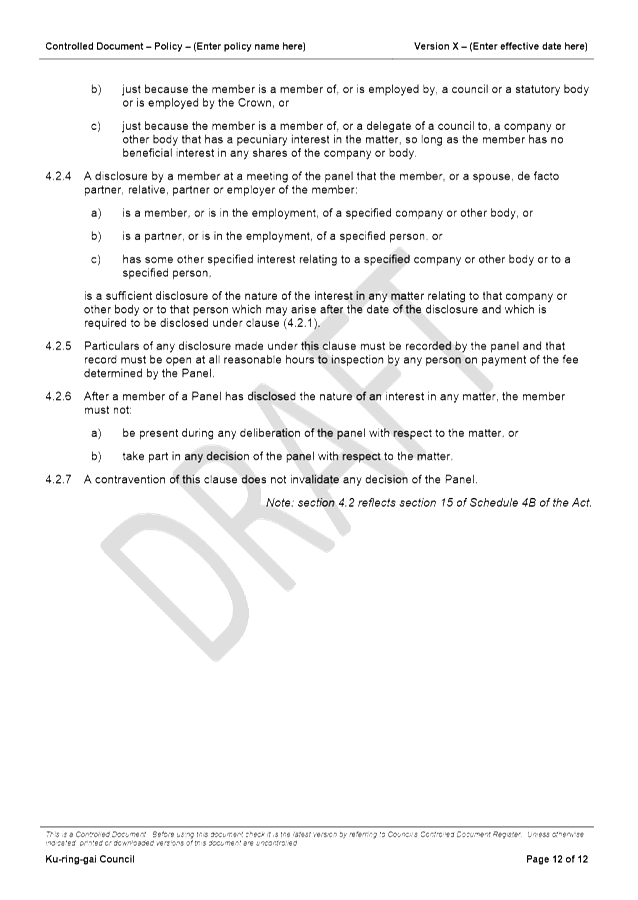|
The Panel Advised:
PURSUANT
TO SECTION 82A OF THE ENVIRONMENTAL PLANNING AND ASSESSMENT ACT, 1979
A.
That the Ku-ring-gai
Independent Hearing and Assessment Panel, as the
consent authority, having undertaken a review of the application (REV0002/18)
in accordance with Section 82A of the Environmental Planning and Assessment
Act, 1979, is satisfied that the reasons for the refusal of DA0655/16 have
been addressed by the applicant.
B. That
the Ku-ring-gai Independent Hearing and Assessment Panel, as the consent
authority, is of the opinion that the request under clause 4.6 of Ku-ring-gai
Local Environmental Plan (Local Centres) 2012 to vary the building height
development standard in clause 4.3 ‘Height of buildings’ of the
LEP is well founded. The Ku-ring-gai Independent Hearing and Assessment
Panel is also of the opinion that strict compliance with the
development standard is unreasonable and unnecessary in the circumstances of
the case and that there are sufficient environmental planning grounds to
justify the variation to the development standard.
C. That
the Ku-ring-gai Independent Hearing and Assessment Panel, as the consent authority, being satisfied that the
proposed development will be in the public interest, grant deferred
development consent to DA0655/16 for Lot consolidation, demolition of
existing structures and construct shop top housing development comprising a
ground floor retail tenancy and 36 residential units, three levels of car
parking (68 spaces) and associated works,
subject to conditions. Pursuant to Section 95(2) of the Environmental
Planning and Assessment Act 1979, this consent lapses if the approved works
are not physically commenced within two (2) years from the date on which the
consent becomes operable.
The conditions of consent are
as follows:
SCHEDULE A: Deferred Commencement
– Term(s) to be satisfied prior to the consent becoming operable
The
following deferred commencement term(s) must be complied with to the
satisfaction of Council within 24 months of the date of issue of this
deferred commencement consent:
1.
Drainage easement (deferred commencement)
The applicant shall submit
documentary evidence that the property benefits from a registered drainage
easement or easements over all downstream properties as far as the public
drainage system. This consent will not operate until the documentary evidence
has been submitted to and approved by Council’s Development
Engineer. This documentation must include evidence that the easement
has been registered with NSW land and Property Information.
2.
Design of interallotment drainage easement
The applicant shall submit full hydraulic design documentation for the
required interallotment drainage system from the subject property to the
approved point of discharge to the public drainage system by gravity.
Plans are to be prepared by a suitably qualified and experienced consulting
civil engineer in accordance with Council’s DCP and AS3500.3 (2003) Plumbing
Code. New drainage pipe within the downstream easement drainage system
shall be sized to have adequate capacity to carry uncontrolled runoff (1: 100
year ARI) from the subject property. The following engineering details must
be included:
i. Plan view of interallotment system to
scale showing dimensions, location and reduced levels of all pits, grates,
pipe inverts, flushing facilities and exact point of discharge,
ii. The contributing catchment calculations and
supporting pipe sizing information,
iii. Longitudinal section showing existing ground
levels and proposed pipe invert levels, grades and flow capacities,
iv. Surrounding survey detail including all trees
within seven (7) metres of the proposed interallotment drainage system.,
v. The proposed
interallotment drainage pipeline shall be designed so that it has adequate
capacity to carry uncontrolled runoff (up to 1 in 100 year ARI) from each
proposed allotment.
vi. It shall be noted that in
accordance with Councils’ DCP an easement width of 1.2m is required for
inter-allotment (or private) drainage pipeline of 225mm diameter.
Reason: To
ensure that provision is made for stormwater drainage from the site in a
proper manner that protects adjoining properties.
Once the consent becomes
operable, the conditions in Schedule B will apply. Upon written receipt from
Council that the deferred commencement terms in Schedule A have been
satisfied, the following conditions will apply:
SCHEDULE B: Conditions of
consent:-
Conditions that identify
approved plans:
1. Approved architectural
plans and documentation (new development)
The development must be
carried out in accordance with the following plans and documentation listed
below and endorsed with Council’s stamp, except where amended by other
conditions of this consent:
|
Plan no.
|
Drawn by
|
Dated
|
|
DA001 Issue D
|
PBD Architects
|
9/04/2018
|
|
DA002 Issue D
|
PBD Architects
|
9/04/2018
|
|
DA100 Issue F
|
PBD Architects
|
30/04/2018
|
|
DA101 Issue G
|
PBD Architects
|
30/04/2018
|
|
DA102 Issue G
|
PBD Architects
|
30/04/2018
|
|
DA103 Issue G
|
PBD Architects
|
30/04/2018
|
|
DA104 Issue H
|
PBD Architects
|
30/04/2018
|
|
DA105 Issue H
|
PBD Architects
|
30/04/2018
|
|
DA106 Issue G
|
PBD Architects
|
30/04/2018
|
|
DA107 Issue H
|
PBD Architects
|
30/04/2018
|
|
DA108 Issue I
|
PBD Architects
|
30/04/2018
|
|
DA109 Issue H
|
PBD Architects
|
30/04/2018
|
|
DA110 Issue H
|
PBD Architects
|
30/04/2018
|
|
DA200 Issue G
|
PBD Architects
|
30/04/2018
|
|
DA201 Issue G
|
PBD Architects
|
30/04/2018
|
|
DA202 Issue I
|
PBD Architects
|
30/04/2018
|
|
DA203 Issue G
|
PBD Architects
|
30/04/2018
|
|
DA300 Issue I
|
PBD Architects
|
30/04/2018
|
|
DA301 Issue J
|
PBD Architects
|
30/04/2018
|
|
DA302 Issue D
|
PBD Architects
|
8/05/2018
|
|
DA400 Issue F
|
PBD Architects
|
30/04/2018
|
|
DA410 Issue D
|
PBD Architects
|
30/04/2018
|
|
DA420 Issue B
|
PBD Architects
|
9/04/2018
|
|
DA550 Issue E
|
PBD Architects
|
30/04/2018
|
|
DA551 Issue F
|
PBD Architects
|
30/04/2018
|
|
DA552 Issue F
|
PBD Architects
|
30/04/2018
|
|
DA553 Issue D
|
PBD Architects
|
30/04/2018
|
|
DA701 Issue D
|
PBD Architects
|
9/04/2018
|
|
DA702 Issue D
|
PBD Architects
|
9/04/2018
|
|
DA703 Issue D
|
PBD Architects
|
9/04/2018
|
|
LPDA17-065 Page 1 Revision G
|
Conzept
|
14/02/2018
|
|
LPDA17-065 Page 2 Revision G
|
Conzept
|
6/04/2018
|
|
LPDA17-065 Page 3 Revision G
|
Conzept
|
6/04/2018
|
|
LPDA17-065 Page 4
Revision F
|
Conzept
|
9/04/2018
|
|
LPDA17-065 Page 5 Revision B
|
Conzept
|
6/04/2018
|
|
SWDA 1.1 Revision P2
|
Partridge Hydraulic Services
|
7/06/2017
|
|
SWDA 1.2 Revision P4
|
Partridge Hydraulic Services
|
12/02/2018
|
|
SWDA 1.3 Revision P4
|
Partridge Hydraulic Services
|
12/02/2018
|
|
SWDA 1.4 Revision P6
|
Partridge Hydraulic Services
|
12/02/2018
|
|
SWDA 1.5 Revision P6
|
Partridge Hydraulic Services
|
12/02/2018
|
|
SWDA 1.6 Revision P1
|
Partridge Hydraulic Services
|
21/10/2016
|
|
SWDA 1.7 Revision P1
|
Partridge Hydraulic Services
|
21/10/2016
|
|
SWDA 1.8 Revision P2
|
Partridge Hydraulic Services
|
13/02/2018
|
|
SWDA 1.9 Revision P2
|
Partridge Hydraulic Services
|
12/02/2018
|
|
Document(s)
|
Dated
|
|
Vegetation Management Plan
prepared by Cumberland Ecology Report No. 14162RP4
|
12/07/2017
|
|
Letter prepared by
Cumberland Ecology
|
13/02/2018
|
|
Basix certificate No.
766209M_05
|
9/04/2018
|
|
Water Sensitive Urban Design
Certification prepared by Partridge Hydraulic Services
|
15/02/2018
|
|
Waste management plan
|
14/02/2018
|
|
Geotechnical Investigation
prepared by JK Geotechnics
|
19/10/2016
|
|
Stage 1 Preliminary Site
Investigation prepared by SLR
|
14/10/2016
|
|
Accessibility Report
prepared by Building Control Group
|
14/02/2018
|
|
Acoustic Assessment prepared
by Vipac Engineers and Scientists
|
26/04/2018
|
|
Letter prepared by Viscona
Building Services Engineers
|
10/04/2018
|
|
Letter from Ausgrid (two
pages)
|
30/08/2017
|
|
Letter from Roads and
Maritime Services (4 pages)
|
24/02/2017
|
Reason: To
ensure that the development is in accordance with the determination.
2. Inconsistency between
documents
In the event of any
inconsistency between conditions of this consent and the drawings/documents
referred to above, the conditions of this consent prevail.
Reason: To
ensure that the development is in accordance with the determination.
3. Approved landscape plans
Landscape works shall be
carried out in accordance with the following landscape plan(s), listed below
and endorsed with Council’s stamp, except where amended by other
conditions of this consent:
|
Plan no.
|
Drawn by
|
Dated
|
|
LPDA 17-065 Rev G Page 1
|
Conzept
|
14/02/2018
|
|
LPDA 17-065 Rev G Page 2
|
Conzept
|
6/04/2018
|
|
LPDA 17-065 Rev G Page 3
|
Conzept
|
6/04/2018
|
|
LPDA 17-065 Rev F Page 4
|
Conzept
|
9/04/2018
|
|
LPDA 17-065 Rev B Page 5
|
Conzept
|
6/04/2018
|
Reason: To
ensure that the development is in accordance with the determination.
Conditions
to be satisfied prior to demolition, excavation or construction:
4.
Asbestos works
All
work involving asbestos products and materials, including
asbestos-cement-sheeting (ie. Fibro), must be carried out in accordance with
the guidelines for asbestos work published by WorkCover Authority of NSW.
Reason: To
ensure public safety
5. Notice of commencement
At least 48 hours prior to the
commencement of any development (including demolition, excavation, shoring or
underpinning works), a notice of commencement of building or subdivision work
form and appointment of the principal certifying authority form shall be
submitted to Council.
Reason: Statutory
requirement.
6.
Notification of builder’s details
Prior to the commencement of any development
or excavation works, the Principal Certifying Authority shall be notified in
writing of the name and contractor licence number of the owner/builder
intending to carry out the approved works.
Reason: Statutory
requirement.
7. Dilapidation survey and
report (public infrastructure)
Prior to the
commencement of any development or excavation works on site, the Principal
Certifying Authority shall be satisfied that a dilapidation report on the
visible and structural condition of all structures of the following public
infrastructure, has been completed and submitted to Council:
Public infrastructure
· Full
road pavement width, including kerb and gutter, of Pacific Highway northbound
over the site frontage.
The report
must be completed by a consulting structural/civil engineer. Particular
attention must be paid to accurately recording (both written and
photographic) existing damaged areas on the aforementioned infrastructure so
that Council is fully informed when assessing any damage to public
infrastructure caused as a result of the development.
The developer may be held
liable to any recent damage to public infrastructure in the vicinity of the
site, where such damage is not accurately recorded by the requirements of
this condition prior to the commencement of works.
Note: A written acknowledgment
from Council must be obtained (attesting to this condition being
appropriately satisfied) and submitted to the Principal Certifying Authority
prior to the commencement of any excavation works.
Reason: To
record the structural condition of public infrastructure before works
commence.
8.
Dilapidation survey and report (private property)
Prior to the
commencement of any demolition or excavation works on site, the Principal
Certifying Authority shall be satisfied that a dilapidation report on the
visible and structural condition of all structures upon the following lands,
has been completed and submitted to Council:
|
Address:
|
|
842 Pacific Highway
|
|
850 Pacific Highway
|
The
dilapidation report must include a photographic survey of adjoining
properties detailing their physical condition, both internally and
externally, including such items as walls ceilings, roof and structural
members. The report must be completed by a consulting structural/geotechnical
engineer as determined necessary by that professional based on the
excavations for the proposal and the recommendations of the submitted
geotechnical report.
In the event that access for
undertaking the dilapidation survey is denied by a property owner, the
applicant must demonstrate in writing to the satisfaction of the Principal
Certifying Authority that all reasonable steps have been taken to obtain
access and advise the affected property owner of the reason for the survey
and that these steps have failed.
Note: A
copy of the dilapidation report is to be provided to Council prior to any
excavation works been undertaken. The dilapidation report is for record
keeping purposes only and may be used by an applicant or affected property
owner to assist in any civil action required to resolve any dispute over
damage to adjoining properties arising from works.
Reason: To
record the structural condition of likely affected properties before works
commence.
9. Construction traffic management plan
The applicant must submit to
Council a Construction Traffic Management Plan (CTMP), which is to be
approved prior to the commencement of any works on site.
The plan is to consist of a
report with Traffic Control Plans attached.
The report is to contain
commitments which must be followed by the demolition and excavation
contractor, builder, owner and subcontractors. The CTMP applies to all
persons associated with demolition, excavation and construction of the
development.
The report is to contain
construction vehicle routes for approach and departure to and from all
directions.
The report is to contain a
site plan showing entry and exit points. Swept paths are to be shown on
the site plan showing access and egress for a 12.5 metre long heavy rigid
vehicle and 19.0 metre articulated vehicle.
All tree protection fencing is
to be shown on the swept path plans.
The Traffic Control Plans are
to be prepared by a qualified person (red card holder). One must be
provided for each of the following stages of the works:
a) Demolition
b) Excavation
c) Concrete pour
d) Construction of vehicular crossing and reinstatement of
footpath
e) Traffic control for vehicles reversing into or out of
the site
Traffic
controllers must be in place at the site entry and exit points to control
heavy vehicle movements in order to maintain the safety of pedestrians and
other road users.
When a satisfactory TMP is
received and the relevant fees paid in accordance with Council’s
adopted Fees and Charges, a letter of approval will be issued with conditions
attached. Traffic management at the site must comply with the approved
TMP as well as any conditions in the letter issued by Council.
Council’s Rangers will be patrolling the site regularly and fines will
be issued for any non-compliance with this condition.
Reason: To
ensure that appropriate measures have been considered during all phases of
the construction process in a manner that maintains the environmental amenity
and ensures the ongoing safety and protection of people.
10. Erosion and drainage management
Earthworks
and/or demolition of any existing buildings shall not commence until an
erosion and sediment control plan is submitted to and approved by the
Principal Certifying Authority. The plan shall comply with the
guidelines set out in the Landcom manual "Managing Urban Stormwater:
Soils and Construction". Erosion and sediment control works shall be
implemented in accordance with the erosion and sediment control plan.
Reason: To
preserve and enhance the natural environment.
11. Tree protection fencing
To preserve the following
tree/s, no work shall commence until the area beneath their canopy is fenced
off at the specified radius from the trunk/s to prevent any activities,
storage or the disposal of materials within the fenced area. The
fence/s shall be maintained intact until the completion of all
demolition/building work on site.
|
Tree/Location
|
Radius from trunk
|
|
T1 Eucalyptus saligna
(Sydney Blue Gum) Centrally located within rear setback
|
6.0mm east and from the
southern site boundary to the northwest internal corner effectively
isolating the root zone from the development area
|
Reason: To
protect existing trees during the construction phase.
12.
Tree protective fencing type galvanised mesh
The
tree protection fencing shall be constructed of galvanised pipe at 2.4 metre
spacing and connected by securely attached chain mesh fencing to a minimum
height of 1.8 metres in height prior to work commencing.
Reason: To protect existing trees during construction phase.
13.
Tree protection signage
Prior to works commencing, tree protection signage is to
be attached to each tree protection zone, displayed in a prominent position
and the sign repeated at 10 metres intervals or closer where the fence
changes direction. Each sign shall contain in a clearly legible form,
the following information:
· Tree protection zone.
· This fence has been installed to prevent
damage to the trees and their growing environment both above and below ground
and access is restricted.
· The name, address, and telephone number of the
developer.
Reason: To
protect existing trees during the construction phase.
14. Tree protection mulching
Prior to works commencing and throughout construction,
the area of the tree protection zone is to be mulched to a depth of 100mm
with composted organic material being 75% Eucalyptus leaf litter and 25%
wood.
Reason: To
protect existing trees during the construction phase.
15. Tree fencing inspection
Upon installation of the
required tree protection measures, a joint inspection of the site by the AQF5
Project Arborist and Principal Certifying Authority is required to verify
that tree protection measures comply with all relevant conditions.
Reason: To
protect existing trees during the construction phase.
16. Noise and vibration
management plan
Prior to the commencement of any
works, a noise and vibration management plan is to be prepared by a suitably
qualified expert addressing the likely noise and vibration from demolition,
excavation and construction of the proposed development and provided to the
Principal Certifying Authority. The management plan is to identify
amelioration measures to achieve the best practice objectives of Australian
Standard 2436-2010 - Guide to noise and vibration control on construction,
demolition and maintenance sites and NSW Department of Environment and
Climate Change Interim Construction Noise Guidelines. The report shall be
prepared in consultation with any geotechnical report that itemises equipment
to be used for excavation works.
The management plan shall address,
but not be limited to, the following matters:
· identification
of the specific activities that will be carried out and associated noise
sources
· identification
of all potentially affected sensitive receivers, including residences,
churches, commercial premises, schools and properties containing noise
sensitive equipment
· the
construction noise objective specified in the conditions of this consent
· the
construction vibration criteria specified in the conditions of this consent
· determination
of appropriate noise and vibration objectives for each identified sensitive
receiver
· noise
and vibration monitoring, reporting and response procedures
· assessment
of potential noise and vibration from the proposed demolition, excavation and
construction activities, including noise from construction vehicles and any
traffic diversions
· description
of specific mitigation treatments, management methods and procedures that
will be implemented to control noise and vibration during construction
· construction
timetabling to minimise noise impacts including time and duration
restrictions, respite periods and frequency
· procedures
for notifying residents of construction activities that are likely to affect
their amenity through noise and vibration
· contingency
plans to be implemented in the event of non-compliances and/or noise
complaints
Reason: To
protect the amenity afforded to surrounding residents during the construction
process.
Conditions
to be satisfied prior to the issue of the construction certificate:
17. Telecommunications
infrastructure
Prior to the issue of the
Construction Certificate, satisfactory documentary evidence shall be provided
to the Certifying Authority that arrangements have been made for the
installation of fibre-ready facilities to all individual lots and/or premises
so as to enable fibre to be readily connected to any dwelling or unit that is
being or may be constructed.
Prior to the issue of the
Construction Certificate the provision of fixed-line telecommunications
infrastructure in the fibre-ready facilities to all individual lots and/or
dwellings shall be demonstrated to the Certifying Authority through a written
agreement between the developer/owner and a carrier. The agreement will also
confirm that the carrier is satisfied the fibre ready facilities are fit for
purpose.
Reason: To ensure that
telecommunications infrastructure is provided in accordance with the
Commonwealth Telecommunications Act 1997
18.
Internal storage for apartments
The construction certificate
shall not be issued unless the Certifying Authority is satisfied that at
least 3m3 of internal storage space will be provided for the 1
bedroom apartments and 4m3 of internal storage space will be
provided for the 2 bedroom apartments. Only storage space that is accessible
from circulation or living areas shall be included in the storage
calculation. The space occupied by washing machines and laundry tubs and
storage in kitchens, bathrooms and bedrooms shall not be included in the
storage calculation.
Reason: To ensure that adequate well designed storage is
provided in each apartment.
19. Amendments to approved
landscape plan
Prior to the issue of a
Construction Certificate, the Certifying Authority shall be satisfied that
the approved landscape plans have been amended by changing the proposed
planting within the rooftop common open space/terrace where it is located
beneath the roofline, to shade loving species.
Prior to the issue of the
Construction Certificate, the Certifying Authority shall be satisfied that the
landscape plan has been amended are required by this condition.
Note: An
amended plan, prepared by a landscape architect or qualified landscape
designer shall be submitted to the Certifying Authority.
Reason: To ensure adequate landscaping of the site and minimize tree
impact
20. Amendments to approved
plans (deletion of boundary walls)
Prior to the issue of a
Construction Certificate, the Certifying Authority shall be satisfied that
the approved plans, listed below and endorsed with Council’s stamp,
have been amended in accordance with the requirements of this condition as
well as other conditions of this consent:
|
Plan No.
|
Drawn by
|
Dated
|
|
SWDA 1.2 Rev P4
|
Partridge
|
12/02/2018
|
|
SWDA 1.3 Rev P4
|
Partridge
|
12/02/2018
|
|
SWDA 1.4 Rev P6
|
Partridge
|
12/02/2018
|
|
SWDA 1.5 Rev P6
|
Partridge
|
12/02/2018
|
The above plan(s) shall be
amended in the following ways:
· The
proposed masonry boundary wall adjacent to the western and northern site
boundaries within the rear setback shall be deleted. Notation shall be placed
on plan that any perimeter fencing shall consist of a maximum 1.8m high lap
and capped timber fence with existing levels and grades to be maintained
within the soft landscape area.
Prior to the issue of the
Construction Certificate, the Certifying Authority shall be satisfied that
the specified plans have been amended are required by this condition.
Note: Amended
plans, prepared by suitably qualified professionals shall be submitted to the
Certifying Authority.
Reason: To ensure adequate landscaping of the site and minimise tree
impact
21. Long service levy
In accordance with Section
109F(i) of the Environmental Planning and Assessment Act a Construction
Certificate shall not be issued until any long service levy payable under
Section 34 of the Building and Construction Industry Long Service Payments
Act 1986 (or where such levy is payable by instalments, the first instalment
of the levy) has been paid. Council is authorised to accept payment. Where
payment has been made elsewhere, proof of payment is to be provided to
Council.
Reason: Statutory
requirement.
22. Outdoor lighting
Prior to the issue of a
Construction Certificate, the Certifying Authority shall be satisfied that
all outdoor lighting will comply with AS/NZ1158.3: 1999 Pedestrian Area
(Category P) Lighting and AS4282: 1997 Control of the Obtrusive Effects of
Outdoor Lighting.
Note: Details demonstrating
compliance with these requirements are to be submitted prior to the issue of
a Construction Certificate.
Reason: To
provide high quality external lighting for security without adverse effects
on public amenity from excessive illumination levels.
23. External service pipes
and the like prohibited
Proposed water pipes, waste
pipes, stack work, duct work, mechanical ventilation plant and the like must
be located within the building. Details confirming compliance with this
condition must be shown on construction certificate plans and detailed with
construction certificate specifications. Required external vents or vent
pipes on the roof or above the eaves must be shown on construction
certificate plans and detailed with construction certificate
specifications. External vents or roof vent pipes must not be visible
from any place unless detailed upon development consent plans. Where
there is any proposal to fit external service pipes or the like this must be
detailed in an amended development (S96) application and submitted to Council
for determination.
Vent pipes required by Sydney
Water must not be placed on the front elevation of the building or front roof
elevation. The applicant, owner and builder must protect the appearance
of the building from the public place and the appearance of the streetscape
by elimination of all external services excluding vent pipes required by Sydney
Water and those detailed upon development consent plans.
Reason: To protect the streetscape and the integrity
of the approved development.
24. Access for people with disabilities (commercial)
Prior to
the issue of the Construction Certificate, the Certifying Authority shall be
satisfied that access for people with disabilities from the public domain and
all car parking areas on site to all tenancies within the building is
provided. Consideration must be given to the means of dignified and equitable
access.
Compliant
access provisions for people with disabilities shall be clearly shown on the
plans submitted with the Construction Certificate. All details shall be
provided to the Certifying Authority prior to the issue of the Construction
Certificate. All details shall be prepared in consideration of the Access to
Premises Standards 2010, Disability Discrimination Act and the relevant
provisions of AS1428.1, AS1428.2, AS1428.4 and AS 1735.12. Any ramps required
to provide access to retail space are to be located inside the building,
changes to footpath levels to accommodate access are not permitted.
Reason: To
ensure the provision of equitable and dignified access for all people in
accordance with disability discrimination legislation and relevant Australian
standards.
25. Access for people with
disabilities (residential)
Prior to the issue of the
Construction Certificate, the Certifying Authority shall be satisfied that
access for people with disabilities to and from and between the public
domain, residential units and all common open space areas is provided.
Consideration must be given to the means of dignified and equitable access.
Compliant access provisions
for people with disabilities shall be clearly shown on the plans
submitted with the Construction Certificate. All details shall be
provided to the Certifying Authority prior to the issue of the Construction
Certificate. All details shall be prepared in consideration of the Access to
Premises Standards 2010, Disability Discrimination Act, and the relevant
provisions of AS1428.1, AS1428.2, AS1428.4 and AS 1735.12.
Reason: To
ensure the provision of equitable and dignified access for all people in
accordance with disability discrimination legislation and relevant Australian
Standards.
26.
Adaptable units
Prior to the issue of the Construction
Certificate, the Certifying Authority shall be satisfied that:
1. All the apartments in the
development meet the Silver Level requirements of the Livable Housing
Guidelines.
2. Units 104, 204, 304, 402 and 403
meet the Platinum Level requirements of the Livable Housing Guidelines.
Note: Evidence from an
appropriately qualified professional demonstrating compliance with this
control is to be submitted to and approved by the Certifying Authority prior
to the issue of the Construction Certificate.
Reason: Disabled
access & amenity.
27.
Noise from road and rail (residential only)
Prior to the issue of the
Construction Certificate, the Certifying Authority shall submit evidence to
Council demonstrating that the proposed development will comply with the
deemed-to-satisfy provisions in the Department of Planning’s document
titled “Development Near Rail Corridors and Busy Roads- Interim Guidelines”.
Plans and specifications of the required acoustic design shall be prepared by
a practicing acoustic engineer and shall be submitted to the Certifying
Authority with the application for construction certificate.
Reason: To
minimise the impact of noise from the adjoining road and nearby rail corridor
on the occupants of the development.
28. Acoustic design report
An acoustic design report
shall be prepared by an appropriately qualified acoustic consultant and
submitted to the certifying authority with the application for construction
certificate. The acoustic design report shall identify all mechanical
ventilation equipment and other noise generating plant including, but not
limited to air conditioners, car park exhaust, bathroom/toilet and garbage
room exhaust, roller shutter doors and lifts proposed as part of the
development. The report shall provide acoustic design detailing and
recommendations to address any potential noise impacts to ensure that the
operation of an individual piece of equipment or operation of equipment in
combination will not exceed more than 5dB(A) above the background (LA90, 15
min) level during the day and shall not shall not exceed the background level
at night (10.00pm - 7.00am) when measured at the boundary, balcony or
external living area of the nearest potentially affected residential
occupancies. The construction certificate shall
not be issued unless the certifying authority is satisfied that the
acoustic design report satisfies the requirements of this condition and that
the proposal will be constructed in accordance with its requirements.
Reason: To
comply with best practice standards for residential acoustic amenity.
29.
Location of plant
Prior to the issue of the
Construction Certificate, the Certifying Authority shall be satisfied that
all plant and equipment (apart from roof level air conditioning and car park
ventilation equipment shown on the stamped approved plans) is located within
the basement. Architectural plans identifying the location of all plant and
equipment shall be provided to the Certifying Authority.
Reason: To
minimise impact on surrounding properties, improved visual appearance and
amenity for locality.
30. Driveway crossing
levels
Prior to issue of the
Construction Certificate, driveway and associated footpath levels for any
new, reconstructed or extended sections of driveway crossings between the
property boundary and road alignment must be obtained from Ku-ring-gai
Council. Such levels are only able to be issued by Council under the Roads
Act 1993. All footpath crossings, laybacks and driveways are to be
constructed according to Council's specifications "Construction of
Gutter Crossings and Footpath Crossings".
Specifications are issued with
alignment levels after completing the necessary application form at Customer
Services and payment of the assessment fee. When completing the request for
driveway levels application from Council, the applicant must attach a copy of
the relevant development application drawing which indicates the position and
proposed level of the proposed driveway at the boundary alignment.
This development consent is
for works wholly within the property. Development consent does not imply
approval of footpath or driveway levels, materials or location within the
road reserve, regardless of whether this information is shown on the
development application plans. The grading of such footpaths or driveways
outside the property shall comply with Council's standard requirements.
The suitability of the grade of such paths or driveways inside the property
is the sole responsibility of the applicant and the required alignment levels
fixed by Council may impact upon these levels.
The construction of footpaths
and driveways outside the property in materials other than those approved by
Council is not permitted.
Reason: To
provide suitable vehicular access without disruption to pedestrian and
vehicular traffic.
31. Driveway grades –
basement carparks
Prior to the issue of the
Construction Certificate, longitudinal driveway sections are to be prepared
by a qualified civil/traffic engineer and be submitted for to and approved by
the Certifying Authority. These profiles are to be at 1:100 scale along both
edges of the proposed driveway, starting from the centreline of the frontage
street carriageway to the proposed basement floor level. The traffic engineer
shall provide specific written certification on the plans that:
· vehicular
access can be obtained using grades of 25% (1 in 4) maximum and
· all
changes in grade (transitions) comply with Australian Standard 2890.1
–“Off-street car parking” (refer clause 2.5.3) to prevent
the scraping of the underside of vehicles.
If a new driveway crossing is
proposed, the longitudinal sections must incorporate the driveway crossing
levels as issued by Council upon prior application.
Reason: To
provide suitable vehicular access without disruption to pedestrian and
vehicular traffic.
32. Basement car parking details
Prior to issue of the
Construction Certificate, certified parking layout plan(s) to scale showing
all aspects of the vehicle access and accommodation arrangements must be
submitted to and approved by the Certifying Authority. A qualified civil/traffic
engineer must review the proposed vehicle access and accommodation layout and
provide written certification on the plans that:
· all
parking space dimensions, driveway and aisle widths, driveway grades,
transitions, circulation ramps, blind aisle situations and other trafficked
areas comply with Australian Standard 2890.1 - 2004 “Off-street car
parking”
· a
clear height clearance of 2.6 metres (required under Part 23.7
‘Waste Management’ for waste collection trucks) is provided over
the designated garbage collection truck manoeuvring areas within the basement
· no
doors or gates are provided in the access driveways to the basement carpark
which would prevent unrestricted access for internal garbage collection at
any time from the basement garbage storage and collection area
· the
dimensions of all parking spaces, including lengths and widths, comply with
the State Environmental Planning Policy for Senior Living relating to height
clearances and space dimensions (delete clause if not seniors living)
· the
vehicle access and accommodation arrangements are to be constructed and
marked in accordance with the certified plans
Reason: To
ensure that parking spaces are in accordance with the approved development.
33.
Car parking allocation
Car parking within the
development shall be allocated in the following way:
|
Resident car spaces
|
36
|
|
Visitor spaces
|
7
|
|
Retail spaces
|
25
|
|
Total spaces
|
68
|
Each Platinum Level dwelling
must be allocated at least one accessible resident car space.
Consideration must be given to
the means of access from disabled car parking spaces to other areas within
the building and to footpath and roads and shall be clearly shown on the
plans submitted with the Construction Certificate.
Reason: To
ensure equity of access and appropriate facilities are available for people
with disabilities in accordance with federal legislation.
34. Ausgrid requirements
Prior to issue of the
Construction Certificate, the applicant must contact Ausgrid regarding power
supply for the subject development. A written response detailing the full
requirements of Ausgrid (including any need for underground cabling,
substations or similar within or in the vicinity the development) shall be
submitted to the Certifying Authority for approval prior to issue of the
Construction Certificate.
Any structures or other
requirements of Ausgrid shall be indicated on the plans issued with the
Construction Certificate, to the satisfaction of the Certifying Authority and
Ausgrid. The requirements of Ausgrid must be met in full prior to issue of
the Occupation Certificate.
Reason: To ensure
compliance with the requirements of Ausgrid.
35. Utility provider
requirements
Prior to issue of the
Construction Certificate, the applicant must make contact with all relevant
utility providers whose services will be impacted upon by the development. A
written copy of the requirements of each provider, as determined necessary by
the Certifying Authority, must be obtained. All utility services or
appropriate conduits for the same must be provided by the developer in
accordance with the specifications of the utility providers.
Reason: To
ensure compliance with the requirements of relevant utility providers.
36.
Underground services
All electrical services
(existing and proposed) shall be undergrounded from the proposed building on
the site to the appropriate power pole(s) or other connection point.
Undergrounding of services must not disturb the root system of existing trees
and shall be undertaken in accordance with the requirements of the relevant
service provided. Documentary evidence that the relevant service provider has
been consulted and that their requirements have been met are to be provided
to the Certifying Authority prior to the issue of the Construction
Certificate. All electrical and telephone services to the subject property
must be placed underground and any redundant poles are to be removed at the
expense of the applicant.
Reason: To
provide infrastructure that facilitates the future improvement of the
streetscape by relocation of overhead lines below ground.
37.
Consolidation of lots
Prior
to issue of the Construction Certificate the existing lots which form the
development site shall be consolidated into a single lot. Evidence of lot
consolidation, in the form of a plan registered with Land and Property
Information, must be submitted to the Certifying Authority prior to the issue
of the Construction Certificate.
Reason: To ensure orderly development and compliance with Part 3A
of the DCP.
Conditions
to be satisfied prior to the issue of the construction certificate or prior to demolition, excavation
or construction (whichever comes first):
38. Infrastructure damage
security bond and inspection fee
To ensure that any damage to
Council property as a result of construction activity is rectified in a
timely matter:
(a) All work or activity undertaken pursuant to
this development consent must be undertaken in a manner to avoid damage to
Council property and must not jeopardise the safety of any person using or
occupying the adjacent public areas.
(b) The applicant, builder, developer or any
person acting in reliance on this consent shall be responsible for making
good any damage to Council property and for the removal from Council property
of any waste bin, building materials, sediment, silt, or any other material
or article.
(c) The Infrastructure damage security bond and
infrastructure inspection fee must be paid to Council by the applicant prior
to both the issue of the Construction Certificate and the commencement of any
earthworks or construction.
(d) In consideration of payment of the
infrastructure damage security bond and infrastructure inspection fee,
Council will undertake such inspections of Council Property as Council
considers necessary and will also undertake, on behalf of the applicant, such
restoration work to Council property, if any, that Council considers
necessary as a consequence of the development. The provision of such
restoration work by the Council does not absolve any person of the
responsibilities contained in (a) to (b) above. Restoration work to be undertaken
by Council referred to in this condition is limited to work that can be
undertaken by Council at a cost of not more than the Infrastructure damage
security bond payable pursuant to this condition.
(e) Release of the bond – Upon receipt of
the Final Occupation Certificate, Council will undertake an inspection of
Councils Infrastructure and release the bond if no damage is found.
For development
relating to more than 2 dwellings, there will be a six months holding period
after the receipt of the final occupation certificate, after which you may
request Council to return any bond monies.
If there is
damage found to Council property the bond will not be released until the
damage has been rectified to Council’s satisfaction.
(f) In this condition:
“Council
property” includes any road, footway, footpath paving, kerbing,
guttering, crossings, street furniture, seats, letter bins, trees, shrubs,
lawns, mounds, bushland, and similar structures or features on any road or
public road within the meaning of the Local Government Act 1993 (NSW) or any
public place; and
“Infrastructure
damage security bond and infrastructure inspection fee” means the
Infrastructure damage security bond and infrastructure inspection fee as
calculated in accordance with the Schedule of Fees & Charges adopted by
Council as at the date of payment and the cost of any inspections required by
the Council of Council property associated with this condition.
Reason: To maintain public
infrastructure.
39.
Section 94 Contributions - Centres.
This
development is subject to a development contribution calculated in accordance
with Ku-ring-gai Contributions Plan 2010, being a s94 Contributions Plan in
effect under the Environmental Planning and Assessment Act, as follows:
|
Key
Community Infrastructure
|
Amount
|
|
Local
recreation and cultural facilities; Local social facilities
|
$69,274.36
|
|
Local
roads, local bus facilities & local drainage facilities (new roads and
road modifications)
|
$272,435.03
|
|
Local
parks and local sporting facilities
|
$519,072.36
|
|
Local
roads, local bus facilities & local drainage facilities (townscape,
transport & pedestrian facilities)
|
$247,575.56
|
|
Total:
|
$1,108,357.31
|
The
contribution shall be paid to Council prior to the issue of any Construction
Certificate, Linen Plan, Certificate of Subdivision or Occupation Certificate
whichever comes first in accordance with Ku-ring-gai Contributions
Plan 2010.
The
contributions specified above are subject to indexation and will continue to
be indexed to reflect changes in the consumer price index and housing price
index until they are paid in accordance with Ku-ring-gai Contributions Plan
2010 to reflect changes in the consumer price index and housing price
index. Prior to payment, please contact Council directly to verify the
current payable contributions.
Copies
of Council’s Contribution Plans can be viewed at Council Chambers, 818
Pacific Hwy Gordon or on Council’s website at www.kmc.nsw.gov.au.
Reason: To ensure the provision, extension or augmentation of the
Key Community Infrastructure identified in Ku-ring-gai Contributions Plan
2010 that will, or is likely to be, required as a consequence of the development.
Conditions
to be satisfied during the demolition, excavation and construction phases:
40. Road opening permit
The opening of any footway, roadway, road
shoulder or any part of the road reserve shall not be carried out without a
road opening permit being obtained from Council (upon payment of the required
fee) beforehand.
Reason: Statutory requirement (Roads Act 1993 Section 138) and to maintain
the integrity of Council’s infrastructure.
41. Prescribed conditions
The applicant shall comply
with any relevant prescribed conditions of development consent under clause
98 of the Environmental Planning and Assessment Regulation. For the purposes
of section 80A (11) of the Environmental Planning and Assessment Act, the following
conditions are prescribed in relation to a development consent for
development that involves any building work:
· the
work must be carried out in accordance with the requirements of the Building
Code of Australia
· in
the case of residential building work for which the Home Building Act 1989
requires there to be a contract of insurance in force in accordance with Part
6 of that Act, that such a contract of insurance is in force before any works
commence
· if
the development involves an excavation that extends below the level of the
base of the footings of a building, structure or work (including any
structure or work within a road or rail corridor) on adjoining land, the
person having the benefit of the development consent must, at the person’s
own expense:
(a) protect and support the building, structure
or work from possible damage from the excavation, and
(b) where necessary, underpin the building,
structure or work to prevent any such damage.
Reason: Statutory
requirement.
42. Hours of work
Demolition, construction work
and deliveries of building material and equipment must not take place outside
the hours of 7.00am to 5.00pm Monday to Friday and 8.00am to 12 noon
Saturday. No work and no deliveries are to take place on Sundays and public holidays.
Excavation using machinery
must be limited to between 7.00am and 5.00pm Monday to Friday, with a respite
break of 45 minutes between 12 noon and 1.00pm. No excavation using
machinery is to occur on Saturdays, Sundays or public holidays.
Where it is necessary for
works to occur outside of these hours (ie) placement of concrete for large
floor areas on large residential/commercial developments or where building
processes require the use of oversized trucks and/or cranes that are
restricted by Roads and Maritime Services (RMS) from travelling during
daylight hours to deliver, erect or remove machinery, tower cranes, pre-cast
panels, beams, tanks or service equipment to or from the site, approval for
such activities will be subject to the issue of an "outside of hours
works permit" from Council as well as notification of the surrounding
properties likely to be affected by the proposed works.
Note: Failure to obtain a permit to
work outside of the approved hours will result in on the spot fines being
issued.
Reason: To ensure
reasonable standards of amenity for occupants of neighbouring properties.
43.
External walls and cladding flammability
The external walls of the
building including attachments must comply with the relevant requirements of
the National Construction Code (NCC). Prior to the issue of a
Construction Certificate and Occupation Certificate the Certifying Authority
and Principal Certifying Authority must:
(a) Be satisfied that suitable
evidence is provided to demonstrate that the products and systems proposed
for use or used in the construction of external walls including finishes and
claddings such as synthetic or aluminium composite panels comply with the
relevant requirements of the NCC; and
(b) Ensure that the
documentation relied upon in the approval processes include an appropriate
level of detail to demonstrate compliance with the NCC as proposed and as
built.
Reason: Statutory
requirement to ensure the safety of occupants.
44.
Project ecologist
A project ecologist shall be commissioned prior to the
release of the construction Certificate to ensure all bushland/environmental
protection measures are carried out in accordance with the conditions of
consent.
The project ecologist shall have a minimum qualification
of TAFE Certificate III in Bush Regeneration or Conservation and Land
Management - Natural Area Restoration. He/she shall have at least 4 years
experience in the management of native bushland in the Sydney region. Details
of the arborist including name, business name and contact details shall be
provided to the Principal Certifying Authority with a copy to Council.
Reason: To
ensure the protection of existing biodiversity values of the site
45. Fauna protection
Prior to works commencing and/or tree removal
works, a qualified ecologist shall investigate trees/vegetation for fauna
occupation.
Prior to the removal of tree/vegetation, an
ecologist is to install four nest boxes within close proximity to the area in
which tree removal is being undertaken. Two medium mammal box and 2 small
bird/mammal box are to be installed within indigenous trees to be retained
within the site. Nest boxes are to be installed at a height of greater than
5m and positioned on the south-eastern side of trees.
The ecologist shall supervise the relocation
of any fauna found within the trees into the installed nest boxes in
accordance with appropriate licensing requirements.
The qualified ecologist must hold an Animal
Ethics Permit from the Department of Industry & Investment and a
wildlife license granted under part 2 of the Biodiversity Conservation Act
2016 issued by the Office of Environment & Heritage. Evidence of
engagement of the qualified ecologist and the required licensing must be
provided to the Private Certifying Authority with a copy to Council prior to
the trees being removed.
Reason: To ensure the protection of fauna species.
46. Vibration
Vibration
emitted from activities associated with the demolition, excavation,
construction and fitout of buildings and associated infrastructure shall
satisfy the values referenced in Table 2.2 of the Environment Protection
Authority Assessing Vibration - a Technical Guideline.
Reason: To protect the amenity of surrounding
residents and other properties during the construction process.
47.
Approved plans to be on site
A
copy of all approved and certified plans, specifications and documents
incorporating conditions of consent and certification (including the
Construction Certificate if required for the work) shall be kept on site at
all times during the demolition, excavation and construction phases and must
be readily available to any officer of Council or the Principal Certifying
Authority.
Reason: To
ensure that the development is in accordance with the determination.
48. Statement of compliance
with Australian Standards
The demolition work shall
comply with the provisions of Australian Standard AS2601: 2001 The Demolition
of Structures. The work plans required by AS2601: 2001 shall be accompanied
by a written statement from a suitably qualified person that the proposal
contained in the work plan comply with the safety requirements of the
Standard. The work plan and the statement of compliance shall be submitted to
the satisfaction of the Principal Certifying Authority prior to the
commencement of any works.
Reason: To
ensure compliance with the Australian Standards.
49. Construction noise
During
excavation, demolition and construction phases, noise generated from the site
shall be controlled in accordance with best
practice objectives of AS 2436-2010 and NSW Environment Protection Authority
Interim Construction Noise Guidelines and the recommendations of the
approved noise and vibration management plan.
Reason: To protect the amenity of
surrounding residents and other properties during the construction process.
50. Site notice
A site notice shall be erected
on the site prior to any work commencing and shall be displayed throughout
the works period.
The site notice must:
· be
prominently displayed at the boundaries of the site for the purposes of
informing the public that unauthorised entry to the site is not permitted
· display
project details including, but not limited to the details of the builder,
Principal Certifying Authority and structural engineer
· be
durable and weatherproof
· display
the approved hours of work, the name of the site/project manager, the
responsible managing company (if any), its address and 24 hour contact phone
number for any inquiries, including construction/noise complaint are to be
displayed on the site notice
· be
mounted at eye level on the perimeter hoardings/fencing and is to state that
unauthorised entry to the site is not permitted
Reason: To
ensure public safety and public information.
51. Dust control
During excavation, demolition
and construction, adequate measures shall be taken to prevent dust from
affecting the amenity of the neighbourhood. The following measures must be
adopted:
· physical
barriers shall be erected at right angles to the prevailing wind direction or
shall be placed around or over dust sources to prevent wind or activity from
generating dust
· earthworks
and scheduling activities shall be managed to coincide with the next stage of
development to minimise the amount of time the site is left cut or exposed
· all
materials shall be stored or stockpiled at the best locations
· the
ground surface should be dampened slightly to prevent dust from becoming
airborne but should not be wet to the extent that run-off occurs
· all
vehicles carrying spoil or rubble to or from the site shall at all times be
covered to prevent the escape of dust
· all
equipment wheels shall be washed before exiting the site using manual or
automated sprayers and drive-through washing bays
· gates
shall be closed between vehicle movements and shall be fitted with shade
cloth
· cleaning
of footpaths and roadways shall be carried out daily
Reason: To
protect the environment and amenity of surrounding properties.
52. Post-construction
dilapidation report
The applicant shall engage a
suitably qualified person to prepare a post construction dilapidation report
at the completion of the construction works. This report is to ascertain
whether the construction works created any structural damage to adjoining
buildings, infrastructure and roads. The report is to be submitted to the Principal
Certifying Authority. In ascertaining whether adverse structural damage has
occurred to adjoining buildings, infrastructure and roads, the Principal
Certifying Authority must:
· compare
the post-construction dilapidation report with the pre-construction
dilapidation report
· have
written confirmation from the relevant authority that there is no adverse
structural damage to their infrastructure and roads.
A copy of this report is to be
forwarded to Council at the completion of the construction works.
Reason: Management
of records.
53. Further geotechnical
input
The geotechnical and
hydro-geological works implementation, inspection, testing and monitoring
program for the excavation and construction works must be in accordance with
the report by JK Geotechnics dated 19 October 2016. Over the course of
the works, a qualified geotechnical/hydro-geological engineer must complete
the following:
· further
geotechnical investigations and testing recommended in the above report(s)
and as determined necessary
· further
monitoring and inspection at the hold points recommended in the above
report(s) and as determined necessary
· written
report(s) including certification(s) of the geotechnical inspection, testing
and monitoring programs
Reason: To
ensure the safety and protection of property.
54. Compliance with
submitted geotechnical report
A contractor with specialist
excavation experience must undertake the excavations for the development and
a suitably qualified and consulting geotechnical engineer must oversee
excavation.
Geotechnical aspects of the
development work, namely:
· appropriate
excavation method and vibration control
· support
and retention of excavated faces
· hydro-geological
considerations
must be undertaken in
accordance with the recommendations of the geotechnical report prepared by JK
Geotechnics dated 19 October 2016. Approval must be obtained from all
affected property owners, including Ku-ring-gai Council, where rock anchors
(both temporary and permanent) are proposed below adjoining property(ies).
Reason: To
ensure the safety and protection of property.
55. Use of
road or footpath
During
excavation, demolition and construction phases, no building materials, plant
or the like are to be stored on the road or footpath without written approval
being obtained from Council beforehand. The pathway shall be kept in a
clean, tidy and safe condition during building operations. Council
reserves the right, without notice, to rectify any such breach and to charge
the cost against the applicant/owner/builder, as the case may be.
Reason: To
ensure safety and amenity of the area.
56.
Guarding excavations
All
excavation, demolition and construction works shall be properly guarded and
protected with hoardings or fencing to prevent them from being dangerous to
life and property.
Reason: To
ensure public safety.
57. Toilet
facilities
During
excavation, demolition and construction phases, toilet facilities are to be
provided, on the work site, at the rate of one toilet for every 20 persons or
part of 20 persons employed at the site.
Reason: Statutory
requirement.
58.
Recycling of building material (general)
During demolition and
construction, the Principal Certifying Authority shall be satisfied that
building materials suitable for recycling have been forwarded to an
appropriate registered business dealing in recycling of materials. Materials
to be recycled must be kept in good order.
Reason: To
facilitate recycling of materials.
59.
Construction signage
All construction signs must
comply with the following requirements:
· are
not to cover any mechanical ventilation inlet or outlet vent
· are
not illuminated, self-illuminated or flashing at any time
· are
located wholly within a property where construction is being undertaken
· refer
only to the business(es) undertaking the construction and/or the site at
which the construction is being undertaken
· are
restricted to one such sign per property
· do
not exceed 2.5m2
· are
removed within 14 days of the completion of all construction works
Reason: To
ensure compliance with Council's controls regarding signage.
60.
Approval for rock anchors
Approval
is to be obtained from the property owner for any anchors proposed beneath
adjoining private property. If such approval cannot be obtained, then
the excavated faces are to be shored or propped in accordance with the
recommendations of the geotechnical and structural engineers.
Reason: To
ensure the ongoing safety and protection of property.
61. Maintenance period for
works in public road
A maintenance period of six
(6) months applies to all work in the public road reserve carried out by the
applicant - after the works have been completed to the satisfaction of
Ku-ring-gai Council. In that maintenance period, the applicant shall be
liable for any section of the public infrastructure work which fails to
perform in the designed manner, or as would reasonably be expected under the
operating conditions. The maintenance period shall commence once the applicant
receives a formal letter from Council stating that the works involving public
infrastructure have been completed satisfactorily.
Reason: To
protect public infrastructure.
62. Road reserve safety
All public footways and
roadways fronting and adjacent to the site must be maintained in a safe
condition at all times during the course of the development works.
Construction materials must not be stored in the road reserve. A safe
pedestrian circulation route and a pavement/route free of trip hazards must
be maintained at all times on or adjacent to any public access ways fronting
the construction site. Where public infrastructure is damaged, repair
works must be carried out when and as directed by Council officers. Where
pedestrian circulation is diverted on to the roadway or verge areas, clear
directional signage and protective barricades must be installed in accordance
with AS1742-3 (1996) “Traffic Control Devices for Work on Roads”.
If pedestrian circulation is not satisfactorily maintained across the site
frontage, and action is not taken promptly to rectify the defects, Council
may undertake proceedings to stop work.
Reason: To
ensure safe public footways and roadways during construction.
63. Services
Where required, the adjustment
or inclusion of any new utility service facilities must be carried out by the
applicant and in accordance with the requirements of the relevant utility
authority. These works shall be at no cost to Council. It is the
applicants’ full responsibility to make contact with the relevant
utility authorities to ascertain the impacts of the proposal upon utility
services (including water, phone, gas and the like). Council accepts no
responsibility for any matter arising from its approval to this application
involving any influence upon utility services provided by another authority.
Reason: Provision
of utility services.
64. Temporary rock anchors
If
the use of temporary rock anchors extending into the road reserve is
proposed, then approval must be obtained from Council and/or the Roads and
Traffic Authority in accordance with Section 138 of the Roads Act 1993.
The Applicant is to submit details of all the work that is to be considered
and the works are not to commence until approval has been granted. The
designs are to include details of the following:
· How the temporary rock anchors will be left in a way that
they will not harm or interfere with any future excavation in the public road
· A
copy of the plans and sections showing the location, including level and
angle, of the installed anchors is to be provided to Council so that the
locations of the rock anchors are registered with Dial Before You Dig
· That approval of all utility authorities likely to use
the public road has been obtained. All temporary rock anchors are located
outside the allocations for the various utilities as adopted by the Streets
Opening Coordination Council.
· That any remaining de-stressed rock anchors are
sufficiently isolated from the structure that they cannot damage the
structure if pulled during future excavations or work in the public road.
· That signs will be placed and maintained on the building
stating that de-stressed rock anchors remain in the public road and include a
contact number for the building manager. The signs are to be at least
600mm x 450mm with lettering on the signs is to be no less than 75mm
high. The signs are to be at not more than 60m spacing. At least
one sign must be visible from all locations on the footpath outside the
property. The wording on the signs is to be submitted to
Council’s Director Operations for approval before any signs are
installed.
Permanent
rock anchors are not to be used where any part of the anchor extends outside
the development site into public areas or road reserves.
All
works in the public road are to be carried out in accordance with the
Conditions of Construction issued with any approval of works granted under
Section 138 of the Roads Act 1993.
Reason: To
ensure the ongoing safety and protection of property.
65. Erosion control
Temporary sediment and erosion
control and measures are to be installed prior to the commencement of any
works on the site. These measures must be maintained in working order during
construction works up to completion. All sediment traps must be cleared on a
regular basis and after each major storm and/or as directed by the Principal
Certifying Authority and Council officers.
Reason: To
protect the environment from erosion and sedimentation.
66. Drainage to
interallotment easement
Stormwater runoff from all new
impervious areas and subsoil drainage systems shall be piped and connected to
the interallotment stormwater drainage line benefiting the site. The
interallotment line must be covered by the necessary easement for drainage
which may exist or need to be created under this consent.
Reason: To
protect the environment.
67. Sydney Water Section 73
Compliance Certificate
The applicant must apply for a
Section 73 Compliance Certificate under the Sydney Water Act 1994.
An application must be made through an authorised Water Servicing
CoOrdinator. The applicant should refer to Sydney Water’s web site at www.sydneywater.com.au
<http://www.sydneywater.com.au> or telephone 13 20 92.
Following application a “Notice of Requirements” will detail
water and sewer extensions to be built and charges to be paid. Please make
early contact with the CoOrdinator, since building of water/sewer extensions
can be time consuming and may impact on other services and building, driveway
or landscape design.
Reason: Statutory
requirement.
68. Arborist’s report
The tree/s to be retained
shall be inspected, monitored and treated by a qualified AQF5 Arborist during
and after completion of development works to ensure their long term
survival. Regular inspections and documentation from the Arborist to
the Principal Certifying Authority are required at the following times or
phases of work:
|
Tree/Location
|
Time of inspection
|
|
T1 Eucalyptus saligna
(Sydney Blue Gum) Centrally located within rear setback
|
*Certification of tree
identification and tagging prior to the removal of ANY trees on site.
*Immediately prior to the commencement of any demolition or excavation
works *Direct supervision of required canopy reduction/crown clearance from
the proposed building. *Direct supervision of all excavation works within a
15.0m radius. *At three monthly intervals during construction *At the
completion of all development works on site.
|
Reason: To
ensure protection of existing trees.
69. Canopy/root pruning
Canopy and/or root pruning of
the following tree/s which is necessary to accommodate the approved building
works shall be undertaken by an experienced AQF3 Arborist/Horticulturist,
under the direct supervision of the AQF5 Project Arborist. All pruning works
shall be undertaken as specified in Australian Standard 4373-2007 - Pruning
of Amenity Trees.
|
Tree/Location
|
Tree works
|
|
T1 Eucalyptus saligna
(Sydney Blue Gum) Centrally located within rear setback
|
Canopy reduction of
spatially conflicting limbs on eastern side only Removal of deadwood
|
Reason: To
protect the environment.
70. Treatment of tree roots
If tree roots severed for the
purposes of constructing the approved works, they shall be cut cleanly by
hand, by an experienced AQF3 Arborist/Horticulturist. All pruning works shall
be undertaken as specified in Australian Standard 4373-2007 - Pruning of
Amenity Trees.
Reason: To
protect existing trees.
71. Cutting of tree roots
No tree roots of 30mm or
greater in diameter located within the specified radius of the trunk/s of the
following tree/s shall be severed or injured in the process of any works
during the construction period. All pruning works shall be undertaken
as specified in Australian Standard 4373-2007 - Pruning of Amenity Trees:
|
Tree/Location
|
Radius from trunk
|
|
T1 Eucalyptus saligna
(Sydney Blue Gum) Centrally located within rear setback
|
8.5m east, 15.0m elsewhere
|
|
T5 Cinnamomum camphora
(Camphor laurel) located adjacent to southern site boundary in neighbouring
site
|
6.0m north, 9.5m elsewhere
|
|
T6 Liquidambar
styraciflua (Sweet Gum) located adjacent to southern site boundary in
neighbouring site
|
6.0m
|
|
T7 Cinnamomum camphora
(Camphor laurel) located adjacent to southern site boundary in neighbouring
site
|
5.0m north, 8.0m elsewhere
|
Reason: To
protect existing trees.
72. Approved tree works
Approval is given for the
following works to be undertaken to trees on the site:
NOTE: Trees shall be clearly
tagged and identified consistent with the Arboricultural Impact Assessment
Report by Redgum Horticultural dated 12/02/2018 prior to the commencement of
any tree works.
|
Tree/Location
|
Approved tree works
|
|
T1 Eucalyptus saligna
(Sydney Blue Gum) Centrally located in rear setback
|
Canopy reduction of
spatially conflicting limbs and deadwood only
|
|
T2 Eucalyptus saligna
(Sydney Blue Gum) located adjacent to western site boundary
|
Removal
|
|
T3 Jacaranda mimosifolia
(Jacaranda) Centrally located on site
|
Removal
|
|
T4 Jacaranda mimosifolia
(Jacaranda) Centrally located on site
|
Removal
|
Removal or pruning of any
other tree on the site is not approved, excluding species exempt under
Council’s Development Control Plan.
Reason: To
ensure that the development is in accordance with the determination.
73. Hand excavation
All excavation within the
specified radius of the trunk/s of the following tree/s shall be hand dug:
|
Tree/Location
|
Radius from trunk
|
|
T1 Eucalyptus saligna
(Sydney Blue Gum) Centrally located within rear setback
|
8.5m east, 15.0m elsewhere
|
|
T5 Cinnamomum camphora
(Camphor laurel) located adjacent to southern site boundary in neighbouring
site
|
6.0m north, 9.5m elsewhere
|
|
T6 Liquidambar
styraciflua (Sweet Gum) located adjacent to southern site boundary in
neighbouring site
|
6.0m
|
|
T7 Cinnamomum camphora
(Camphor laurel) located adjacent to southern site boundary in neighbouring
site
|
5.0m north, 8.0m elsewhere
|
Reason: To
protect existing trees.
74.
No storage of materials beneath trees
No
activities, storage or disposal of materials shall take place beneath the
canopy of any tree protected under Council's Tree Preservation Order at any
time.
Reason: To
protect existing trees.
75.
Removal of refuse
All
builders' refuse, spoil and/or material unsuitable for use in landscape areas
shall be removed from the site on completion of the building works.
Reason: To
protect the environment.
76.
Replenishment trees to be planted
The
replenishment trees to be planted shall be maintained in a healthy and
vigorous condition until they attain a height of 5.0 metres whereby they will
be protected by Council’s Tree Preservation Policies. Any of the trees
found faulty, damaged, dying or dead shall be replaced with the same species.
Reason: To
maintain the treed character of the area.
77. Survey and inspection
of waste collection clearance and path of travel
At the stage when formwork for
the ground floor slab is in place and prior to concrete being poured, a registered
surveyor is to:
· ascertain
the reduced level of the underside of the slab at the driveway entry,
· certify
that the level is not lower than the level shown on the approved DA plans;
and
· certify
that the minimum headroom of 2.6 metres will be available for the full path
of travel of the small waste collection vehicle from the street to the
collection area.
· this
certification is to be provided to Council’s Development Engineer prior
to any concrete being poured for the ground floor slab.
· no work
is to proceed until Council has undertaken an inspection to determine
clearance and path of travel.
At the stage when formwork for
the ground floor slab is in place and prior to concrete being poured,
Council’s Development Engineer and Manager Waste Services are to carry
out an inspection of the site to confirm the clearance available for the full
path of travel of the small waste collection vehicle from the street to the
collection area. This inspection may not be carried out by a private
certifier because waste management is not a matter listed in Clause 161 of
the Environmental Planning and Assessment Regulation 2000.
Reason: To ensure access
will be available for Council’s contractors to collect waste from the
collection point.
78. On site retention of waste dockets
All
demolition, excavation and construction waste dockets are to be retained on
site, or at suitable location, in order to confirm which facility received
materials generated from the site for recycling or disposal.
· each
docket is to be an official receipt from a facility authorised to accept the
material type, for disposal or processing.
· this
information is to be made available at the request of an authorised officer
of Council.
Reason: To protect the environment.
Conditions
to be satisfied prior to the issue of an Occupation Certificate:
79. Compliance with BASIX
Certificate
Prior to the issue of an
Occupation Certificate, the Principal Certifying Authority shall be satisfied
that all commitments listed in BASIX Certificate No. 766209M_05 have been
complied with.
Reason: Statutory
requirement.
80.
Clothesline
Prior
to the issue of the Occupation Certificate, the Principal Certifying
Authority shall be satisfied that the units have access to an external
clothes line located in common open space.
Reason: To
provide access to clothes drying facilities.
81.
Mechanical noise control
Prior to the issue of the
Occupation Certificate, the Principal Certifying Authority shall be satisfied
the mechanical ventilation systems and other plant, including
but not limited to air conditioners, car park and garbage room exhaust,
roller shutter doors and lifts when in operation either
as an individual piece of equipment or in combination with other equipment
will not exceed more than 5dB(A) above the background noise (LA90, 15
min) level during the day and shall not exceed the background level at
night (10.00pm - 7.00am) when measured at the boundary of the nearest
potentially affected residential occupancies. The background (LA90, 15 min)
level is to be determined without the source noise present. Written
confirmation from an acoustic engineer that the development achieves the
above requirements is to be submitted to the Principal Certifying Authority.
Reason: To protect the
amenity of the occupants and neighbouring residents.
82.
Completion of landscape works
Prior to the
release of the Occupation Certificate, the Principal Certifying Authority is
to be satisfied that all landscape works, including the removal of all
noxious and/or environmental weed species, have been undertaken in accordance
with the approved plan(s) and conditions of consent.
Reason: To
ensure that the landscape works are consistent with the development consent.
83. Accessibility
Prior to the issue of an Occupation Certificate, the Principal
Certifying Authority shall be satisfied that:
· the
lift design and associated functions are compliant with AS 1735.12 & AS
1428.2
· the
level and direction of travel, both in lifts and lift lobbies, is audible and
visible
· the
controls for lifts are accessible to all persons and control buttons and lettering
are raised
· international
symbols have been used with specifications relating to signs, symbols and
size of lettering complying with AS 1428.2
· the
height of lettering on signage is in accordance with AS 1428.1 – 1993
· the
signs and other information indicating access and services incorporate
tactile communication methods in addition to the visual methods
Reason: Disabled
access & services.
84.
Easement for waste collection
Prior to the
issue of the Occupation Certificate, an easement for waste collection is to
be created under Section 88B of the Conveyancing Act 1919. The terms of
the easement are to be generally in accordance with Council’s draft
terms for an easement for waste collection and shall be to the satisfaction
of Council’s Development Engineer.
Reason: To
permit legal access for Council, Council’s contractors and their
vehicles over the subject site for waste collection.
85. Certification of
drainage works (dual occupancies and above)
Prior to issue of the
Occupation Certificate, the Principal Certifying Authority is to be satisfied
that:
· the
stormwater drainage works have been satisfactorily completed in accordance
with the approved Construction Certificate drainage plans
· the
minimum retention and on-site detention storage volume requirements of
Ku-ring-gai DCP Part 24 ‘Water Management’ have been achieved
· retained
water is connected and available for use
· all
grates potentially accessible by children are secured
· components
of the new drainage system have been installed by a licensed plumbing
contractor in accordance with the Plumbing and Drainage Code AS3500.3 2003
and the Building Code of Australia
· all
enclosed floor areas, including habitable and garage floor levels, are
safeguarded from outside stormwater runoff ingress by suitable differences in
finished levels, gradings and provision of stormwater collection devices
Note: Evidence
from a qualified and experienced consulting civil/hydraulic engineer
documenting compliance with the above is to be provided to Council prior to
the issue of an Occupation Certificate.
Reason: To
protect the environment.
86. WAE plans for
stormwater management and disposal (dual occupancy and above)
Prior to issue of the
Occupation Certificate, a registered surveyor must provide a works as
executed survey of the completed stormwater drainage and management systems.
The survey must be submitted to and approved by the Principal Certifying
Authority prior to issue of the Occupation Certificate. The survey must
indicate:
· as
built (reduced) surface and invert levels for all drainage pits
· gradients
of drainage lines, materials and dimensions
· as
built (reduced) level(s) at the approved point of discharge to the public
drainage system
· as
built location and internal dimensions of all detention and retention
structures on the property (in plan view) and horizontal distances to nearest
adjacent boundaries and structures on site
· the
achieved storage volumes of the installed retention and detention storages
and derivative calculations
· as
built locations of all access pits and grates in the detention and retention
system(s), including dimensions
· the
size of the orifice or control fitted to any on-site detention system
· dimensions
of the discharge control pit and access grates
· the
maximum depth of storage possible over the outlet control
· top
water levels of storage areas and indicative RL’s through the overland
flow path in the event of blockage of the on-site detention system
The works as executed plan(s)
must show the as built details above in comparison to those shown on the
drainage plans approved with the Construction Certificate prior to
commencement of works. All relevant levels and details indicated must be
marked in red on a copy of the Principal Certifying Authority stamped
construction certificate stormwater plans.
Reason: To
protect the environment.
87. Basement pump-out
maintenance
Prior to issue of the
Occupation Certificate, the Principal Certifying Authority shall be satisfied
that a maintenance regime has been prepared for the basement stormwater
pump-out system.
Note: A
maintenance regime specifying that the system is to be regularly inspected
and checked by qualified practitioners is to be prepared by a suitable
qualified professional and provided to the Principal Certifying Authority.
Reason: To
protect the environment.
88. OSD positive
covenant/restriction
Prior to issue of the
Occupation Certificate, the applicant must create a positive covenant and
restriction on the use of land under Section 88E of the Conveyancing Act
1919, burdening the owner with the requirement to maintain the on-site
stormwater detention facilities on the lot.
The terms of the instruments
are to be generally in accordance with the Council's "draft terms of
Section 88B instrument for protection of on-site detention facilities"
and to the satisfaction of Council (refer to the Water Management Part 24R.8.1
of the relevant Ku-ring-gai Development Control Plan). For existing titles,
the positive covenant and the restriction on the use of land is to be created
through an application to the Land Titles Office in the form of a request
using forms 13PC and 13RPA. The relative location of the on-site detention
facility, in relation to the building footprint, must be shown on a scale
sketch, attached as an annexure to the request forms.
Registered title documents,
showing the covenants and restrictions, must be submitted and approved by the
Principal Certifying Authority prior to issue of an Occupation Certificate.
Reason: To
protect the environment.
89. Easement drainage line
construction
Prior to issue of the
Occupation Certificate, the Principal Certifying Authority shall be satisfied
that the required interallotment drainage system has been installed and
surveyed under the supervision of a designing engineer or equivalent
professional.
Note: At
the completion of the interallotment works, the following must be submitted
to the Principal Certifying Authority for approval:
· details
from the supervising engineer that that the as-constructed works comply with
the approved interallotment design documentation
· a
full works as executed drawing of the as built interallotment drainage line
(dimensions, grades, materials, invert levels) prepared by a registered
surveyor, and details from the surveyor that all drainage structures
are wholly contained within existing drainage easement(s)
Reason: To protect
the environment.
90. Certification of
as-constructed driveway/carpark - RFB
Prior to issue of an
Occupation Certificate, the Principal Certifying Authority is to be satisfied
that:
· the
as-constructed car park complies with the approved Construction Certificate
plans
· the
completed vehicle access and accommodation arrangements comply with
Australian Standard 2890.1 - 2004 “Off-Street car parking" and the
Seniors Living State Environment Planning Policy in terms of minimum parking
space dimensions
· finished
driveway gradients and transitions will not result in the scraping of the
underside of cars
· no
doors, gates, grilles or other structures have been provided in the access
driveways to the basement carpark, which would prevent unrestricted access
for internal garbage collection from the basement garbage storage and
collection area
· the
vehicular headroom requirements of:
- Australian
Standard 2890.1 - “Off-street car parking”,
- The
Seniors Living SEPP (as last amended) for accessible parking spaces,
- 2.6
metres height clearance for waste collection trucks (refer Part 23.7 of
the Ku-ring-gai DCP) are met from the public street into and within the
applicable areas of the basement carpark.
Note: Evidence
from a suitably qualified and experienced traffic/civil engineer indicating
compliance with the above is to be provided to and approved by the Principal
Certifying Authority prior to the issue of an Occupation Certificate.
Reason: To
ensure that vehicular access and accommodation areas are compliant with the
consent.
91. Reinstatement of redundant crossings and completion of
infrastructure works
Prior to issue of the
Occupation Certificate, and upon completion of any works which may cause
damage to Council’s property, the Principal Certifying Authority must
be satisfied that he or she has received a signed inspection form from
Council which states that the following works in the road reserve have been
completed:
· new
concrete driveway crossing in accordance with levels and specifications
issued by Council
· removal
of all redundant driveway crossings and kerb laybacks (or sections thereof)
and reinstatement of these areas to footpath, turfed verge and upright kerb
and gutter (reinstatement works to match surrounding adjacent infrastructure
with respect to integration of levels and materials)
· full
repair and resealing of any road surface damaged during construction
· full
replacement of damaged sections of grass verge to match existing
This inspection may not be
carried out by the Private Certifier because restoration of Council property
outside the boundary of the site is not a matter listed in Clause 161 of the
Environmental Planning and Assessment Regulation 2000.
All works must be completed in
accordance with the General Specification for the Construction of Road and
Drainage Works in Ku-ring-gai Council, dated November 2004. The Occupation
Certificate must not be issued until all damaged public infrastructure caused
as a result of construction works on the subject site (including damage
caused by, but not limited to, delivery vehicles, waste collection,
contractors, sub-contractors, concrete vehicles) is fully repaired to the
satisfaction of Council. Repair works shall be at no cost to Council.
Reason: To
protect the streetscape.
92. Infrastructure repair
Prior to issue of the
Occupation Certificate, and upon completion of any works which may cause
damage to Council’s property, the Principal Certifying Authority must
be satisfied that any damaged public infrastructure caused as a result of
construction works (including damage caused by, but not limited to, delivery
vehicles, waste collection, contractors, sub-contractors, concrete vehicles)
is fully repaired to the satisfaction of Council and at no cost to Council.
Reason: To
protect public infrastructure.
93. Mechanical ventilation
Prior to the
issue of the Occupation Certificate, the Principal Certifying Authority shall
be satisfied that all mechanical ventilation systems are installed in
accordance with the National Construction Code Part F.
Reason: To
ensure adequate levels of health and amenity to the occupants of the
building.
94. Fire safety certificate
Prior to the issue of the
Occupation Certificate, the Principal Certifying Authority shall be satisfied
that a Fire Safety Certificate for all the essential fire or other safety
measures forming part of this consent has been completed and provided to
Council.
Note: A
copy of the Fire Safety Certificate must be submitted to Council.
Reason: To
ensure suitable fire safety measures are in place.
95.
Garbage and recycling facilities
Prior to the
issue of the occupation certificate, the Principal Certifying Authority shall
be satisfied that the waste storage areas have been installed and adequately
contains the waste and recycling bins and the waste storage rooms have
rendered internal walls that are coved at the floor/wall intersection, have
floors that are graded and drained to the sewer and are provided with taps
with hot and cold water to facilitate cleaning.
Reason: To protect
residential amenity and prevent environmental pollution.
96. Retention and re-use
positive covenant
Prior to issue of the
Occupation Certificate, the applicant shall create a positive covenant and
restriction on the use of land under Section 88B of the Conveyancing Act
1919, burdening the property with the requirement to maintain the site
retention and re-use facilities. The terms of the instruments are to be
generally in accordance with the Council's "terms of Section 88B
instrument for protection of on-site detention facilities" and to the
satisfaction of Council (refer to the Water Management Part 24R.8.2 of the
relevant Ku-ring-gai Development Control Plan). The location of the on-site
detention facilities for all dwellings is to be noted on the final plan of
subdivision.
Reason: To
ensure maintenance of site retention and re-use facilities.
97. Vegetation management plan (VMP)
Prior to the release of the Occupation Certificate, the
following works as outlined below as detailed within the Vegetation
Management Plan, prepared by Cumberland Ecology, dated 12th
of July 2017, are to be completed.
(i) All
works detailed within the VMP pre-construction activities, plantings of
compensatory canopy trees/shrubs/groundcovers, weed control, revegetation,
maintenance and monitoring are to be carried out in accordance with the VMP.
(ii) Planting
to be undertaken within the Blue Gum High Forest within the site are to be
species characteristic of Blue Gum High Forest in accordance with the
Vegetation Management Plan. All trees/plant material to be planted is to be
of local provenance sourced from parent material within Ku-ring-gai or
Hornsby LGA’s.
(iii) All
noxious and environmental weeds are to be removed from the Blue Gum High
Forest community within the site in accordance with the VMP.
(iv) All
vegetation management actions as specified in the VMP shall be carried out by
suitably qualified and experienced bush regenerators. The minimum
qualifications and experience required for the bush regeneration contractor
are a TAFE Certificate 2 in Bushland Regeneration with two years demonstrated
experience (for site supervisor) and a TAFE Certificate 2 in Bushland
Regeneration with one year demonstrated experience (for other personnel). In
addition, the site supervisor is to be eligible for full professional
membership of the Australian Association of Bush Regenerators (AABR).
(v) VMP
monitoring works are to be undertaken by an engaged bushland restoration
contractors or a suitably qualified and experienced landscape architect,
horticulturist, bush regenerator or ecologist. The rehabilitation actions
identified in this VMP are to be monitored. Monitoring is to be undertaken
throughout the entire contract period. Monitoring and maintenance works are
to be undertaken for a minimum period of 5 years with 6 monthly reports are
to be provided to the Principal Certifying Authority and Copied to
Council’s Ecologist.
Reason:
To ensure the protection and enhancement of Blue Gum High Forest within the
site.
98. Blue Gum High Forest management unit
areas -Section 88b instrument
The Certifying Authority is to be provided
with evidence of the creation of a restriction on the use of land under
Section 88B of the Conveyancing Act 1919, burdening the following Blue Gum
High Forest. The terms of restriction must state that works are prohibited
with the exception of works to be undertaken in accordance with the consent
conditions and outlined in accordance with the plan below.
|
Plan
no.
|
Prepared
by
|
Dated
|
|
14162rp4
|
Cumberland
Ecology
|
12th
of July 2017
|
Reason: To ensure that Critically Endangered Blue Gum High
Forest offset is protected.
Conditions
to be satisfied at all times:
99. Outdoor lighting
At all times for the life of
the approved development, all outdoor lighting shall not detrimentally impact
upon the amenity of other premises and adjacent dwellings and shall comply
with, where relevant, AS/NZ1158.3: 2005 Pedestrian Area (Category P) Lighting
and AS4282: 1997 Control of the Obtrusive Effects of Outdoor Lighting.
Reason: To protect the amenity of
surrounding properties.
100. No door restricting
internal waste collection in basement
At all times, the basement
garbage storage and collection area is to be accessible by Council’s
Waste Collection Services. No doors, grilles, gates or other devices shall be
provided in any location which would prevent this service. Where a gate, door
or the like is to be erected, unimpeded access to the garbage collection
point is to be provided by other means through written agreement with
Council’s Waste Collection Services.
Reason: To
facilitate access to the garbage collection point.
101. Noise control - plant
and machinery
Noise levels
associated with mechanical ventilation system/s shall not exceed more
than 5dB(A) above the background noise (LA90, 15 min) level during the
day and shall not exceed the background level at night (10.00pm - 7.00am)
when measured at the boundary of the nearest potentially affected residential
occupancies. The background (LA90, 15 min) level is to be determined without
the source noise present.
Reason: To
protect the amenity of surrounding residents.
102. Noise control - rainwater re-use system
All noise
generating equipment, such as pumps, associated with any proposed rainwater
re-use system/s shall be located and/or soundproofed so the equipment is not
audible within a habitable room in any other residential premises before 7am
and after 10pm Monday to Friday and before 8am and after 10pm Saturday,
Sunday and public holidays. The operation of the pump/s outside these
restricted hours shall emit a noise level of not greater than 5dbA above the
background when measured at the nearest boundary.
Reason:
To protect the amenity of surrounding residents.
103. Loading and unloading
At all times, all loading and
unloading of service vehicles in connection with the use of the premises
shall be carried out wholly within the site.
Reason: To ensure
safe traffic movement.
104.
Annual Fire Safety Statement
Each
12 months after the installation of essential fire or other safety measures,
the owner of a building must cause the Council to be given an Annual Fire
Safety Statement for the building. In addition a copy of the statement must
be given to the NSW Fire Commissioner and a copy displayed prominently in the
building.
Reason: To ensure statutory maintenance of essential fire safety
measures.
D.
The date of the decision:21 May 2018
E.
The reasons for the decision: As per the Council Officer’s recommendation
F.
How community views were taken
into account in making the decision: The
objections considered by the Panel to be relevant and having been
satisfactorily dealt with are:
- The
applicant has substantially amended the original building proposal to
reduce the height and has only minor height exceedances which the panel
considers are acceptable and a variation under Clause 4.6 of the LEP is
supported.
- The
cottage at 9 McIntyre Street is not identified as a Heritage item in the
Ku-ring-gai LEP Local Centres 2012.
- Conditions
of consent are considered sufficient to control construction works to
acceptable levels to minimise noise, dust and traffic impacts.
- The
question of the number of new apartments for sale in Gordon and the
impact on local infrastructure are dealt with by the NSW Department of
Planning in creating the zoning of the land.
- The
loss of vegetation has been minimised by amendments to the proposal to
retain two significant protected Sydney Blue Gum trees on site and to
create a Vegetation Management Plan.
- Trees
within No 3-11 McIntyre Street have been considered in the Arborist
report and the proposal will not affect their retention.
- Setbacks
from No 3–11 McIntyre Street are well in excess of the minimum
setback requirements applicable in this case and combined with the
constraints of No 3–11 McIntyre Street being below the subject
site and the amended proposal substantially reducing its FSR below the
standard including height reduction, has reached an acceptable
amelioration of impacts on 3–11 McIntyre Street.
- Any
new solar panels to be installed at No 3–11 McIntyre Street will
be able to be positioned to obtain adequate exposure to sunlight.
- The
proposal does not rely on on-street parking and complies with
Council’s controls for the proposal.
- Privacy
impacts on No 3–11 McIntyre Street have been minimised by the
location only of access hallways to apartments within the proposal
facing towards No 3-11 McIntyre Street with appropriate screening
devices giving additional protection in conjunction with separation
distances well above the requirements.
- The
location of the site on Pacific Highway is a fact of reality and the
proposal was referred to the Roads and Maritime Services for comment and
no concerns were raised by that Authority.
|

































